List of historical German and Czech names for places in the Czech Republic

The names of many places in the Czech lands (Bohemia, Moravia, Austrian Silesia) have evolved during their history. The article concerns primarily the towns and villages, but bilingual names for mountains, rivers etc. are also listed when they are known. Places are sorted alphabetically according to their German names. When one place has several names, an attempt is made to have only one line with a blue link; "see" then refers to the German name where the place is fully identified.
This list was first imported from the German Wikipedia in 2006; some German notes remain. Since 2012, hundreds of new entries have been added, based on a comparison with the official list of the royal Austrian post offices which were in operation in 1900 (or which closed earlier), each with the corresponding District code: 91 for those in Bohemia (B,xy), 34 for Moravia (M,xy), 8 for Austrian Silesia (S,x).[1]
In 1900, the largest number of post-offices in Cisleithania was in Bohemia: 1434;[2] 656 were in Moravia and 188 in Austrian Silesia. In 2010, the number of municipalities (obcí) in the Czech Republic was 6250.
There are also links to subpages with listings of the German-language names of towns and villages in the 14 regions of the Czech Republic, sorted by the Czech name.
Many of the German names are now exonyms, but used to be endonyms commonly used by the local German population, who had been invited into the less-populated regions as colonists by Bohemian and Moravian nobles in the Middle Ages and who had lived in many of these places until shortly after World War II.
A further illustration of this complex matter can be seen in the Gallery Postmarks of the Czech lands and in the map German speaking regions in Austria before 1918.
Historical perspective
Until 1866, the only official language of the Empire of Austria administration was the German. Some place names were merely "Germanised" versions of the original Czech/Slavic names, as seen e.g. from their pronunciation.
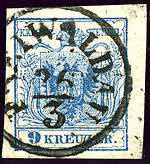
The compromise of 1867 marked a recognition of the need for bilingualism in areas where an important portion of the population used another language; the procedure was imposed by official instructions in 1871.[3]
In the 3 provinces which now are part of the Czech Republic, the languages used were (around 1900):[1]
- Bohemia: Czech (63%), German (37%)
- Moravia: Czech (70%), German (29%)
- Austrian Silesia: Czech (22%), German (48%), Polish (30%).
It may thus be more appropriate to state that German names were all official endonyms.
As illustrated by the name of post-offices, many towns and villages received a dual name after 1867, except— as stated —in the area where a clear majority of the population spoke German, namely the Sudetenland. The images of German cancellations with a label Endonym in ... are for places where the official (post-office) name was not bilingual in 1900.[1]
After the Beneš decrees in 1945, Czech names became the rule. Sometimes, Czech place names had to be coined from scratch, there was no traditional Czech/Slavic name for some places.
Sublists sorted by the Czech name, for the 14 regions
The 14 Regions of the Czech Republic are coded as created in the administrative reform Law in 2000:

Historical Crownland Bohemia
Prag Region (Code A)
- Prague
- Karlín - Karolinenthal B,32
- Vinohrady - Königliche Weinberge B,39
- Smíchov - Smichov B,82
- Žižkov - Zizkov B,94
Southern Bohemia (Code C)
- Southern Bohemia
The following 13 Austrian monarchy Bezirkshauptmannschaften existed in 1900, most in Bohemia, from which the list can be checked and completed:[4]
- Blatná (Strakonice District) - Blatna - Blatna B,5
- České Budějovice District - Budweis B,10
- Kaplice (Český Krumlov District) - Kaplitz B,30
- Český Krumlov District - Krumau B,41
- Týn nad Vltavou (České Budějovice District) - Moldauthein B,51
- Milevsko (Písek District) - Mühlhausen B,52
- Jindřichův Hradec District - Neuhaus B,56
- Písek District - Pisek B,61
- Prachatice District - Prachatitz B,66
- Strakonice District - Strakonitz B,84
- Tábor District - Tabor B,85
- Třeboň (Jindrichuv Hradec District) - Wittingau B,93
- Dačice (Jindrichuv Hradec District) - Datschitz M,4
Pardubice Region (Code E)
- Pardubice
The following 8 Austrian monarchy Bezirkshauptmannschaften existed in 1900, most in Bohemia, from which the list can be checked and completed:[4]
- Chrudim District - Chrudim B,12
- Vysoké Mýto (Ústí nad Orlicí District) - Hohenmauth B,24
- Lanškroun (Ústí nad Orlicí District) - Landskron B,43
- Litomyšl (Svitavy District) - Leitomischl B,47
- Pardubice District - Pardubitz B,58
- Polička (Svitavy District) - Politschka B,65
- Žamberk (Ústí nad Orlicí District) - Senftenberg B,81
- Moravská Třebová (Svitavy District) - Mährisch Trübau M,16
Hradec Kralové Region (code H)
- Hradec Králové/Königgrätz
The following 9 Austrian monarchy Bezirkshauptmannschaften existed in 1900, all in Bohemia:
- Broumov (Náchod District) - Braunau B,8
- Vrchlabí (Troutnov District) - Hohenelbe B,23
- Jičín District - Gitschin B,26
- Hradec Králové District - Königgrätz B,37
- Náchod District - Nachod B,54
- Nový Bydžov (Hradec Králové District) - Neu-Bydzov B,55
- Nové Město nad Metují (Náchod District) - Neustadt an der Mettau B,57
- Rychnov nad Kněžnou District - Reichenau B,71
- Trutnov District - Trautenau B,91
Karlovy Vary Region (code K)
See the list Karlovy Vary/Karlsbad
The following 8 Austrian monarchy Bezirkshauptmannschaften existed in 1900, in the Bohemia province, from which the list can be checked and completed:
- Aš (Cheb District) - Asch B,1
- Cheb District - Eger B,17
- Sokolov District - Falkenau B,18
- Kraslice (Sokolov District) - Graslitz B,22
- Jáchymov (Karlovy Vary District) - Joachimsthal B,27
- Karlovy Vary District - Karlsbad B,31
- Žlutice (Karlovy Vary District) - Luditz B,48
- Teplá (Cheb District) - Tepl B,88
Liberec Region (Code L)
- Liberec/Reichenberg
- Česká Lípa District - Böhmisch-Leipa B,7
- Dubá (Ceská Lípa District) - Dauba B,14
- Frýdlant (Liberec District) - Friedland B,19
- Jablonné v Podještědí (Liberec District) - Gabel bei Niemes B,20
- Jablonec nad Nisou District - Gablonz B,21
- Liberec District - Reichenberg B,72
- Semily District - Semil B,80
- Jilemnice (Semily District) - Starkenbach B,83
- Turnov (Semily District) - Turnau B,92
Plzen Region (Code P)
Readers searching for the current name of the former village of Schneiderhof should be cautioned that the reference to Mysliv can be misleading. Germans were expelled from Schneiderhof after World War II and the village was briefly resettled by Czechs and apparently was then called Mysliv for a brief time. Later the Czechs were forced out and the village was destroyed for "border zone security concerns". Neither village, Schneiderhof or Mysliv, exists today at that location (1.5 km west-northwest of Vseruby u Kdyne). However, there does exist today a village named Mysliv which is 43 km east-northeast of Vseruby u Kdyne; this village is not the location of the former Schneiderhof.
- Horšovský Týn (Domažlice District) - Bischofteinitz B,4
- Klatovy District - Klattau B,34
- Kralovice (Plzen-North District) - Kralowitz B,40
- Stříbro (Tachov District) - Mies B,50
- Plzen-City District - Pilsen B,60
- Planá (Tachov District) (Tachov District) - Plan B,62
- Přeštice (Plzen-South District) - Prestitz B,67
- Rokycany District - Rokycany B,73
- Sušice (Klatovy District) - Schüttenhofen B,78
- Tachov District - Tachau B,86
- Domažlice District - Taus B,87
Central Bohemia (Code S)
- Central Bohemia
The following Austrian monarchy 16 Bezirkshauptmannschaften existed in 1900, from which the list can be checked and completed:
- Benešov District - Beneschau B,3
- Ceský Brod (Kolin District) - Böhmisch-Brod B,6
- Cáslav (Kutná Hora District)- Caslau B,13
- Horovice (Beroun District)- Horowitz B,25
- Mladá Boleslav District - Jungbunzlau B,28
- Kladno District - Kladno B,33
- Kolín District - Kolin B,35
- Králův Dvůr (Beroun District) - Königinhof B,38
- Kutná Hora District - Kuttenberg B,42
- Mělník District - Melnik B,49
- Mnichovo Hradiště (Mladá Boleslav District) - Münchengrätz B,53
- Podebrady (Nymburk District) - Podebrad B,63
- Příbram District - Pribram B,68
- Rakovník District - Rakonitz B,68
- Slaný (Kladno District) - Schlan B,76
- Sedlcany (Príbram District) - Selcan B,79
Ústí Region (Code U)
- Ústí/Aussig
- Ústí nad Labem District - Aussig B,2
- Most District - Brüx B,9
- Duchcov (Teplice District) - Dux B,16
- Kadan (Chomutov District) - Kaaden B,29
- Chomutov District - Komotau B,36
- Louny District - Laun B,44
- Litomerice District - Leitmeritz B,46
- Podborany (Louny District) - Podersam B,64
- Roudnice nad Labem (Litomerice District) - Raudnitz B,70
- Rumburk (Decín District) - Rumburg B,74
- Žatec (Louny District) - Saaz B,75
- Šluknov (Děčín District) - Schluckenau B,77
- Teplice District - Teplitz B,89
- Děčín District - Tetschen B,90
Historical crownland Moravia
Olomouc Region (code M)
- Olomouc
The following Austrian monarchy 9 Bezirkshauptmannschaften existed in 1900, from which the list can be checked and completed:
- Zábřeh - Hohenstadt (M,8)
- Litovel - Littau (M,13)
- Olomouc - Olmütz (M,21)
- Přerov - Prerau (M,22)
- Prostějov - Prossnitz (M,23)
- Šumperk - Schönberg (M,25)
- Šternberk - Sternberg (M,26)
- Hranice (Přerov District) - Weisskirchen (M,32)
- Jesenik - Freiwaldau (S,3)[5]
Southern Moravia (code B)
- Southern Moravia
The following 9 Austrian monarchy Bezirkshauptmannschaften existed in 1900, from which the list can be checked and completed:
- Hustopeče - Auspitz (M,1)
- Boskovice - Boskowitz (M,2)
- Brno - Brünn (M,3)
- Kyjov - Gaya (M,5)
- Hodonin - Göding (M,6)
- Moravský Krumlov - (Märisch) Kromau (M,12)
- Mikulov - Nikolsburg (M,20)
- Vyškov - Wischau (M,33)
- Znojmo - Znaim (M,34)
Moravia-Silesia (code T)
- Moravian Silesia
The following 4 Austrian monarchy Bezirkshauptmannschaften existed in 1900, in the province Moravia, from which the list can be checked and completed:
- Ostrava - Mährisch Ostrau (M,15)
- Frýdek-Místek - Mistek (M,17)
- Nový Jičín - Neutitschein (M,19)
- Rýmařov - Römerstadt (M,24)
The following 6 Austrian monarchy Bezirkshauptmannschaften existed in 1900, in the province Austrian Silesia, from which the list can be checked and completed:
- Fryštát - Freistadt (S,2)
- Bruntál - Freudenthal (S,4)
- Krnov - Jägerndorf (S,5)
- Český Těšín -Teschen (S,6)
- Opava - Troppau (S,7)
- Bílovec - Wagstadt (S,8).
Curiously, Jesenik - Freiwaldau (S,3) is now in the Olomouc region. The list
seems to correspond to the Teschen district.
Zlín Region (code Z)
- Zlín
The 6 districts in 1900:
- Holešov - Holleschau (M,9)
- Kroměříž - Kremsier (M,11)
- Uherský Brod - Ungarisch Brod (M,29)
- Uherské Hradiště - Ungarisch Hradisch (M,30)
- Zlín - Zlin (M,30)
- Valašské Meziříčí - Wall. Meseritsch (M,31)
Vysočina Region (code J)
- Vysočina
This region (as created in the administrative reform Law in 2000) covers parts of historical provinces Bohemia and Moravia. The following 9 Austrian monarchy Bezirkshauptmannschaften existed in 1900, from which the list can be checked and completed:
- Chotěboř - Choteborz (B,11)
- Havlíčkův Brod - Deutschbrod (B,15)
- Ledeč nad Sázavou - Ledetsch (B,45)
- Pelhřimov - Pilgram (B,59)
- Velké Meziříčí - Gross Meseritsch (M,07)
- Jihlava - Iglau (M,10)
- Moravské Budějovice - Mährisch Budwitz (M,14)
- Nové Město na Moravě - Mährisch Neustadtl (M,18)
- Třebíč - Trebitsch (M,28)
German names alphabetically sorted
A
- Aag: Doubí (part of Třebeň) B,17?
- Aarhorst (mountain): Varhošť
- Abaschin: Zádub-Závišín
- Abdank (abandoned village in Kienberg bei Hohenfurth): Adámky (part of Loučovice) B,30
- Abertham: Abertamy B,27
- Abtsroth: Opatov
- Abtsdorf bei Zwittau: w:de:Opatov v Čechách B,47
- Adamsberg (mountain): Adamova hora
- Adamsfreiheit: Hůrky u Nové Bystřice
- Adamstadt: Adamov
- Adamsthal bei Brünn: Adamov M,3
- Adamsthal (Riesengebirge): Adamov
- Adamsthal bei Würbenthal: Adamov
- Adelsdorf: Adolfovice
- Adersbach: Adršpach B,8
- Adersbacher Felsen: Adršpašské skály
- Adlerdörfel: Orličky
- Adlerhütte: Samoty (Adlerova Huť, Röhrenberská Huť)
- Adlerkosteletz: Kostelec nad Orlicí (Rychnov nad Knežnou District) B,71
- Admannsdorf: Adamov
- Adolfsgrün: Adolfov
- Ahorn: Kladné (Záhorkov)
- Ahornhütte: Javory
- Ahornsäge: Javoří pila
- Ahornswald: Javořina
- Ahrendorf: Pavlov
- Aich bei Karlsbad: Doubí B,31
- Aichen: Horní Sukolom
- Ainsersdorf: Jednov (Bezirk Moravia 13)

- Albendorf: Bělá u Jevíčka
- Alberitz: Malměřice
- Albernhof: Alberov
- Albersdorf: Píšařova Vesce
- Albersdörfer Brand: Milíře
- Albrechtsberg: Albrechtovice
- Albrechtitz: Albrechtice (Ústí nad Orlicí District) B,58
- Albrechtsschlag: Albrechtovice
- Albrechtsdorf: Albrechtice v Jizerských horách B,21
- Alenkowitz: Halenkovice M,30
- Alfredshof: Alfrédov
- Algersdorf: Valkeřice
- Aloisdorf: Alojzov
- Alt Albenreuth: Starý Albenreuth
- Alt Benatek: Stare Benatkty Benátky nad Jizerou B,28
- Alt-Biela bei Paskau M,15
- Alt Bielitz Silesia,1
- Alt Bunzlau Stara Boleslav B,32
- Alt-Ehrenberg, Ehrenberg: Starý Ehrenberg B,77
- Alt-Grammatin: Mutěnín
- Alt Harzdorf: Starý Harcdorf B,72
- Alt-Hrosinkau (earlier: Hrosinkau): ? M,29
- Alt-Karlsthal: S,4
- Alt-Kammer: Stará Komora
- Alt Kinsberg: Starý Kinšperk
- Alt-Kolin: Starý-Kolin B,35
- Alt-Langendorf (Langendorf) (bei Schüttenhofen): Janovice, Dlouhá Ves Stara B,78
- Alt-Langwasser: Nová Dlouhá Voda
- Alt-Moletein: Starý Moletín M,8
- Alt Ossegg: Osek
- Alt Paka: Stará Paka B,26
- Alt Parisau: Starý Pařezov
- Alt Paulsdorf: Staré Pavlovice
- Alt Petrein: Starý Petřín
- Alt Pocher: Starý Pochr
- Alt Prachatitz: Staré Prachatice
- Alt Prennet: Starý Spálenec
- Alt Reisch: Stará Ríše M,4
- Alt Rognitz: Starý Rokytník
- Alt-Rohlau: Stará Role B,31
- Alt-Rothwasser: Stará Červená Voda S,3
- Alt-Schallersdorf: M,34
- Alt-Sedlowitz: Starý Sedloňov
- Alt Spitzenberg: Nový Špičák
- Alt Steindorf: Stary Hubenov B,15
- Alt Tabor: Sezimovo Ústí
- Alt Thein: Starý Týn
- Alt Vogelseifen: Starý Vogelzejf S,4
- Alt Wiklantitz: Stare Vyklantice B,59
- Alt Wohnischtan: Stare Ohnistany B,55
- Alt-Zechsdorf: Staré Těchanovice
- Alt Zedlisch, Alt-Zedlischt: Staré Sedliště B,16
- Altbrunst: Starý Brunst
- Altbunzlau: Stará Boleslav
- Altdorf: Stará Ves
- Altendorf (Kreis Bärn): Staré Oldrůvky
- Altenberg: Starý Kopec
- Altenbuch bei Trautenau: Staré Buky B,91
- Altenburg: Staré Hrady
- Altendorf b. Römerstadt, Altendorf: Stará Ves M,24
- Altendorf b. Braunsberg: Stará Ves nad Ondřejnicí
- Altendorf b. Hochstadt: Stará Ves u Vysokého nad Jizerou
- Altendorf b. Stadt Liebau: Staré Oldřůvky
- Altengrün: Dolní Nivy
- Altenteich: Starý Rybník
- Altfürstenhütte: Stará Knížecí Huť
- Altglashütten: Stará Sklárna
- Althabendorf (Alt-Habendorf): Stráž nad Nisou (earlier also: Starý Habendorf) B,72
- Althammer in Schlesien: Staré Hamry w Slezcku S,6

- Althart: Staré Hobzí M,14
- Althütten: Staré Hutě part of Horní Stropnice B,30
- Althütten (near Neubistritz): Stará Huť B,25
- Althütten: Miletínky
- Althütten: Muhlberg
- Altkinsberg: Starý Hroznatov
- Altlangendorf: Dlouhá Ves
- Altleipa: Stará Lípa
- Altliebe (Kreis Bärn): Stará Libavá
- Altoderberg: Starý Bohumín
- Altpaka: Stará Paka
- Altpocher: Stoupa
- Altrohlau: Stará Role (now part of Karlovy Vary)
- Altsattel b. Pfraumberg: Staré Sedlo u Tachova
- Altsattl b. Elbogen: Staré Sedlo u Sokolova
- Altspitzenberg: Starý Špičák also Starý Spitzenberg
- Altstadt bei Freudenthal: Staré Město u Bruntálu S,4
- Altstadt bei Mährisch Trübau: Staré Město u Moravské Třebové
- Altstadt bei Neubistritz: Staré Město u Nové Bystřice
- Altstadt bei Neuhaus in Böhmen: Staré Město u Jindřichova B,56
- Altstadt bei Neuhaus: Staré Město pod Landštejnem
- Altstadt bei Ungarisch Hradisch: Staré Mesto (Uherské Hradište District) (Staré Mesto u Uherského Hradište) M,30
- Alttitschein (Alt-Titschein): Starý Jičín M,19
- Altvatergebirge (mountain): Hrubý Jeseník (Jeseníky)
- Altvater Steinige Höhe: Praděd
- Altwasser (Kreis Bärn): Stará Voda
- Amonsgrün: Úbočí (now part of Dolní Žandov)
- Amplatz: Oplotec
- Amschelberg: Kosova Hora B,79
- Andersdorf bei Bärn in Mähren: Ondrášov na Moravě M,26
- Andersdorf: Ondřejov
- Andreasberg: Ondřejov u Kaplice
- Angel (river): Úhlava
- Angern: Bujanov
- Anischau: Úněšov
- Annaberg: Anín
- Annadorf: Anenská Ves
- Annapolier: Anenské Leštírny
- Annathal: Annín
- Antiegelhof: Antygl
- Antoniendorf: Cihelna
- Antoniwald: Antonínov
- Antoschowitz: Antošovice
- Arbesau: Varvažov
- Archlebau: Archlebov M,5
- Arletzgrün: Arnoldov
- Arnau (an der Elbe): Hostinné B,23
- Arnetzgrün (Arnitzgrün): Arnoltov
- Arnsdorf (b. Friedland): Arnoltice
- Arnsdorf (b. Haida): Arnultovice u Nového Boru
- Arnsdorf bei Tetschen (Böhmische Schweiz): Arnoltice u Děčína B,90
- Arnsdorf: Arnultovice (Ústí nad Labem / Frýdlant / Vrchlabí / Hostinné)
- Asang: Jasánky
- Asch: Aš B,1
- Aschendorf: Okřešice
- Attes: Zates
- Au: Ava
- Aucin: Ujčín
- Augezd bei Mährisch Neustadt (bei Brünn): Újezd u Uničova M,13
- Auhertschitz: Úherčice
- Auhertz (Auherzen): Úherce
- Aujestel: Újezdec
- Aujezd ob der Mies: Újezd nad Mží
- Aujezd bei Luhatschowitz: M,29
- Aumonin: Oumonin B,42
- Auperschin (an der Biela): Úpořiny nad Bílinou
- Auras: Úraz
- Aurinowes (Aurschinewes): Praha-Uhríneves Prague 22 B,94
- Auscha: Úštěk B,46
- Auschitz: Úžice, Mělník (Oužice) B,76
- Auschowitz: Úšovice
- Ausowy: see Pollerskirchen
- Auspitz: Hustopeče M,1
- Aussee (Mährisch-Aussee): Úsov M,8
- Aussergefild: Kvilda B,66
- Aussig (an der Elbe): Ústí nad Labem B,2
- Austerlitz: Slavkov u Brna M,33
- Autschowa: Ohučov, part of Staňkov (Domažlice District) B,4
- Auwal: Úvaly u Prahy (Ouvaly) B,6
B
- Babilon: Babylon (Domažlice District)
- Babtschitz: Babčice
- Baby: Babí B,57
- Bachelsdorf: Bechlejovice (part of Decín XXVI
- Backofen: see Bakow an der Iser
- Bad Bochdanetsch: see Bohdanetsch bei Pardubitz B,58
- Bad Geltschberg, Geltschbad: Lázně Jeleč
- Bad Karlsbrunn: Karlova Studánka
- Bad Königswart: see Königswart B,62
- Bad Liebwerda: Lázně Libverda
- Bad Lindewiese: Lipová-lázně
- Bad Neudorf bei Mies: to be identified B,88
- Bad Sternberg in Böhmen| Lázně Šternberk v Cechach B,76
- Bad Wartenberg: Sedmihorske Lázně B,92
- Bad Wurzelsdorf: see Unter Wurzelsdorf B,21
- Baderwinkel: Pomezná
- Badstübl: Podstely
- Bäckenhain: Pekařka
- Bärenklau: Bezvěrov
- Bärn: Moravský Beroun M,26
- Bärnsdorf bei Friedland in Böhmen (Berzdorf?): to be identified B,19
- Bärnsdorf über Neutitschein: Bernartice na Moravě or Bernartice nad Odrou B,19??
- Bärnwald: Banvalt Neratov B,81
- Bärringen: Pernink
- (Burg) Baiereck (ruins): Pajrek above Nýrsko
- Bakow an der Iser (earlier: Backofen): Bakov nad Jicerou B,53
- Balklhota: Balkova Lhota
- Balzhütte: Na Tokání
- Banow: Bánov (Uherské Hradiště District) M,29
- Banowitz: Báňovice
- Barau: Bavorov B,61
- Barchowek: Barchůvek
- Barchowitz: Barchovice
- Bartelsdorf: Bartovice, also Dřínov
- Bartelsdorf bei Görkau: Bartultovice u Jílové
- Barzdorf bei Braunau: Božanov
- Barzdorf bei Jauernig: Bernartice u Javorníka (Silesia, 3)
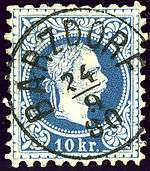
- Barzdorf am Rollberge (bei Braunau?): Pertoltice pod Ralskem B,8?
- Basberg: Hora Svatého Šebastiána
- Baschka: Baška (Frýdek-Místek District) S,6
- Baschten: Holubovská Bašta
- Batschetin: Bačetín
- Battelau: Batelov M,10
- Batzdorf (Adlergebirge): Bartošovice v Orlických horách B,81
- Batzdorf bei Röwersdorf: Bartultovice S,5
- Bauschenhof: Pouchov
- Bauschowitz an der Eger: Bohušovice nad Ohří B,46
- Baussnitz: Bohuslavice nad Úpou
- Bautsch (Kreis Bärn): Budišov nad Budišovkou M,26
- Bayerhof: Bajerov
- Bechin oder Beching: Bechyně B,52
- Becwar: Becváry B,35
- Bedihoscht: Bedihošt M,23
- Bejscht (also: Beyscht): Býšť B,58
- Bela: Česká Bĕlá u Havlíčkova Brodu or Rohovládová Bělá u Pardubic
- Belec ? Beletsch??: Běleč (to be confirmed)
- Belecska Lhota: Bělečská Lhota
- Benatek an der Iser, Neu-Benatek: Benátky nad Jizerou
- Beneschau (Schlesien): Dolní Benešov
- Beneschau (earlier also: Beneschau bei Prag, Deutschbeneschau in Böhmen): Benešov u Prahy B,3
- Beneschau b. Mies: Benešovice
- Beneschau (near Ratibor): Benešov u Hlučína
- Benetschlag: Blato
- Benhof: Benovy, also Benov
- Benisch Bennisch: Benešov u Bruntálu
- Bennisch: Horní Benešov S,4

- Bensen: Benešov nad Ploučnicí B,90
- Beraun: Beroun B,25
- Berg bei Ronsperg: Hora Svatého Václava
- Berg: Horka
- Bergersdorf: Kamenná (Jihlava District)
- Bergesgrün über Brüx: Chudeřín
- Berggraben: Vrchová
- Berghäusel: Na Vrchu
- Bergjanowitz: Vrchotovy Janovice
- Bergles: Bražec
- Bergreichenstein: Kašperské Hory B,78
- Bergstadt: Horní Město M,24
- Bergstadt Platten: Horní Blatná
- Bergstadtl: Hory Matky Boží, also Drouhavec
- Bergstadtl-Ratiboritz: Hory Ratibořské B,85
- Berlau, Berloch: Brloh
- Bernarditz bei Tabor: Bernartice B,52
- Bernau : Bernov
- Bernetzreith: Pernolec
- Bernhau: Olověná
- Bernhau (Kreis Bärn): Barnov
- Bernklau: Bezvěrov
- Bernsdorf (in Böhmen, bei Trautenau): Bernartice (Trutnov District) (Bernartice u Trutnova) B,91
- Bernsdorf: Horní Řasnice (pod Smrkem)
- Berzdorf: Karlov pod Ještědem
- Berzdorf bei Friedland: Pertoltice u Frýdlantu
- Beschin: Běšiny B,34
- Besdieditz (Besdietitz): Bezdědice
- Beseditz: Besedice
- Besikau: Bezděkov
- Beskiden (mtn range): Beskydy
- Bessenitz: Bezednice (earlier Besednice) B,10
- Bestwin: Běstvina B,11
- Bettlern: Žebrák (Beroun District)
- Bezdek: Bezděk
- Bezdekau: Bezděkov (Klatovy District) B,34
- Biechowitz: Běchovice now Prague 21 B,94
- Biechtschin (Biechzin): Běštín
- Biela: Decín X - Belá , before 1948)
- Biela (Biella): Česká Bĕlá (Havlíckuv Brod)
- Biela (Biella): Rohovládová Bĕlá (Pardubice)
- Biela bei Bodenbach: to be identified B,90 (near Dečin)
- Biela bei Deutschbrod: (Bĕlá u Nemeckeho Brodu), Belá u Horní Cerekve B,15
- Biela bei Prelautsch: Bĕlá u Prelouce, Bělá (Pelhřimov District) B,58
- Bielau: Bělá ve Slezsku, also Bilov Belá (Opava District)
- Bielenz: Bílence
- Bielohrad (Bad Bielohrad): Lázně Bělohrad
- Bieloschitz: Bělušice
- Bieltschitz| Belčice B,5
- Bierbruck (also: Bierbrücke) (near Christelschlag): Můstek
- Bieschin: Běšiny
- Bieschtin: Běštín
- Bilin: Bílina B,16
- Billentz: see Bielenz
- Billowitz bei Kostel: Bilovice u Podivina M,6
- Bilowitz bei Ungarisch Hradisch: to be identified M,30
- Binaberg: Vinná
- Binsdorf bei Bodenbach: Bynovec
- Birkau: Březí u Cachrova
- Birkenberg: Březové Hory (part of Příbram) B,68
- Birkenhaid: Březová Lada
- Birkigt: Decín XXVII - Březiny
- Birkigt-Bodisch: Březová-Bohdašín B,8
- Birndorf: Hrušková
- Bischitz: Byšice B,49
- Bischofteinitz: Horšovský Týn B,4
- Bisenz: Bzenec M,30
- Biskupitz: Biskupice (Prostějov District) M,12
- Bisterz: Brno-Bystrc M,3
- Bistrai in Schlesien: Bystra v Slazku S,1
- Bistrau: Bystré (Svitavy District) (earlier Bystra) B,65
- Bistritz: Bystřice u Benešova
- Bistritz an der Angel: Bystřice nad Úhlavou B,3??
- Bistritz am Hostein: Bystřice pod Hostýnem M,9
- Bistritz in Schlesien: Bystrzyca S,6
- Bistritz ob Pernstein: Bystřice nad Pernštejnem
- Bitouchow: Bítouchov
- Blanz: Blansko M,2
- Blaschim (also Plaschin): Blažim (Plzeň-North District) near Bezdružice[6]
- Blaschkau: Blažkov
- Blaschke: Vlaské
- Blatna: Blatná B,5
- Blattnitz Blatnitz: Blatnice
- Blauda: Bludov M,25
- Blauendorf: Bludovice (to be confirmed)
- Blauenschlag: Blažejov B,56
- Bleistadt: Oloví B,18
- Bleiswedel: Blíževedly
- Blisowa: Blížejov B,4

- Blosdorf bei Mährisch Trubau: Mladějov na Moravě
- Blottendorf: Jedličná B,7
- Blowitz (Blobitz): Blovice B,60
- Bludau: Bludov
- Blumenau: Plumlov
- Blumenau (bei Zwittau): Květná
- Bobov: Bobov (to be confirmed)
- Bobrau in Mähren (earlier Ober Brobau): Bobrava (earlier Horni Bobrova, Bobrova u Morave) M,18
- Bobrownik: Bobrovníky
- Bochlowitz: Pochlovice
- Bockhütte, zu Kaltenbach: Pokovy Hutě (Pukov)
- Bodenbach: Podmokly (part of Děčín IV) B,90
- Bodenbach (Rosawitz): Rozbělesy (part of Děčín V) B,90
- Bodenstadt (Kreis Bärn): Potštát M,32?
- Bodisch: Bohdašín
- Böhmdorf (part of Gratzen): Bynov (Dolní Brzotice (?)) B,30
- Böhmerwald (forest region): Šumava
- Böhmisch Aicha: Český Dub B,92
- Bohmisch Bela: Česká Bĕlá
- Böhmisch Bokau: Český Bukov
- Böhmisch Brod: Český Brod B,6
- Böhmisch Domaschlag: Česká Domaslav
- Böhmischdorf: Česká Ves
- Böhmisch Einsiedl: Mníšek v Krušných horách (now part of Nová Ves v Horách) B,9
- Böhmisch Eisenstein (Markt Eisenstein): see Eisenstein
- Böhmisch Gilowitz: Horní Jílovice
- Böhmisch Haidl: Maňávka, also Česká Maňava
- Böhmisch Hammer: České Hamry
- Böhmischhäuser: České Chalupy
- Böhmisch Kahn (Kahn über Bodenbach): České Chvojno B,2
- Böhmisch Kamnitz: Česká Kamenice
- Böhmisch Killmes: Český Chloumek
- Böhmisch Kopist: České Kopisty
- Böhmisch Krummau: see Krumau
- Böhmisch Kubitzen: Česká Kubice B,87
- Böhmisch Leipa: Česká Lípa B,7

- Böhmisch Liebau: Dolní Libina
- Böhmisch Lotschnau: Český Lačnov
- Böhmisch Märzdorf (Märzdorf-Nikles): Raškov (part of Bohdíkov) M,25
- Böhmisch Matha: Dědová
- Böhmisch Müglitz: Mohelnice
- Böhmisch Mühle: Český Mlýn
- Böhmisch Neudörfel: Český Ujezd
- Böhmisch Neustadtl: Dolní Bělá B,40?
- Böhmisch Petersdorf: Petrovice (Jablonné v Podještědí) B,91
- Böhmisch Röhren: České Žleby B,66
- Böhmisch Rothmühl: Česká Radiměř
- Böhmisch Rothwasser: Horní Čermná B,43
- Böhmisch Rudoletz in Mähren (sic): Český Rudolec M,4
- Böhmisch Rust: Kadaňský Rohozec
- Böhmisch Skalitz: Česká Skalice B,54
- Böhmisch Sternberg: Český Šternberk
- Böhmisch Trübau: Česká Třebová B,43
- Böhmisch Weigsdorf: Višňová
- Böhmisch Wiesen: Česká Dlouhá
- Böhmisch Wiesenthal: Loučná pod Klínovcem B,27
- Böhmisch Zlatnik (Schladnik an der Biela, Böhmisch-Schladnig): Český Zlatník
- Böhmische Lichwe: České Libchavy
- Böhmische Rybna: Česká Rybná
- Bölten (earlier Pölter): Bělotín M,32
- Bömisch Haidl: Zhůří
- Bössig (mountain): Bezděz
- Bogumin: Bohumín
- Bohaunowitz: Bohouňovice II
- Bohdalau: Bohdalov M,18
- Bohdalice: Bohdalitz M,33
- Bohdanetsch bei Ledetsch: Bohdanec (u Ledce) B,45
- Bohdanetsch bei Pardubitz: Lázne Bohdanec (Bohdanec u Pardubic, until 1980 Bohdanec) B,58
- Bohentsch: Knínice (to be confirmed)
- Bohnau: Banín
- Bohuslawitz (bei Konitz): Bohuslavice u Zlína (earlier: Bohuslavice u Kounice) M,13
- Bohuslawitz (in Böhmen): Bohuslavice (Náchod District) B,57
- Bojkowitz (earlier: Boikowitz): Bojkovice M,29
- Bokau über Aussig (Pokau über Aussig): Bukov u Ústí nad Labem
- Bolatitz (near Ratibor): Bolatice
- Bolehoscht: Bolehošt B,57
- Bolehradice: Boleradice
- Bonaventura: Skleněné Hutě, also Sklená Huť
- Boniowitz: Bohunovice M,26
- Borau: (earlier: Borova) Borek (Havlíčkův Brod District) B,11 (to be confirmed)
- Borek: Jirkov does not seem correct
- Boreschnitz: Borečnice [7]
- Boreslau: Bořislav
- Borice: Bořice
- Borohradek (Heideburg): Borohrádek B,71
- Borotin: to be identified B,79
- Borotitz: Borotice (Příbram District) B,68
- Borowa bei Policka: Borová (Svitavy District) (earlier Borowa u Policky) B,65
- Borownitz: Borovnice (Žďár nad Sázavou District) M,18
- Borschau: Boršov (near Jihlava)
- Borschengrün: Úbočí
- Boschau: Bošov
- Boschowitz: Bošovice M,1
- Bosenitz: Tvarožná) M,3
- Bosin: Boseň
- Boskowitz: Boskovice M,2
- Botenwald (Landkreis Wagstadt): (Butovice) Trnávka (Nový Jičín District) M,19
- Bozejow: Božejov B,59
- Brand: Paseka (abandoned village, within Deštné v Orlických horách)
- Brand (Tachauer Brand, Albersdörfer Brand, Brand I): Milíře
- Brand b. St. Katharinen: Milíře
- Brand (Planer Brand, Brand II): Žďár u Tachova
- Brand a.d. Adler: Žďár nad Orlicí
- Brand a.d. Mettau: Žďár nad Metují
- Brandau (in Böhmen): Brandov B,9
- Brandeis an der Adler: Brandýs nad Orlicí B,24
- Brandeis an der Elbe: Brandýs nad Labem B,32
- Brandeisl: Brandýsek B,76
- Brandhof: Spálený dvůr
- Brandschau: Branišov
- Brandzeif: Ždárský Potok
- Branek: Branky M,31
- Branickau: Braničkov
- Branik: Braník B,39
- Branisov: Branišov
- Brankowitz: Brankovice M,33
- Branna: to be identified B,83
- Branowitz: Vranovice M,1
- Bransdorf (near Jägerndorf): Brantice S,5
- Brany: Braňany
- Bras: Brasy B,73
- Bratelsbrunn (in Mähren) (Pratelsbrunn, Pratlsbrun): Březí (Břeclav District) M,20
- Bratrikow: Bratříkov
- Bratschitz bei Tschaslau: Bratčice
- Brättersdorf: Bratříkovice
- Braunau (in Böhmen): Broumov B,8
- Braunau: see Frain (to be confirmed)
- Braunau-Oelberg: Broumov-Olivětín B,8
- Braunöhlhütten: to be identified M,16
- Braunbusch, Braunpusch: Prapořiště
- Braunsberg: Brušperk M,17
- Braunsdorf: Brumovice ve Slezsku, also Brumovice u Opavy S,5
- Braunseifen: Rýžoviště M,24
- Breitenau (near Freudenthal): Bretnová Široká Niva S,4
- Breitenbach: Potůčky B,27
- Breitenfurt (near Freiwaldau): Široký Brod Hradec
- Brenn (Brenna): Brenná S,1
- Brennet: Prennet
- Brennetberg (mountain): Prenet
- Brennporitschen: Spálené Poříčí B,60
- Brenntenberg: Spálenec
- Brennter Berg (mountain): Spálený
- Bresnitz (Breznitz): Březnice B,5
- Bretterschlag (Mährische Schweiz): Ostrov u Macochy
- Bretterschlag (Böhmerwald): Petřejov
- Brettmühl: Pila
- Brezno: B,28
- Brezolup: Brezolupy M,30
- Brezowitz bei Prossnitz: Brezwitz M,33
- Bries: Březí u Týna nad Vltavou
- Briesau (über Troppau): Březová ve Slezsku, also Březová u Vítkova S,7
- Briesen: Bílina Kyselka, also Březina
- Brims (Brins): Brniště B,20
- Brodek: to be identified M,22
- Broden: Bradné
- Brodetz: Brodce B,28
- Brösau: Březová u Sokolova
- Brosan: Brožany
- Brosdorf: Bravantice S,8
- Brozan: Brozany B,70
- Bruch: Lom (Most District) (earlier: Lom u Mostu) B,16
- Bruck am Hammer: Brod nad Tichou
- Brückelberg (mountain): Můstek
- Brünn: Brno M,-
- Brünnersteig: Brlenka
- Brünnl: Dobrá Voda u Horní Stropnice part of Horní Stropnice B,30
- Brünnl: Dobrá Voda u Nových Hradů B,30?
- Brünnles über Hohenstadt: Brníčko
- Brünnlitz: Brněnec B,65

- Brüsau: Březová nad Svitavou M,16
- Brüx: Most B,9
- Brumow: Brumov M,29
- Brunn (Nitzau): Studenec
- Brunnersdorf: Prunéřov B,29
- Bschas: Břasy
- Bubenc (earlier: Bubencz): B,82
- Bubna: Bubny
- Bucharten: Dobrá Voda
- Buchau: Bochov (B,48)

- Buchberg: Bukovec
- Buchbergsthal: Železná ve Slezsku
- Buchelsdorf: Bukovice
- Buchen: Buk (Prachatice District)
- Buchen: Buk (Přerov District)
- Buchers: Pucher B,30
- Buchlowitz: Buchlovice M,30
- Buchwald: Bučina
- Buchwaldsdorf: Bučnice
- Buda: Budov
- Budaschitz: Bohdašice
- Budigsdorf (über Hohenstadt): Krasíkov M,8
- Budin (a.d. Eger): Budyně nad Ohří B,70
- Budischau: Budišov M,28
- Budischkowitz: Budíškovice
- Budkau: Budkov (Třebíč District) M,14
- Budnian (earlier: Budnian-Karlstein): Budnany B,25
- Budweis, Böhmisch-Budweis: České Budějovice B,10
- Budwitz: see Mährisch Budwitz M,14
- Bühlending: Bíletín
- Bünauburg: Bynov (now, since 1948, part of Děčín IX) B,90
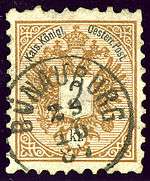
- Bürgel: Hrádek
- Bürgleins am Wlarapass: Hrádek na Vlárské dráze
- Bürgstein: Sloup v Čechách B,7
- Bürles: Brložec
- Bukowitz: Bukovice M,8
- Bukowka: Bukovka
- Bukwa: Bukovany (Sokolov District)
- Bullendorf über Friedland: Bulovka
- Bunzendorf: also Boleslav (part of Černousy)
- Burgstadtl: Hradec u Kadaně
- Burgstall: Hradiště
- Burgwiese: Burgviz
- Busau: Bouzov M,13
- Buschtiehrad: Buštěhrad B,33
- Buschullersdorf: Oldřichov v Hájích B,19
- Busk: Boubská
- Buslawitz (near Ratibor): Buslavice
- Butsch: Budeč (Jindřichův Hradec District) M,4
- Butschafka: Bučavka
- Butschin: Velká Bučina
- Butschina: Bučina
- Butschowitz: Bučovice M,33
- Butzkow: see Rapitz
- Bystrey: Bystré B,57
- Bystritz bei Neustadtl (Bistritz ob Pernstein): Bystřice nad Pernštejnem M,18
- Bzi: Bzí (Dolní Bukovsko) B,51
C
- Cachrau (earlier: Czachrau): Čachrov B,34
- Cakowitz: Čakovice (part of Prague since 1968)
- Cameral Ellgoth: S,6
- Caslau (Czaslau, Tschaslau): Čáslav B,13
- Castolowitz (Tschastolowitz): Častolovice B,71
- Castrow (Czastrow, Tschastrow): Častrov B,59
- Cech bei Prossnitz (bei Olmütz): Čechy pod Kosířem (Cechy u Prostejova M,23
- Cechtitz (before 1867: Czechtitz): Čechtice B,45
- Cehnitz: Cehnice B,84
- Cejkowitz (Ceikowitz bei Tscheitsch): Čejkovice (Hodonín District) M,6
- Celakowitz: Čelákovice B,32
- Cellechowitz: Čelechovice M,23
- Cenka-Mühle: see Vinzenzsäge
- Cerekwitz bei Hohenmauth: Cerekvice B,47
- Cerekwitz bei Horitz: Cerekvice u Horic B,37
- Cerhenitz: Cerhenice B,35
- Cerhof (near Hohenstadt): Crhov
- Cerhowitz (earlier: Zerhowitz): Čerhovice B,25
- Cernahora (earlier: Czernahora): Černá Hora M,2
- Cernoschitz-Caslawka: Cernozice-Caslavka B,38
- Cernowitz: see Tschernowitz
- Cestin: Čestín B,42
- Cestitz: Cestice (Strakonice District) B,84
- Cetkowitz: Cetkovice M,16
- Chabitschau: Chabičov
- Chanowitz: Chanovice B,84
- Charlottendorf: Karlín (part of Gruna)
- Charlottenfeld: Karlín na Moravě
- Charwatz: Charvatce (Charvaty) M,21
- Chaustnik: Choustník B,85
- Cheynow: Chýnov B,85
- Chiesch: Chyše B,48
- Chinitz Tettau: Vchynice Tetov
- Chinitz-Tettau-Schwemmkanal: Vchynicko-Tetovský plavební kanál
- Chliwitz: Chlívce
- Chlum (bei Hlinsko): B,12
- Chlum bei Selcan: Chlum u Sedlcan B,79
- Chlumcany (earlier: Chlumcan): Chlumčany B,44
- Chlumetz an der Cidlina: Chlumec nad Cidlinou B,55
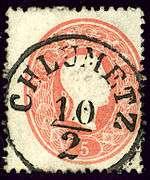
- Chlumetz (bei Wittingau): Chlumec u Třeboně B,93
- Chmelna: Chmelná
- Chodau (earlier: Unter-Chodau): Chodov B,18
- Chodenschloß: Trhanov
- Chodolitz: Chodovlice B,58
- Choltitz: Choltice (Pardubice District) B,58
- Chorin in Mähren: Choryně M,31
- Chotebor (earlier: Choteborz): Chotěboř B,11
- Chotimer: Chotimeř
- Chotimiersch: Chotimeř
- Chotieschau: Chotešov B,50
- Chotovin: Chotoviny B,85
- Chotusitz: Chotusice
- Chotzen: Choceň B,24
- Chrantschowitz: Chrančovice
- Chrast (bei Chrudim): Chrast u Chrudim B,12
- Chrastan (earlier: Chrastian): Chrášťany B,51
- Chrisdorf: Křišťanovice
- Chrises über Hohenstadt: Dlouhá Ves
- Christelhof: Christlův Dvůr
- Christelschlag: Křišťanovice
- Christianberg: Křišťanov B,41
- Christiansthal: Kristiánov
- Christophhammer: Kryštofovy Hamry
- Christophsgrund: Kryštofovo Údolí
- Chrobold: Chroboly
- Chropin: Chropyně M,11
- Chrostau Ölhütten: Chrastová Lhota
- Chroustowitz: Chroustovice B,24
- Chrudim: Chrudim B,12
- Chudenitz: Chudenice B,34
- Chuderitz: Chudeřice
- Chudiwa: Chuděnin
- Chumau: Chlumany
- Chumec, Chunzen: Chlumec
- Chwalkowitz in Böhmen: Chalkovice v Cechach B,38
- Chwallatitz über Schiltern: Chvaletice
- Chwalenitz: Chvalenice
- Chwalschowitz: Chvalšovice
- Chwojno: Chvojno B,58
- Chybi: Chybi S,1
- Cimelitz (before 1867: Czimelitz): Čimelice B,61
- Cirkwitz: Církvice B,35
- Cischkau bei Blowitz: Cizkov
- Cista: Cista ? B,40
- Citolib: Cítoliby B,44Citolib: B,44
- Cizkov bei Pilgram (earlier: Cischkow): Čížkov (earlier: Cizkov u Pelhrimova) B,59
- Cizowa: Čížová B,61
- Ckyn: Čkyně (Kieselhof) B,66
- Czalositz: Žalhostice
- Czarlowitz: Černovice B,4
D
- Dachau (near Dolní Kozli): Dachov
- Dajmirow: Damírov
- Dalleken: Daleké Popelice part of Benešov nad Černou
- Dalleschitz: Dalešice M,12
- Dallwitz (bei Karlsbad): Dalovice B,31
- Damboritz (Damborschitz, Damborschütz): Dambořice M,5 (Hodonin District)
- Damborschütz: Dambořice
- Dammerschlitz: Dambořice
- Damitz: Damnice
- Damnau: Damnov
- Darkau: Darkov (now, since 1948, part of Karviná) S,2
- Darmschlag: Darmyšl
- Darowa: Darová part of Břasy
- Daschitz: Dašice B,58
- Dassnitz: Dasnice B,18
- Datelov: Datelov
- Datschitz: Dačice M,4
- Dauba: Dubá B,14
- Daubitz (earlier: Neu-Daubitz): Doubice B,74
- Daubrawitz: Doubravice nad Svitavou B,38
- Daubrawnik: Doubravník M,27
- Daudleb: Doudleby nad Orlicí B,71
- Davle: to be identified B,82
- Deblin: Deblín M,27
- Dechant Gallein: Děkanské Skaliny part of Benešov nad Černou
- Dechtern: Dehtáře[8] part of the District České Budějovice District
- Deffernick (part of Markt Eisenstein): Debrnik
- Dejschina (earlier: Deischina): Dejsina B,60
- Dekau: Děkov
- Deslawen (Delaben): see Gross Chmelischen
- Depoldowitz: Depoldovice
- Dereisen: Zderaz
- Derfle: Sady
- Derflik: Víska u Jevíčka
- Deschenitz: Dešenice B,34
- Deschna: Deštná B,59
- Deschney: Deštné v Orlických Horách B,57
- Dessendorf: Desná
- Detenitz: Dětenice B,26
- Deutsch Beneschau (bei Kapl.): Benešov nad Černou B,30
- Deutsch Bernschlag: Dobrotín
- Deutsch Biela: Bělá nad Svitavou B,65
- Deutsch Borau: Beranovka
- Deutsch Brod (earlier: Deutschbrod): Havlíčkův Brod (before 1950: Německý Brod) B,15
- Deutsch Brodek: Brodek u Konice M,3
- Deutschbundesort: Dolní Rozmysl
- Deutsch Duschnik: Trbové Dušníky
- Deutsch Eisenberg: Ruda
- Deutsch Giesshübel: Nový Rounek B,15
- Deutsch Gilowitz: Dolní Jilovice
- Deutsch Haidl: Manava to be identified
- Deutsch Hause (earlier: Deutschhause): Huzová
- Deutsch Horschowitz: Německé Hořovice
- Deutsch Jassnik: Německý Jeseník; Jasenice na Moravě M,19
- Deutsch Kahn: Arnultovice
- Deutsch Kilmes: Německý Chloumek
- Deutsch Konitz (near Misslitz): Miroslavské Knínice
- Deutsch Kopist: Nové Kopisty
- Deutsch Kralupp (earlier: Kralup): Kralupy u Chomutova B,36
- Deutsch Krawarn: Kravaře u Opavy
- Deutsch Kubitzen: Nová Kubice
- Deutschleuten: Dolní Lutyně (Niemiecka Lutynia S,2
- Deutsch Liebau: Horní Libina M,25
- Deutsch Lodenitz (bei Sternberg): Německé Loděnice M,26
- Deutsch Märzdorf: Horní Bohdikov
- Deutsch Matha: Česká Metuje
- Deutsch Moliken: Malikov nad Nežárkou
- Deutsch Neudörfel: Delous
- Deutsch Neudstadtl: Nečtiny
- Deutsch Pankraz: Jítrava
- Deutsch Paulowitz: Slezské Pavlovice
- Deutsch Petersdorf: Petrovicky
- Deutsch Prausnitz: Německá Brusnice B,91
- Deutsch Reichenau bei Gratzen: Rychnov u Nových Hradů part of Horní Stropnice B,30
- Deutsch Reichenau bei Halsach (bei Friedberg): Německý Rychnov u Frymburku B,30
- Deutsch Rust: Podbořanský Rohozec
- Deutsch Schützendorf: (Nemecky Sicndorf) Střelecka B,15
- Deutsch Taebetitsch: unknown
- Deutsch Thomaschlag: Domaslavičky
- Deutsch Welhota: Lhota pod Pannou
- Deutsch-Wernersdorf: Vernéřovice
- Deutsch Zlatnik: Slatinice
- Dianaberg: Diana
- Dieditz bei Wischau: Dedice u Vyskova M,33
- Dielhau: Děhylov S,8
- Dietschan: Děčany
- Diettenitz: Detěnice
- Dimokur: Dymokury B,63
- Dingkowitz (Landkreis Bischofteinitz): Jenikovice (?) (to be confirmed)
- Dirna: Dirne B,85
- Distlowitz: Tisovla
- Ditmannsdorf (Dittmarsdorf): Dětmarovice S,2
- Dittersbach: Detřichov
- Dittersbach: Horní Dobrouc
- Dittersbach bei Böhmisch Kamnitz (bei Kreibitz): Jetřichovice B,90
- Dittersbach (bei Friedland) (Iser)): Detřichov B,19
- Dittersbach bei Halbstadt: Jetřichov u Meziměstí B,8
- Dittersbach über Landskron (bei Policka): Stašov B,65
- Dittersbächel: Detřichovec
- Dittersdorf (bei Zwittau): Dětřichov (Svitavy District) M,16
- Dittersdorf (Kreis Bärn): Dětřichov u Moravské Třebové (to be confirmed)
- Dittersdorf (Landkreis Sternberg) (Dittersdorf an der Feistritz):Dětřichov nad Bystřicí (before 1930: Dětřichov) M,26
- Dittmannsdorf: Dětmarovice S,2
- Diwischau: Divišov B,3
- Diwischowitz: Divišovice
- Dlasckowitz: Dlažkovice
- Dluhei: Dlouhý (?) (to be confirmed)
- Dnespek: to be identified B,3 (maybe Nespeky? )
- Dobern: Dobranov
- Dobern (Hochdobern): Dobrná
- Doberschisch: see Dobrisch
- Dobeschitz: Dobešice
- Dobrai (Dobray): Dobrá
- Dobraken: Doubrava (to be confirmed)
- Dobrau: Dobra S,6
- Dobrawa: Doubrava
- Dobrenitz: Dobřenice B,37
- Dobrey: Dobre B,57
- Dobrichowitz: Dobřichovice B,82
- Dobring: Dobřín (abandoned village of Loučovice B,30
- Dobrisch (before 1867: Dobrzisch; also: Doberschisch): Dobříš B,68
- Dobriw: Dobřív B,73
- Dobrochau: Dobrochov
- Dobromielitz: Dobromelice M,22
- Dobruschka: Dobruška B,57
- Dobrowitz: Dobrovice (Dobravice) B,28
- Dobrzan, Wiesengrund: Dobřany B,50
- Dobschitz: Dobrčice
- Dobschitz b. Moldauthein: Dobšice
- Döba: Děvín
- Döberle: Debrné
- Dölitschen: Telice (now part of Prostiboř)
- Döllnitz: Odolenovice
- Dönis: Donín
- Dörfel bei Friedland: Víska
- Dörfl: Sady S,7
- Dörfles: Vesce part of Horní Stropnice B,30
- Dörfles: Víska u Jevíčka (before 1949: Derflík)
- Dörflitz (near Rausenbruck): Znaim-Derflice (near Vrbovec) M,34
- Dörnsdorf: Dolina B,29
- Dörnthal: Suchdol
- Dörrengrund: Suchý Důl
- Dörrstein: Suchý Kámen
- Döschen: Dešná M,14
- Doglasgrün: Vřesová
- Dolan (bei Jermer): Dolany
- Dolein: Dolany M,21
- Doll: Důl
- Dollana: Dolany
- Dollern (near Polletitz): Dolany
- Domamühl: Domamil M,14
- Domaschin: Domašín
- Domaschow: Domašov M,3
- Domauschitz: Domoušice B,44
- Domausnitz: Domousnice B,26
- Domazlicky: Domažličky
- Domazlitzl: Domažličky
- Dombrau: Doubrava (1920-1924: Dombrová) S,2
- Domsdorf: Tomíkovice
- Domstadtl (Kreis Bärn): Domašov nad Bystřicí M,26
- Donawitz bei Karlsbad: Stanovice (Karlovy Vary District) B,31
- Donitz: Nové Tuhnice B,31
- Doppitz: Chuderov (to be confirmed)
- Dorfteschen (über Troppau): Deštné ve Slezsku S,7
- Dorf Stankau: Staňkov II, earlier Ves Staňkov part of Staňkov (Domažlice District)
- Dornfeld: Trnové Pole
- Dorrstadt: Městiště
- Dorschitz (Doschitz): Dožice
- Dotterwies: Tatrovice
- Doudlewetz: Doudlevce
- Doxan: Doksany B,70
- Dozic: Dozice B,5
- Drahan: Drahany M,23
- Drahanowitz: Drahanovice M,21
- Drahenitz: Drahenice B,5
- Drahenz: Drahonice
- Drahomischl: Drahomyšl
- Drahotusch: Drahotuše (part of Hranice) M,32
- Drahowitz: Drahovice
- Draschitz: Dražice B,85
- Draschkow: Dražkov
- Drasow (earlier: Drassow): Drásov (Brno-Country District) M,27
- Drazenov: Draženov
- Dreiborn: Skály
- Dreibuchen: Buková
- Dreieckmark (mountain): Trojmezná
- Dreieinigkeit: Hajniště
- Dreihacken: Tři Sekery; Tři Sekery u Kynžvartu; Tři Sekery u Tachova B,62
- Dreihäuser: Třídomí
- Dreihöf: Oldrichovice (to be confirmed)
- Dreihöf: Záhory
- Dreihöfen: Tři Dvory
- Dreihunken: Behanky
- Dreiseenfilz (Moor): Tříjezerní slať
- Dreisesselberg|Dreisessel (mountain): Třístoličník
- Dresnitz: Strážnice (to be confirmed)
- Drewohostitz: Dřevohostice M,9
- Dries: Dřísy
- Drissgloben: Malé Dvorce
- Dritsch: Dříteč B,58
- Drnowitz: Drnovice M,33
- Drosau: Strážov B,34
- Droschlowitz: Drahoslavice
- Drosenau über Hohenstadt: to be identified (near Zábřeh ?)
- Droslau: Tvrdoslav
- Dubrowitz: Dubovice
- Drum: Stvolínky B,7
- Druzetz: Družec B,33
- Drzkow (earlier: Drschkow): Držkov B,80
- Dub an der March (bei Olmütz): Dub nad Moravou M,21
- Dub bei Wodnian (earlier: bei Wällischbirken): to be identified B,84
- Dubany: Dubany
- Dubcan: Dubčany
- Duben: Dubné B,10
- Dubenetz (am Königreichwald): Dubenec B,38
- Dubitz: Dubice
- Dubitzko in Mähren: Dubíčko na Moravě M,8
- Dublowitz: Dublovice B,79
- Dubnian: Dubňany M,6
- Dunkelthal: Temný Důl
- Dürchel: Drchlava
- Dürmaul: Trmová (Karlovy Vary)
- Dürnbach: Ava
- Dürnberg: Sucha
- Dürnholz: Drnholec M,20
- Dürr: Suchá
- Dürre: Prostředkovice
- Dürrengrün: Výspa
- Dürrmaul: Drmoul B,62
- Dürrseifen: Suchá Rudná
- Duppau: Doupov
- Dubschan: Dubčany
- Dukowan: Dukovany M,12
- Dunkelthal: Temný Důl
- Duppau: Doupov B,29
- Duschnik (in Böhmen): Trhové Dušníky B,33
- Duschowitz: Tuškov
- Dux: Duchcov Duchov? B,16
- Dvorce: Dvorce, Bruntál
- Dvorec: Dvorec
- Dzieditz: Dziedice S,1
E
- Ebene: Rovina
- Ebenau: Záton
- Ebersdorf (later: bei Friedland) (bei Mariaschein): Habartice (Liberec District) B,2
- Ebersdorf bei Graupen: Habartice u Krupky
- Ebersdorf bei Mährisch Altstadt: Habartice u Jindřichova
- Ebersdorf bei Weigsdorf: B,19
- Ebmeth: Rovná
- Eckersbach: Rokytnice
- Eckersdorf: Jakartovice S,4
- Edersgrün: Oder to be identified
- Eger: Cheb B,17
- Eger (Fluss): Ohře
- Egrisch Reuth: see Himmelreich
- Ehmet: Svažec
- Ehrenberg: Ušák
- Eibenberg: Tisová
- Eibenschitz (earlier: Eibenschütz): Ivančice M,3
- Eibis: Ivaň
- Eichelhäuser: Dubi (to be confirmed)
- Eichen (Klatovy): Dubí
- Eichenhof: Dubina to be identified
- Eichhorn-Bittitschka: Veverská Bítýška M,27
- Eichicht: Doubí
- Eicht: Dubičná
- Eichwald: Dubí B,89
- Eidlitz (in Böhmen): Údlice B,36
- Eiland: Ostrov
- Eilowitz: Jílovec
- Einöde: Pustina
- Einoth: Renoty
- Einsiedel: Mníšek v Krušných horách (part of Nová Ves v Horách)
- Einsiedel bei Reichenberg (earlier: bei Friedland): Nažidla B,19
- Einsiedel bei Würbenthal: Einsidl u Vrbna S,4
- Einsiedl (bei Marienbad): Mnichov u Mariánských Lázní B,88
- Einsiedl, Rotte, zu Böhmisch Gillowitz: Poustevna
- Eipel: Úpice B,91

- Eisenberg: Jezeří
- Eisenberg an der March: see Nieder Eisenberg M,25
- Eisenberg bei Görkau: Jezeří
- Eisenberg in Böhmen: B,36
- Eisenbrod: Železný Brod B,80
- Eisendorf (Westböhmen): Železná u Smolova B,4
- Eisengrub, zu Mauthstadt: Záhliní
- Eisenhüttel: Záchlumí
- Eisenstadtel (Eisenstadtl): Železnice B,26
- Eisenstein (Markt): Železná RudaB,78
- Eisenstein Dorf: Spičák
- Eisenstraß: Hojsova Stráž B,34
- Eisgrub: Lednice M,20
- Eiwan: Ivaň
- Eiwanowitz: Ivanovice na Hané M,33
- Elbe (Fluss): Labe
- Elbecken: Klínovec (to be confirmed)
- Elbekosteletz: Kostelec nad Labem B,32
- Elbeteinitz: Týnec nad Labem (earlier: Labska Tynice) B,35
- Elbogen: Loket B,18

- Elendbachel: Polka to be identified (Šumava ?)
- Eleonorenhain: Lenora B,66
- Elexnitz: Olešnice
- Elhenitz: Lhenice B,66
- Elhoten bei Wiesengrund: Lhota pod Pannou
- Elhoten bei Mies (bei Tschernoschin): Lhota to be identified B,50?
- Elisenthal: Alžbětín
- Elisienthal: Osli Mlýneček
- Ellgoth bei Mährisch Ostrau: Lhotka u Mor. Ostravy M,15
- Ellischau: Nalžovy (1951 joined with Stříbrné Hory (Silberberg) into Nalžovské Hory)
- Elmm: Stráň
- Elsch: Staré Sedlo / Olešná
- Elschtin: Lštění
- Emmern, zu Mutzgern: Emry, Bednáře
- Endersdorf (in Schlesien): Ondřejovice S,3
- Endersgrün: Ondřejov
- Engelhaus: Andělská Hora (Karlovy Vary District) (Burg Andělská Hora) B,31
- Engelsberg: Andělská Hora (Bruntál District) (Andělská Hora ve Slezsku) S,4
- Engelsdorf: Andělka
- Engelsthal: Andělské Žleby
- Engelswald über Stauding: Albrechtičky
- Enis-Laschan: Lažany
- Enkengrün: Jankovice
- Entenbühl: Entenbil
- Epperswagen (Kreis Bärn): Nepřívaz
- Erdberg: Hrádek u Znojma M,34
- Erdmannsdorf: Nové Zálužné
- Erdmannsgrund: Artmanov
- Erdweis: Nová Ves nad Lužnicí
- Ermelei: Jermaly
- Ermesgrün: Smrčina
- Ernsdorf in Schlesien: Jaworze, Silesian Voivodeship S,1 (now Poland)
- Ernstberg, zu Korkushütten: Arnoštka
- Ernstbrunn, zu Christianberg: Arnoštov
- Ertischowitz: Rtišovice
- Erzberg: Plece
- Esche: Eš
- Eschen: see Jasena
- Eschowitz (Juratin): Čečkovice
- Espenthor: Olšová Vrata
- Esseklee: Nesachleby
- Eulau an der Dux-Bodenbach Bahn: Jílové B,90
- Eule: Jílové u Prahy B,39
 cachet de EULE en date du 06/11/1862
cachet de EULE en date du 06/11/1862- Eule bei Dessendorf: Sovín
- Eulenberg: Sovinec M,24
- Eulhütten: Sova to be identified
- Eywan: Evaň
F
- Falgendorf: Horka u Staré Paky B,26
- Fallbaum (mountain): Javoří
- Falkenau an der Eger (Falknov): Sokolov (Sokolov District) B,18
- Falkenau (b. Haida): Falknov (part of Kytlice)
- Falkenau (bei Iglau): Sokolíčko
- Falkendorf: Decín XXVIII - Folknáře
- Fassattengrün: Božetín
- Felhauser: V Poli
- Feldkretschen: Krčmov
- Feldsberg: Valtice
- Ferbenz: Rvenice
- Ferchenhaid: Borová Lada
- Ferdinandsdorf: part of Choustníkovo Hradiště
- Ferdinandsthal: Ferdinandov
- Fichtenbach: Fuchsova Huť (Fuxova Huť) B,87
- Filippsdorf bei Georgswalde: to be identified B,77
- Filz: Slatina
- Finkendorf: Polesí (to be confirmed)
- Finkenkoppe (mountain): Pěnkavčí vrch
- Fischbach: Abertamy (to be confirmed)
- Fischbäckern: Bednáře
- Fischbäckern, zu Mutzgern: Rybáře
- Fischerhäuser: Rybarske Domky
- Fischern: Rybáře B,31 (part of the town Karlovy Vary)
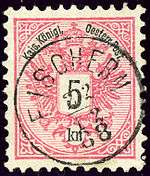
- Fischern, zu Schwiebgrub: Stěžerov
- Fischhäusel: Hosterádky
- Flandorf: Panenská
- Flecken: Fleky
- Fleissen: Plesná (Cheb District) B,17
- Fleissheim: Horní Borková
- Fleyh (earlier: Fleih): Fláje B,16
- Flöhau: Blšany B,64
- Försterhäuser: Myslivny
- Fonsau: Vonsov
- Forbes: Borovany B,10
- Forstbad: to be identified B,23
- Frain: Vranov nad Dyjí M,34
- Frainersdorf: Vranovská Ves M,34
- Frainspitz: Branišovice M,12
- Frankenhammer: Liboc (Prague 6)
- Frankstadt bei Mährisch Schönberg (Frankstadt a.d. Mähr. Grenzbahn): Nový Malín (bis 1948 Frankštát)) M,25
- Frankstadt am Radhoscht (earlier: Frankstadt bei Mistek): Frenštát pod Radhoštěm M,17
- Franowa: Vránov part of Staňkov (Domažlice District) B,4
- Franschile: Vrahozily
- Franzberg: Františkov
- Franzendorf bei Reichenberg: Františkov u Liberce B,72
- Franzensbad: Františkovy Lázně B,17
- Franzensthal: Františkov
- Franzenthal: Františkov nad Ploučnicí B,90
- Fratting: Vratěnín M,14
- Frauenberg: Hluboká nad Vltavou B,10
- Frauenberg: Panenská Hura (Liberec)
- Frauendorf: Panenská
- Frauenreith: Svobodka
- Frauenreuth: Kopanina
- Frauenthal: Horní Pohled B,15
- Frauenthal (part of Kienberg): abandoned village Frantoly B,30
- Frauschile: Brozánky
- Frei Hermersdorf: Svobodné Hermanice
- Freiberg in Böhmen: to be identified
- Freiberg (in Mähren): Příbor M,19
- Freidau: Frydava
- Freidorf: Ostré
- Freiheit: Antonínovo Údolí B,91
- Freiheit an der Aupa: Svoboda nad Úpou
- Freiheitsau: Háj ve Slezsku S,7
- Freiheitsberg: Svobodín
- Freihermersdorf: Svobodné Heřmanice S,4
- Freihöls: Stará Lhota
- Freihofen: Poltište nad Labem
- Freistadtl bei Holleschau: Karviná (earlier: Fryštát) M,9
- Freistadt an der Olsa (in Schlesien): Fryštát S,2
- Freistein: Podhradí nad Dyjí
- Freiung, near Klösterle: Lipka
- Freiwaldau: Jeseník (before 1947: Frývaldov) S,3

- Freudenberg: Veselé (Děčín District)
- Freudenheim: Veselíčko
- Freudenthal (in Schlesien): Bruntál S,4
- Friedau, zu Friedberg: Frýdava (Předmostí)
- Friedberg, Mistek: Místek
- Friedberg in Böhmen (an der Moldau): Frymburk B,30
- Friedeberg: Žulová (earlier: Frýdberk) S,3
- Friedek (Friedeck): Frýdek S
- Friedenau: Frýdnava
- Friedenthal: Strachovice
- Friedersreuth: Pastviny (Ústí nad Orlicí District)
- Friedland an der Mohra (before 1873: in Mähren; between 1873 and 1878: bei Kriegsdorf): Břidličná also (Frýdlant nad Moravicí) (Břidličná nad Moravicí) M,24
- Friedland an der Ostrawitza (bei Mistek): Frýdlant nad Ostravicí (earlier: Frydlant u Mistku) M,17
- Friedland in Böhmen: Frýdlant v Čechách B,19
- Friedrichsau: Bedřichov (Bedřichovice)
- Friedrichschlag, also Fridretschlag: Bedřichov part of Horní Stropnice B,30
- Friedrichsdorf: Bedřichov (Jihlava) / Bedřichovice (Louny)
- Friedrichshütten: Nová Huť
- Friedrichswald: Hnátnice B,43
- Friedrichswald bei Gablonz: Bedřichov (Jablonec nad Nisou District) B,72
- Friedrichswald bei Rokitnitz: Friedrichswald u Rokytnice ?? B,81? (Ústí nad Orlicí District?)
- Freisedorf: Brezda
- Frischau a.d. Staatsbahn: Frýsava na Státní Dráze (Frisava) M,34
- Frischau bei Neustadtl: Fryšava pod Žákovou horou (until 1991: Fryšava; earlier also: Frisava) M,18
- Frischwasser: Čistá Voda
- Fritschowitz: Fryčovice
- Frobelhof: Froblov
- Frohenbruck an der Lainsitz: Veselí nad Lužnicí (see "Wesseli an der Lainsitz")
- Fröhlichsdorf: Brocno
- Frohnau: Rovná (Sokolov District) (Rovná u Sokolova) B,18
- Frollersdorf über Grusbach: Frélichov
- Froschelsdorf über Schiltern: to be identified
- Frühbuss: Přebuz B,22
- Fuchsberg: Lišcí Hora
- Fuchsberg: see Rothenbaum
- Fuchsenfof: Fuchsův Dvorec
- Fuchsloch: Liščí Díra
- Füllersdörfel: Vesnička
- Füllstein: (Fulštejn) Bohušov S,5
- Fünfhunden: Pětipsy B,29
- Fünfzighuben (Kreis Bärn): Padesát Lanů
- Fürstenbruck: Knežmost B,53
- Fürstenhof: Knížecí Dvůr
- Fürstenhut: Knížecí Pláně
- Fürstenwalde: Knížecí
- Fürthel: Brůdek
- Fugau: Fukov B,77 (to be confirmed)
- Fulnek: Fulnek M,19

- Fussdorf: Nový Rounek
G
- Gabel an der Adler: Jablonné nad Orlicí B,81
- Gabel (bei Niemes): to be identified B,20
- Gaberle: Javoří
- Gabersdorf in Böhmen: Libeč B,91
- Gabhorn: Javorná
- Gablonz (an der Neiße): Jablonec nad Nisou B,21
- Gabrielahütten: Gabrielina Huť
- Gabrielenhof: Gabrielka
- Gängerhof: (Chodov u Bečova nad Teplou)) Chodov (Karlovy Vary District)
- Gärten bei Rumburg: Zahrady u Rumburku
- Gässing: Jesen
- Gaischwitz: Kýšovice
- Gaisdorf (Kreis Bärn): Kyžlirov
- Gaiwitz: Kyjovice
- Galtenhof: Branka B,86 (to be confirmed)
- Galtenstallung: Jalový Dvůr
- Gamnitz: see Jamnitz
- Gansau: Pravetín
- Gansauerhaid: Pravětínská Lada
- Garschönthal: Úvaly (to be confirmed)
- Gartenberg (mountain): Zahrádka
- Garten-Mühle: Zahrádecký Mlýn
- Gartitz: Skorotice B,2 (to be confirmed)
- Gassnitz: to be identified
- Gastorf: Hoštka B,14
- Gatterschlag: Kačlehy
- Gauendorf: Mokré
- Gaya (in Mähren) (earlier: Gaia): Kyjov M,5
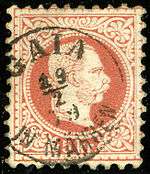
- Gayer: Gajer
- Gayerruckberg: Gayruk
- Gebirgsneudorf: Nová Ves v Horách B,9
- Gefild: see Aussergefild
- Gehae: Háj
- Gehäng: Láz
- Geierle, near Duschowitz: Kavrlik
- Geiersberg: Jankovice
- Geiersberg (in Böhmen): Letohrad (before 1950: Kyšperk) B,81
- Geiersgraben: Čertův Důl
- Geisleiten: Kozí Stráň
- Geislersfeld: Lomy
- Geltschbad, Bad Geltschberg: Lázně Jeleč
- Geltschberg (mountain): Sedlo (to be confirmed)
- Georgendorf: Český Jiřetín B,16
- Georgengrund: Jiřský Důl
- Georgenthal (Sankt Georgenthal): (Jiřetín pod Bukovou) Jiřetín pod Jedlovou
- Georgswalde: Jiříkov B,77
- Geppersdorf in Mähren: Kopřivná / Linhartovy M,25 both?? last?
- Geppertsau: Údolná
- Geppertsau (Kreis Bärn): Keprtovice
- Gerbetschlag: Herbertov
- Gereuthern: Jitronice (Křoviště)
- Gerlhütte: Gerlova Huť
- Gersdorf: Kerhartice / Mezihoří B,90
- Gerten: Krty
- Gesen: Jesení
- Geserzen: Jiřské
- Gesmesgrün: Osvinov
- Gesna: Jesná
- Gessing: Jesíky
- Gesteinigt: Kamenná
- Gestob: Ždov
- Geweihtenbrunn: Boží Voda
- Gewitsch: Jevíčko M,16
- Gibacht: Pozorka / Herštejnské Chalupy
- Gibian: Jivjany
- Giebau: Jívová M,26
- Giessdorf: Jišterpy
- Gießhübel: Olešnice v Orlických horách
- Gießhübel: Stružná
- Gießhübel: Boršov
- Giesshübel bei Neustadt A.D.M.(earlier: Giesshübel bei Nachod): unknown B,57
- Gießhübl-Sauerbrunn (before 1895: Gießhübel-Puchstein): Kyselka B,31
- Gillowitz: Horní Jílovice
- Gilschwitz (near Troppau): Kylešovice
- Girsch: Krsy B,88
- Girschen: Jeren
- Girschowa: Krsov
- Girsig: Jiříkov (Bruntál District)
- Gitschin: see Jicin
- Glasau: Neblašov
- Glasberg: Sklená
- Glaselsdorf: Skelné
- Glasern: Klažary
- Glashütten: Skláře / Skelné Hutě / Skelná Hut' (to be confirmed: same place?)
- Glatzen: Kladská
- Gleimen: Hliněná
- Glemkau: Hlinka (Bruntál District)
- Glieden: Liden (to be confirmed)
- Glitschau: Klícov
- Glöckelberg: Zvonková B,41
- Glomnitz (über Troppau): Hlavnice S,7
- Glosau: Dlažov
- Gmünd: České Velenice
- Gnadlersdorf: Hnanice
- Gnoitz: Hnojice M,26
- Gobitschau (near Sternberg): Chabičov
- Godrusch: Jadruž
- Göding: Hodonín M,6
- Göhe: Háj
- Göhren: Klíny
- Göllitz: part of Strobnitz B,30
- Görkau: Jirkov B,36
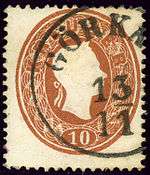
- Gösen: Kadaňská Jesen
- Göttersdorf bei Görkau (Göttersdorf in Böhmen): Boleboř B,36
- Goitein: see Kojetein
- Gojau: Kájov
- Goldbach: Zlatý Potok
- Goldberg: Zadní Bor
- Goldberg: Zlatá
- Goldbrunn: Balda (to be confirmed and disambiguated)
- Goldbrunn: Zlatá Studna
- Goldenbrunn: to be identified M,2
- Goldenhöhe: Zlatý Kopec
- Goldenfluss: Horní Hedec
- Goldenkron: Zlatá Koruna B,41
- Goldenöls: Zlata Olešnice
- Goldenstein: Branná u Šumperka (Kolštejn) M,25
- Goldwag:Otín
- Golleschau (bei Ustron): Goleszow S,1 (now in Poland)
- Gollitsch (part of Podesdorf): Kaliště, part of Bohdalovice
- Gollnetschlag: Klení part of Benešov nad Černou
- Goltsch Jenikau: Golčův Jeníkov B,13
- Gosel: Kozly
- Gosolup: see Ober Gosolup
- Goslau: Kozlov
- Gossau: Kosov
- Gossengrün: Krajková B,18
- Gostl: see Kostel
- Gotschdorf: Hoštálkovy S,5
- Gottesgab: Boží Dar B,27
- Gottmannsgrün: Trojmezí
- Gottschau: Kočov
- Graben: Ondřejov
- Graben: Strouhy
- Graber: Kravaře v Čechách B,46
- Gradlitz: Hradište u Dvora Králové B,38
- Gradlitz (im Königreichwald): Choustníkovo Hradiště
- Gräfenberg (bei Freiwaldau): Lázně Jeseník S,3
- Grafenstein: Grabštejn
- Gränzdorf: Hraničky
- Gränzendorf: Bedřichov
- Grätz in Schlesien (Gratz??) : Hradec nad Moravicí (Hradec ve Slezsku) S,7
- Grafendorf bei Grussbach: Hrabětice M,34
- Grafenried: Lučina
- Grambach: Krampachy
- Granesau: Chranišov
- Granzgrund: see Markhausen
- Grasengrün: Hájek
- Grasfurt: Brod
- Grasige Moldau (Fluss): Řasnice
- Graslitz: Kraslice B,22
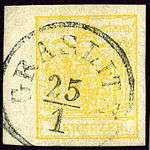
- Grasset: Jehličná
- Gratzen: Nové Hrady B,30
- Graupen: Krupka B,89
- Grenzbach: Hraniční Potok
- Greifendorf: Hradec nad Svitavou M,16
- Grenzdörfel: Pomeznice
- Griesbach: Křemenitá
- Grilling: Cvrčkov
- Gritschau: Krčín part of Horní Stropnice B,30
- Grodzietz: to be identified S,1
- Gröditz-Neudorf: Hradec-Nová Ves
- Gröditz in Oesterr. Schlesien: unknown S,3
- Gröschelmauth: Grešlové Mýto M,14
- Gromaling part of Lippen: Kramolín part of Lipno nad Vltavou
- Groschau: Chraštany
- Groß Aujezd (earlier: Gross-Augezd bei Leipnik): Velký Újezd M,32
- Groß Aupa (Großaupa) (part of Petzer): part of Pec pod Sněžkou Velká Úpa B,91
- Großbieltsch: Běleč nad Orlicí
- Groß Aurim: Velký Uhřínov B,81
- Groß Bechar: Běchary
- Groß Beranau: Bradlo (Velky Beranov) M,10
- Groß Bistritz (bei Roznau): Valašská Bystřice M,31?
- Groß Bittesch: Velká Bíteš M,7
- Gross Blatnitz (Großblatnitz): Velka Blatnice Blatnice pod Svatým Antonínkem M,30
- Großblatzen: Blatce
- Gross Bocken: Velká Bukovina
- Groß Borowitz: Borovnice u Staré Paky
- Groß Bürglitz: Velký Vřešťov B,37
- Groß Butschin: Velká Bučina
- Groß Cakowitz: Čakovice B,32
- Groß Cekau: Čakov (České Budějovice District)[9] part of the District České Budějovice District B,10
- Groß Cermna: Velká Čermná nad Orlicí
- Groß Chrastitz: Chraštice B,61
- Groß Czernosek: see Gross Tschernosek
- Groß Darkowitz: Darkovice
- Gross Deschau: Velky Desov M,14
- Groß Dittersdorf (Kreis Bärn): Čermná na Moravě
- Groß Domanin: Domanín
- Großdorf (bei Kojetitz in Böhmen): Veľká Ves B,32
- Großdorf bei Braunau in B.: Velkoves u Broumova B,8
- Groß Drewitsch: Velký Dřevíč
- Groß Drossen: Bučí
- Groß Drossen: Velké Strážné
- Grosse: Hrozová
- Großenteich: Velký Rybník
- Grosser Osser (mountain): Ostrý
- Großer Spitzberg (mountain): Špíčník
- Großfürwitz: Vrbice (Karlovy Vary District)
- Groß Gallein, part of Deutsch Beneschau: Daleké Popelice, Velké Skaliny part of Benešov nad Černou
- Großglockersdorf: Velký Klokočov S,7
- Groß Gorschin: Velký Horšín
- Groß Gropitzreith (Großgropitzreith): Velký Rapotín
- Groß Grünau: Velký Grunov
- Groß Gürsch: Krsy
- Großhaid: Velký Bor
- Groß Hammer (Großhammer): Velké Hamry: Hořejší Hamr
- Groß Heilendorf: Postřelmov M,8
- Groß Heinrichschlag, part of Deutsch Beneschau: Velký Jindřichov part of Benešov nad Černou
- Groß Hermsdorf: Hermanice
- Groß Herrlitz: Velké Heraltice S,4
- Groß Herrndorf: Kněžice
- Groß Hluschitz: Hlušice (Velké Hlušice) B,55
- Gross Holletitz: Holedeč
- Groß Hoschütz: Velké Hoštice
- Gross Hrabowa: Velka Hrabova M,15
- Groß Hubina: Velky Hubenov
- Groß Hycitz: Malé Hydčice
- Groß Jentsch (Gross-Jenc): Jeneč B,33
- Gross Jessenitz (bei B. Skalitz): Velká Jesenice B,54
- Groß Jirna: Jirny
- Groß Jober: Velká Javorská
- Groß Karlowitz (Großkarlowitz): Velké Karlovice M,31
- Groß Kaudern: Chuderov
- Groß Kletzan: Klecany
- Groß Koschatka: Košatka
- Groß Kostomlat: Kostomlaty nad Labem B,63
- Groß Krosse: Velká Kraš
- Groß Kuchlitz: Malý Chuchelec
- Gross Kuntschitz in Schlesien: Wielkie Konczyce w Slazku S,2 Poland?
- Gross Kunzendorf bei M. Ostrau: Velke Kuncice u M. Ostravy S,6
- Groß Kunzendorf: Velké Kuncice nad Ostravicí
- Groß Kunzendorf (bei Weidenau?): Velké Kunětice S,3?
- Gross Latein bei Olmütz: unknown M,21
- Groß Lhotta: Poldovka (Velka Lhota) M,4
- Groß Lippen: Lipno
- Großloh: Velký Luh
- Großlohowitz: Hlohovice
- Groß Lossenitz: Velká Losenice B,11
- Groß Lowtschitz: Lovcice
- Groß Lubigau: Malý Hlavákov
- Gross Lukow: Velky Lukov M,9
- Großmallowa: Velký Malahov
- Großmalowitz: Malovice
- Groß Meierhöfen: Velké Dvorce (now part of Přimda (Pfraumberg))
- Gross Mergthal (Großmergthal): Mařenice B,20
- Gross Meseritsch (Großmeseritsch): Velké Meziříčí M,7
- Großmohrau: Velká Morávka
- Groß Morschin (Gross-Morzin): Mořina
- Groß Nehwisd: Nehvizdy B,32
- Großnepodritz: Velké Nepodřice
- Gross Niemtschitz: Velké Němčice M,1
- Groß Olbersdorf: Velké Albrechtice
- Groß Olkowitz: Velké Oleksovice
- Groß Opatowitz (before 1888: Oppatowitz bei Gewitsch): Velké Opatovice M,16
- Groß Opolan: Opolany
- Groß Orechau (bei U. Brod): Velký Ořechov M,29
- Groß Otschehau: Očihov
- Groß Pantschen: Velký Pecín
- Gross Pawlowitz: Velké Pavlovice M,1
- Groß Petersdorf (bei Zauchtl): Vražné M,19
- Gross-Peterswald: (Velký Petřvald na Moravě) Petřvald (Karviná District) M,19
- Groß Petrowitz (bei Nechanitz): Petrovice B,37
- Groß Pohlom: Velká Polom S,8
- Groß Poidl: Kremačov
- Großpopowitz: Velké Popovice
- Groß Poric: Velké Poříčí
- Groß Priesen (Grosspriesen): Velké Březno B,2
- Groß Prilep (Groß Pschilep ?): Kamýk (Velke Prilepy) B,82
- Groß Pulitz: Pulice
- Groß Raden: Radim (Kolín District) ?
- Groß Rammerschlag: Velký Ratmířov
- Groß Ritte: Hylváty (Velka Retova) B,43
- Groß Rogau: Velký Radkov
- Groß Schinian: Bedrč
- Groß Schönau (Großschönau): Velký Šenov
- Großpriesen: Velké Březno
- Groß Schönthal: Malé Krásné
- Groß Schüttüber: Malá Sitbor
- Groß Schwadowitz: Velké Svatoňovice
- Groß Seelowitz (earlier: Seelowitz): Židlochovice (perhaps also Unkovice) M,1

- Groß Semtin: Semtín
- Groß Senitz: Senice na Hané (Velka Senice) M,13
- Groß Siehdichfür: Velká Hleďsebe
- Groß Skal: Hrubá Skála
- Groß Spinelsdorf: to be identified (Karlovarsky kraj?)
- Groß Steurowitz: Starovice
- Groß Stiebnitz: Velká Zdobnice B,81
- Groß Stohl: Velká Štola M,24
- Groß Strodau: Velký Stradov
- Groß Tajax: Dyjákovice M,34
- Groß Teinitz (bei Olmütz): Velký Týnec M,21
- Groß Temelin: Temelín
- Groß Trestny: Velké Tresné
- Groß Tschakowitz: Čakovice
- Großtschekau: Čakov
- Groß Tschernitz: Velká Černoc B,75
- Gross Tschernosek (Groß Zernosek?): Velké Žernoseky
- Groß Tschochau: Řehlovice
- Groß Ullersdorf (earlier Ullersdorf): Velké Losiny M,25
- Groß Umlowitz: Omlenice
- Groß Uretschlag: Černíkov
- Groß Urhau: Ořechov
- Groß Wallstein: Velký Valštejn
- Groß Walten: Velký Valtínov
- Groß Waltersdorf (until 1898: bei Stadt Liebau) (Kreis Bärn): Velká Střelná M,26
- Großwasser (Kreis Bärn): Hrubá Voda
- Großwehlen (also Großwöhlen):Decín XXX - Velká Velen
- Groß Werscheditz: Verušice
- Groß Wisternitz (Großwisternitz): Velká Bystřice M,21
- Groß Witschitz: Nové Trebčice
- Groß Wonetitz: Bonetice
- Groß Wonetitz: Staré Sedlo
- Groß Wosek: Velký Vosek B,35
- Groß Woslawitz: Oslavice
- Groß Wosnalitz: Osinalice
- Großwossek: Velký Osek
- Groß Wrbka: Hrubá Vrbka
- Groß Wschelis: Velké Všelisy
- Groß Würben: Velké Vrbno
- Groß Würbka (Groß Wrbka): Hrubá Vrbka
- Groß Zdikau: Zdíkov (Velky Zdikov) B,66
- Groß Zmietsch: Smedeč (Velka Smedec) B,41
- Grottau: Hrádek nad Nisou B,72
- Grün: Zelená Lhota (to be confirmed) (not Louka in Estonia)
- Grün bei Asch: Doubrava
- Grün bei Marienbad: to be identified B,31
- Grünau: Gruna
- Grünberg (castle): Zelená Hora
- Grünberg: Nová Studnice
- Grünberg-Eibenberg (before 1896: Eibenberg): to be identified B,22
- Grünbergerhütte: Zelenohorská Huť
- Grünlas: Loučky
- Grünthal: Zelený Důl
- Grünwald: Pastviny (Ústí nad Orlicí District)
- Grünwald (an der Neiße): Mšeno nad Nisou B,21
- Grulich: Králíky B,81
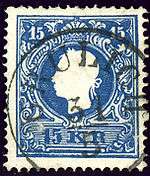
- Grumberg: Mesto Podlesí (earlier: Krumperky) M,25
- Grunddorf: Dlouhá Ves (Havlíčkův Brod District) (to be confirmed)
- Grussbach: Hrušovany nad Jevišovkou M,34
- Gschwendt: Švendov
- Gschwendt: Světví part of Horní Stropnice B,30
- Gsenget: Pomezí
- Gügel: Bukovina (to be confirmed and disambiguated)
- Güntersdorf (bei Königinhof a.d. Elbe): Huntířov u Dvoravé B,38
- Gürsch: Krsy
- Guldenfurth: Brod nad Dyjí
- Gumpolds, Gumplitz: see Humpoletz
- Gundersdorf (Kreis Bärn): Guntramovice
- Guratin: Krtín
- Gurein: Kuřim M,27
- Gurim: Kouřim
- Gurschdorf bei Jauernig: Skorošice S,3
- Gurschim: Koren
- Gurwitz: Gurovice
- Guscht: Kuscht
- Gut Tomashof: to be identified
- Gut Wellowitz: Bílovice
- Gutbrunn: Dobrá Voda
- Gutenbrunn: Meziluží part of Horní Stropnice B,30
- Gutenfeld: Dobruška
- Guthausen: Dobrá na Šumavĕ
- Guttenfeld: Dobré Pole
- Gutwasser bei Budweis: Dobrá Voda u Českých Budějovic
H
- Haan: Háj u Duchcova
- Haardt: Staré Hobzí
- Haartch über Ratibor: Hat u Opavé
- Haatsch: Hať, formerly Haš
- Habakladrau: Ovesnè Kladruby
- Haber: Habrina
- Haberdorf: Ovesná
- Habern: Habry B,13
- Habersbirk (Haberspirk): Habartov B,18
- Habicht (Kreis Bärn): Jestřábí
- Hablesreith: Havlov
- Habrina (1939-45 Hainbuchen): Habřina
- Habrowan: Habrovany M,33
- Habstein, Habichstein: Jestřebí u České Lípy B,7
- Habstein, Habichtstein (castle): Jestřebí (also called: Habštejn, Krušina)
- Hackenhäuser: Sekerské Chalupy
- Hafnerluden: Lubnice
- Hafnern: Klení
- Härtlings: Horepník
- Hagengrün: Zeleny Háj
- Hagensdorf: Ahníkov
- Hahnbusch (mountain): Kohout
- Hahnenriegel (mountain): Tok
- Haid: Bor B,86
- Haida: Nový Bor, before 1948 Bor u České Lípy B,7
- Haidberg, near Wadetschlag: Vresna
- Haidl: Lomek
- Haidl am Ahornberg: Zhůří
- Haindorf (in Böhmen): Hajnice B,19
- Haindorf (Isergebirge): Hejnice
- Hainspach: Lipová (earlier also: Hanšpach) B,77
- Haje: to be identified B,80
- Halbgebäu: Podilna
- Halbmeil: Rozhraní
- Halbstadt: Meziměstí B,8
- Hallenkau: Halenkov M,31
- Hals (in Böhmen): Halže B,86
- Hammer (b. Leutensdorf): Hamr u Litvínova
- Hammer am See: Hamr na Jezeře, also Hamr pod Ralskem
- Hammerhäuseln: Hamrníky
- Hammern: Hamry
- Hamstein: Hamstejn
- Hannersdorf: Jindrišská
- Hannsdorf: Hanušovice M,25
- Hardetschlag: Hartunkov part of Benešov nad Černou
- Hareth: Horany
- Harlosee: Horní Polžice
- Harrachsdorf (Riesengebirge): Harrachov
- Harta (bei Hohenelbe): Harta u Vrchalbí B,33
- Hartenberg: Hartenberk B,18
- Hartessenreuth: Hartousov
- Hartmanitz: Hartmanice B,78
- Hartmannsgrün: Hartmanov
- Hartowitz: Hrdějovice
- Harzdorf: Starý Harcov
- Haschowa: Hašov
- Haselbach (in Böhmen): Haselbach na Šumavé B,87?
- Haselberg: Lískovec
- Haselhof: Lískovec
- Hasenburg (Burg): Hazmburk, also Klapý
- Haslau: Hazlov B,1
- Haslicht (Kreis Bärn): Varhost
- Hatzles: Hodslav, also Haclov
- Hauenstein: Haunštejn
- Hauptmannsdorf: Hejtmánkovice
- Hausbrünn bei Gewitsch: Usobrno u Jevicka M,16
- Hausdorf über Neutitschein (bei Zauchtl?): Hukovice u Suchdola M,19?
- Hauska (Burg): Houska Castle
- Hawlovitz: Havlovice
- Hawran: Havraň B,9
- Hedwigsäge: Hedvičina Pila
- Hefenstein: Sedlo
- Hegeholz: Hajniště
- Hegewald: Hajniště
- Heidebrünnl: Vřesová Studánka
- Heideburg: Borohrádek
- Heidenpiltsch (Kreis Bärn): Bílčice
- Heidenstein: Kámen
- Heidles: Borek
- Heilbrunn: Hojná Voda part of Horní Stropnice B,30
- Heiligen: Světce (to be confirmed)
- Heiligenberg bei Olmütz: Svatý Kopeček, also Kopeček u Olomouce M,21
- Heiligenkreuz bei Bras: see Krisch
- Heiligenkreuz bei Deutschbrod: Svatý Kříž
- Heiligenkreuz bei Eger: Svatý Kříž
- Heiligenkreuz bei Plan: Chodský Újezd B,62
- Heiligenkreuz bei Weißensulz: Újezd Svatého Kříže
- Heiliger Berg: Svatá Hora
- Heinersdorf bei Friedland in Böhmen (before 1895: Heinersdorf): to be identified B,19
- Heinersdorf am Jeschken: Pilínkov
- Heinersdorf an der Tafelfichte: Jindřichovice pod Smrkem
- Heinrichs: Velká Bíteš
- Heinrichsberg: Jindřichova Hora
- Heinrichschlag: Jindřiš
- Heinrichsdorf (Heinrichsdörfel): Kuzová / Jindřichova Ves
- Heinrichsgrün: Jindřichovice v Krušných horách B,22
- Heinrichsheid: Jindřichovice
- Heinrichsöd: Hrdoňov
- Heinzendorf (bei Bielitz): Hynčice S,1
- Heinzendorf bei Olbersdorf: to be identified S,1
- Helenenthal bei Iglau: to be identified M,10
- Helmbach: Michlova Huť
- Hengstererben: Hřebečná
- Henneberg: Heneberky
- Hennersdorf: Dubnice pod Ralskem
- Hennersdorf: Jindřichov (Bruntál District) S,5
- Hennersdorf (bei Hohenelbe?): Dolní Branná B,23?
- Heraletz: Herálec B,15
- Heraltitz: Heraltice M,28
- Herbstwiese (since 1850 in Bodenbach): Decín VI - Letná
- Herlsdorf (Kreis Bärn): Heroltovice
- Hermanitz bei Trautenau: Heřmanice nad Labem
- Hermanitz: Heřmanice u Chocně
- Hermanmestec (before 1867: Hermanmiestetz) (Hermannstädt(e)l): Heřmanův Městec B,12
- Hermannschlag: Kuří part of Benešov nad Černou
- Hermannseifen (bei Arnau): Heřmanovy Sejfy B,23
- Hermannsgrün: Heřmanov
- Hermannshütte (in Böhmen): Heřmanova Hut B,50
- Hermannstadt: Heřmanovice S,3
- Hermannstädtel: see Hermanmestec
- Hermannsthal (before 1897 Jerschmanitz): w:de:Jeřmanice B,21?
- Hermersdorf: Kamenná Horka (Svitavy District)
- Hermsdorf: Heřmánkovice
- Hermsdorf (Kreis Bärn): Heřmánky
- Hermsdorf (Kreis Friedland): Heřmanice
- Hermsdorf (Kreis Reichenberg): Heřmaničky
- Herrlich: Hrdlovka
- Herrnberg: Pánský Vrch
- Herrndorf bei Rakonitz (before 1894: Herrndorf bei Kolleschowitz): Knezevzs u rakovnika B,69
- Herrnskretschen: Hřensko B,90
- Herscheditz: Herstošice
- Herschichlau: Hrešihlavy
- Hertin: Rtyně nad Bílinou B,91
- Herzogwald: Lesy (earlier: Hercivald)
- Hesselsdorf: Hošťka
- Hetschigau: Hoštíčkov
- Hettau: Hetov
- Heuhof: Sruby
- Heuraffl: Hejrov
- Hielgersdorf: Severní B,77
- Hillemühl 1 and 2 (parts of Kittlitz): Mlýny and Hillův Mlýn Kytlice
- Hillersdorf: Holčovice
- Himmelreich (earlier also: Egrisch Reuth): Nebesa (now part of Aš)
- Himmlisch Ribnai: Nebeská Rybná
- Hinkowitz: Hynkovice
- Hinterglöckelberg: Zadní Zvonková (Zadní Zvonkov, Zadní Glöckelberg)
- Hinterhaid, zu Altspitzenberg: Zadní Bor
- Hinterhammer: Zadní Hamry
- Hinterhäuser: Zadní Chalupy
- Hinterheuraffl: Zadní Výton
- Hinterkotten: Zadní Chodov
- Hinterstift: Bližší Lhota
- Hinterstift: Další Lhota
- Hinterstift: Zadní Hamry
- Hinterstrietesch: Zadní Střítež
- Hinterwaldheim: Zadní Zahájí
- Hinterwasser: Zářečí
- Hinterzinnwald: Zadní Cinvald
- Hintring: Záhvozdí
- Hirnsen: to be identified B,7
- Hirschberg am See: Doksy u Máchova Jezera B,14?
- Hirschbergen: Jelení
- Hirschenstand: Jelení B,22
- Hirschfeld: Polná
- Hlinsko unterm Hostein: Hlinsko pod Hostýnem (M,9)
- Hlinsko (in Böhmen): Hlinsko v Čechách B,12
- Hlubocep: Hlubocepy B,22
- Hlubosch: Hluboš B,68
- Hluk (bei U. Ostra): to be identified M,30
- Hniemitz: Hněvnice
- Hnojnik: Hnojník S,6
- Hoch Aujest: Vysoký Újezd
- Hochberg (hamlet near Obergallitsch): Morašov
- Hoch Chlumetz: Vysoký Chlumec B,79
- Hochbretterberg (mountain): Holý vrch
- Hochchwojno: Vysoké Chvojno
- Hochdobern über Bodenbach: see Dobern
- Hochficht (mountain): Smrčina
- Hochgarth: Obora
- Hochhofen: Vysoká Pec
- Hochlibin: Vysoká Libyne, Libyně B,64
- Hochmorschin: Mořina
- Hochofen: Vysoká Pec
- Hochpetsch: Bečov B,9
- Hochruck (mountain): Stolová hora
- Hochsemlowitz: Semněvice
- Hoch Semlowitz: Velké Semněvice
- Hochstadt (an der Iser): Vysoké nad Jizerou B,83
- Hochstein (bei Hohenstadt): Hoštejn (Hoštýn u Zábřeha, earlier u Zabrehu) M,8
- Hochwald (bei Freiberg): Hukvaldy M,17

- Hochwald, zu Richterhof gehörend: Havalda Hvozd
- Hochwessely (Hoch-Wessely): Vysoké Veselí (B,55)
- Hodolein Rolsberg: Hodolany-Rolsberk
- Hodonin, near Klein Zdikau: to be identified near Zdikovec
- Hödlwald, part of Kalsching: Hejdlov
- Höfen: Dvory / Hradiště (to be confirmed)
- Höflas: Dvořek
- Höflein (an der Thaya): Hevlín M,34
- Höll: Osvinov
- Hölldörfel: Peklo
- Hödnitz: Hodonice M,34
- Hödnitz-Tasswitz: Hodonice-Tasovice
- Höritz (im Böhmerwalde): Hořice na Šumavě B,41
- Hörschin: Hrzín
- Hörsin: Hrzín
- Hörwitz, Hörwitzel: Hořičky
- Hösting: Hostim M,14
- Hof in Mähren (Kreis Bärn): Dvorce (Bruntál District) M,26

- Hoflenz: to be identified M,8
- Hohenbruck: Třebechovice pod Orebem B,37
- Hohendorf :Zádub
- Hohenelbe: Vrchlabí B,23
- Hohenfeld: Vysoké Pole
- Hohenfurth (an der Moldau): Vyšší Brod (earlier also: Altum Vadum) B,30
- Hohenjamny: Vysoké Jamné
- Hohenmauth: Vysoké Mýto B,24
- Hohenrentsch: Revničov
- Hohenschlag: Vysoká
- Hohenseibersdorf (Altvater): Vysoké Žibridovice M,25
- Hohenstadt (an der March): (Zábřeh na Moravě) Zábřeh M,8
- Hohenstegen: Vysoké Lávky
- Hohenstein: Unčín B,2
- Hohenstollen: Vysoká Štola
- Hohentann: Vysoká Jedle
- Hohentrebetitsch: Vysoké Třebušice
- Hohenwald: (near Výškov?) to be identified
- Hohen-Zetlisch: Vysoké Sedliště
- Hoher Schneeberg (mountain): Dĕčínský Snĕžník
- Hohes Rad (mountain): Vysoké Kolo
- Hohlen: Holany
- Hoihäuser: Seníky
- Holaschowitz: Holašovice
- Holitz (Holiz): (Holice v Čechách) Holice (Pardubice District) B,58
- Holitz bei Olmütz: Holoce u Olomouce M,21
- Holitzer Kegel (mountain): Homole
- Holleischen: Holýšov B,50
- Holletitz: Hodousice
- Holleschau: Holešov M,9
- Hollezrieb: Holostřevy
- Hollitz: see Holitz
- Holstein: Holštejn
- Holoubkau: Holoubkov B,73
- Holubschen: Holubeč
- Holzbach: Plavno
- Holzbachlehen: Léno
- Holzhof: Dřevíkov
- Holzschlag: Paseka (abandoned village, within Prášily)
- Hombok (Kreis Bärn): Hlubočky (Hlubocek) M,21
- Honau: Hanov
- Honetschlag: Hodňov
- Honnersdorf: Jindřichov
- Honnersgrün: Hanušov
- Honositz: Honezovice
- Hopfendorf: Chmelík
- Hopfengarten: Decín XXV - Chmelnice
- Hora, part of Ziering, Bez. Kaplitz: Harachy, also Hora
- Horatitz: Hořetice B,75
- Horaschdowitz (Horazdowic, Horazdiowitz): Horažďovice B,84
- Horauschen: Horoušany
- Horenowes (Horineves): to be identified B,38
- Horepnik: Hořepník B,59
- Horitz (before 1867 Horic): Horice B,37
- Horicka: Hořičky B,54
- Horka a.d. Iser (before 1891: Horka): Horky nad Jizerou B,28
- Horkau (bei Olmütz):to be identified M,21
- Horn: Hory / Hora
- Hornschlag (part of Kienberg): abandoned village Hodoň B,30
- Horosedl: Hořesedly B,64
- Horowitz (before 1867 Horzowitz): Hořovice B,25
- Horschau: Horšov
- Horschelitz: Hořelice
- Horschenz: Hořenec
- Horschepnik: Hořepník
- Horschitz: Hořice v Podkrkonoší
- Horschowitz bei Horosedl: Hořovice ? B,64
- Hortau: Decín XXXV - Lesná
- Hoschialkowitz über Ratibor: Hoštálkovice
- Hoschlowitz: Hašlovice
- Hoschtialkow: Hostalkov M,31
- Hoschtitz-Heroltitz: Hoštice-Heroltice M,33
- Hoslau: Hvoždany / Blata
- Hosposin: Hospozín B,76
- Hossen: Hostínov
- Hossenreith: Jenišov , part of Horní Planá
- Hossenschlag: Hostínova Lhota
- Hostau: Hostoun u Horšovského Týna B,4
- Hosterlitz: Hosteradice na Morave M,12
- Hosterschlag: Člunek
- Hostomitz an der Biela: Hostomice nad Bílinou
- Hostomitz am Brdywald: Hostomice pod Brdy
- Hostau: Hostouň (Domažlice District)
- Hostaun: Hostouň u Prahy
- Hostein: Hostýn
- Hostitz: Decín XXIX - Hoštice nad Labem
- Hostivar: to be identified B,39
- Hostiwitz: Hostivice B,33
- Hostomitz: Hostomice B,25
- Hostomitz an der Biela: Hostomice nad Bílinou Hostomice (Teplice District)
- Hostowitz: Hostovice
- Hotzendorf: Hodslavice M,19
- Hotzenplotz: Osoblaha S,5
- Hrabin: Hrabyně (Hrabyn?) S,7
- Hradek bei Schüttenhofen: to be identified B,78
- Hradek bei Klobauk: to be identified M,29
- Hradzen: Hradec u Stoda
- Hriwitz: Hřivice B,44
- Hrobschitz: Hrobčice
- Hrochow Teinitz: Hrochův Týnec B,12
- Hronow: Hronov B,54
- Hrosinkau: see Alt-Hrosinkau
- Hrottowitz: Hrotovice M,12
- Hrozna Lhota: Hrozna Lhota M,6
- Hruschau in Schlesien (bei Mähr. Ostrau): Hrušov nad Jizerou Hrušov (Mladá Boleslav District) S,2
- Hruschowan bei Polep: Hrušovany
- Hruschowan bei Priesen: Hrušovany u Chomutova
- Hrzibowetz: to be identified
- Hubene, near Mugrau: Huběnov
- Hüblern: Houžna
- Hühnerwasser: Kuřivody B,7
- Hüttel: Chaloupky
- Hüttenberg: part of Pastviny (Ústí nad Orlicí District) (to be confirmed)
- Hüttendorf: Hutě
- Huttendorf: Zálesní Lhota
- Hüttenhof: Huťský Dvůr
- Hüttmesgrün: Vrch
- Hulken: Hluk
- Hullein: Hulín M,11
- Hultschin: Hlučín
- Hummel: Homole u Panny B,46
- Hummelberg: Tremsin
- Hummeln: Homole
- Humpoletz: Humpolec B,15
- Humwald: Chlum
- Hundorf: Hudcov
- Hundorf: Pohorsko
- Hundshaberstift: Bozdova Lhota
- Hundsruck (part of Kienberg): abandoned village Hřbítek B,30
- Hungertuch: Hladov
- Huntir: Huntířov
- Hurkau: Hůrky
- Hurkenthal: Stará Hůrka (Česká Huť) B,78
- Hurschippen, Rotte, near Böhmisch Gillowitz: Hořipná
- Hurschk: Hoštec
- Hurz bei Manetin: Horec
- Huschitz: Šumavské Hoštice (before 1924: Hoštice) B,66
- Huschtienowitz: Huštěnovice M,30
- Husinetz (before 1867 Hussinetz): Husinec B,66
- Hussowitz: Husovice M,3
- Hustopetsch (an der Betschwa): Hustopeče nad Bečvou (u Hranic) M,32
- Husyigma: to be identified
- Hutberg: Hony
- Hutisko: to be identified M,31
- Huttendorf: to be identified B,33
- Hwozdan: Hvožďany B,5
I
- Igel (Fluss): Jihlava
- Igelsbach (Bach): Stocký potok
- Iglau (also: Jglau): Jihlava M,10
- Imichen: Mchov
- Imlikau: Jimlíkov
- Imling: Jimlín
- Inchau (Innigen, Innichen): Mchov
- Indic: to be identified B,42
- Ingrowitz (also: Jngrowitz): Jimranov M,18
- Innergefild: Horská Kvilda
- Innichen: Mchov
- Innozenzidorf: Lesné
- Inselthal: Ostrůvek
- Inselthaler Glashütte:
- Iricht (mountain): Spravedlnost
- Irmsdorf: Jamartice
- Irresdorf: Hostinov
- Irrgang: Bludná
- Irritz: Jiřice u Miroslavi M,12
- Irsieglern, Ort, zu Böhmisch Gillowitz: Jiříčkov
- Iserthal (earlier: Podmoklitz): Jizerodol B,80
- Istebna (also: Jstebna): to be identified S,6
J
- Jaberlich (mtn): de:Javorník (Jeschkengebirge) near Jeřmanice
- Jablonetz a.d. Iser: Jablonec nad Jizerou B,83
- Jablunka (bei Wsetin): M,31
- Jablunkau (Österr. Schlesien): Jablunkov S,6
- Jäckelthal: Jacklovo Údolí
- Jägerdörfel: Myslivny
- Jägerndorf: Krnov S,5

- Jägersdorf: Lada ?? to be identified
- Jaispitz: Jevišovice M,34
- Jaktar: Jaktar
- Jalub: Jalubí M,30
- Jamnei an der Adler: Jamné nad Orlicí
- Jamnitz: Jemnice M,14
- Jandles: Mošna
- Janegg: Jeníkov
- Janessen: Jenišov
- Jankau: Jankov B,79
- Janketschlag: Hostínov
- Janowitz: Slavkov?? to be identified
- Janowitz an der Angel: Janovice nad Úhlavou B,34
- Janowitz bei Römerstadt: Janovice u Rýmařova M,24
- Janowitz Markt: Vrchotovy Janovice
- Janowitz bei Wottitz: Janovice u Votic B,79
- Jansdorf: Janov B,47
- Jareschau: Jarosov B,56
- Jarmeritz: Jaroměřice nad Rokytnou
- Jarohnowitz: Jarohnovice M,11
- Jaromer: to be identified B,38
- Jaromeritz (a.d. Oest. N.W. Bahn): Jaroměřice (na Rak. S.Z. Draze) M,14
- Jaromeritz bei Gewitsch: Jaromerice u Jevicka M,16
- Jaronin: Jaronín
- Jasena: Jasena B,38
- Jasena (1939-1945 Eschen): Jasenná (Náchod District)
- Jassenka: Jasenka
- Jauernig: Javorník S,3
- Jauernig Dorf: Ves Javorník
- Jawornitz: Javornice B,71
- Jechnitz: Jesenice u Rakovníka B,64
- Jedownitz: Jedovnice M,2
- Jeedl über Hohenstadt: Jedlí u Zábřeha
- Jelemek: Jelemka
- Jenewelt: Onen Svět
- Jenschowitz (Bahnhof): Jensovice (Nadrazi) B,49
- Jentschitz: Jenčice
- Jerawitz: Žeravice
- Jerschmanitz: see Hermannsthal
- Jermer: Jaroměř
- Jeschken (mountain): Ještěd
- Jeseney: Jesenný (Jeseny) B,80
- Jessenetz in Mähren: Jesenec M,13
- Jessenitz bei Prag: Jesenice u Prahy B,39
- Jetetitz: Jetětice B,52
- Jetschan: Děčany
- Jetschin: Ješín
- Jettenitz: Dětenice
- Jewan: Jevany
- Jicin (earlier: Jitschin or Gitschin): Jičín B,26

- Jicinoves: to be identified B,26
- Jilow: Jílové (to be confirmed)
- Jinetz: Jinice (Jince) B,25
- Jistebnitz: Jistebnice B,85
- Joachimsdorf: Hlemýždí
- Joachimsthal: see Sankt Joachimsthal
- Jodhaüser, also Jodlhäuser: Jodlovy Chalupy
- Jogsdorf: Jakubšovice nad Odrou S,7
- Johannaburg: Johanka
- Johannesberg: Janovice / Honsberk / Janský Vrch / Janovka
- Johannesberg (Braunau): Janovičky B,8?
- Johannesberg (Isergebirge): Janov nad Nisou
- Johannesberg bei Gablonz: to be identified B,21
- Johannesberg: Svatý Ján
- Johannesdorf: Janov / Janova Ves / Chotovice
- Johannesgunst: Janovice
- Johanneskirchl: Kosteliště
- Johannesruh: Janovka
- Johannesthal über Reichenberg: Janův Důl
- Johannesthal in Schlesien: Janov (Bruntál District) (earlier Janov u Krnova) (Janské Údolí?) S,5
- Johannisbad (earlier: Johannesbad): Janské Lázně B,91
- Johannisbrunn: Janské Koupele S,7
- Johnsdorf: Habrovice / Janovice / Janušov B,9
- Johnsdorf über Brüx: Janov v Rudohoří
- Jokelsdorf über Landskron
- Jokes: Jakubov
- Jonsbach über Kamnitz: to be identified
- Josefihütte: Josefinská Huť B,62
- Josefschlag: Josefsko
- Josefsdorf bei Bistritz ob Pernstein: Josefov u Rožné
- Josefsdorf bei Falkenau: Josefov (Sokolov District)
- Josefsdorf bei Göding: Josefov (Hodonín District) (Josefov u Hodonína)
- Josefsdorf bei Haida: Svobodná Ves
- Josefsdorf bei Königsberg (Mähren): Josefovice
- Josefsdorf bei Tschaslau: Svobodná Ves
- Josefstadt (Prag): Josefov B,38
- Josefstadt: Josefov u Jaroměře
- Josefsthal bei Gablonz (Isergebirge): Josefův Důl B,21
- Josefsthal bei Jungbunzlau: (Josefův Důl u Mladé Boleslavi)Josefův Důl (Mladá Boleslav District)
- Josefsthal bei Kosmanos: Josefodol B,28
- Joslowitz (Ioslowitz): Jaroslavice M,34
- Judendorf: Židněves (Zitnoves) B,28
- Judenwiese: Židová louka
- Julienhain: (Hranice u Nových Hradů) Hranice (České Budějovice District)
- Jungbuch (Riesengebirge): Mladé Buky B,91
- Jungbunzlau: Mladá Boleslav B,28
- Jungfern Berschan: Panenské Břežany
- Jungferndorf: Horní Les
- Jungferndorf bei Jauernig: Kobylá nad Vidnavkou S,3?
- Jungfernteinitz: Panenský Týnec B,44
- Jungwoschitz (Jung Woschitz): Mladá Vožice B,85
- Juratin: Kuřojedy
- Jurau: Jírov
K
- Kaaden: Kadaň B,29
- Kabischowitz: Chabičovice
- Kaff: Plešivec
- Kahau: Kahov
- Kahudowa: Kohoutov
- Kahn über Bodenbach: České Chvojno
- Kaile: Kyje
- Kainratsdorf: Kondratice
- Kainretschlag: Konrátov
- Kaiserwalde: Císařský
- Kaitz: Kyjice
- Kaladay (also: Kaladey): Koloděje nad Lužnicí B,51
- Kalenitz: Chválenice
- Kalkofen: Vápenka
- Kalk-Podol: Vapeny Podol B,12
- Kallendorf: Chvalovice M,34
- Kallenitz: Kalenice
- Kallich: Kalek B,36
- Kalling: Chvalín
- Kalischt: Kaliště
- Kalmswiese: Decín XVII - Jaluvcí
- Kalsching: Chvalšiny B,41
- Kalte Moldau (Fluss): Studená Vltava
- Kaltenbach: Nové Hutě
- Kaltenberg: Ryžoviště
- Kaltenbirken: Záhořanky
- Kaltenbrunn: Petřejov
- Kaltenbrunn: Studánky
- Kaltstaude (mountain): Studená hora
- Kaltwasser: Studená Voda
- Kalwitz: Kalovice
- Kamaik: Kamýk (Plzeň) (see also Wildberg)
- Kamaik (a.d. Moldau:Kamýk nad Vltavou B,79
- Kamberg: to be identified B,85
- Kamen bei Tabor: Kamen u Tabora B,59
- Kamenicek: Kameničky B,12
- Kamenik: see Wildberg
- Kamiegl: Kamýk
- Kamitz: Kamenka to be identified
- Kammerdorf: Lužná
- Kammersgrün: Lužec u Nejdku
- Kamenitz: Kamenná (Třebíč District) (Kamenná nad Oslavou) M,28
- Kamenitz (an der Linde): Kamenice nad Lipou B,59
- Kamenitz bei Eule: Kamenice u Jiloveho B,39
- Kamenitz in Mähren: to be identified M,10
- Kanitz: Dolní Kounice
- Kapellen: Kaplice oder Kapličky
- Kapellenbach (Bach): Kaplický Potok
- Kapellner: Kaplice
- Kapellner Waldhäuser (part of Heuraffl): Kaplické Chalupy
- Kaplitz: Kaplice (B,30)
- Kapsch: Skapce
- Karbitz: Chabařovice B,2
- Kardasch Retschitz (before 1867: Kardasrecic): Kardašova Řečice B,93
- Karez: to be identified B,73
- Karlsbad (before 1867: Carlsbad): Karlovy Vary B,31
- Karlsbad (Donitz): Donice
- Karlsberg (über Freudenthal): Karlovec M,26?
- Karlsbrunn: Karle S,4
- Karlsbrunn über Würbenthal: Karlsbrunn ve Slezsku
- Karlsburg: Kašperk
- Karlsdorf (bei Rothwasser): Karlov M,8
- Karlshöfen: Karlův Dvůr
- Karlstein (castle): Karlštejn Castle, Karlštejn (Beroun District), Karlův Týn
- Karlsthal (Altvatergebirge): Karlovice ve Slezsku
- Karlsthal bei Sandau: Karlovka to be identified (B,62?)
- Karolinsfeld: Karlinky
- Karolinenthal: Karlín B,32
- Karolinthal: Peklo
- Kartaus (Karthaus): Čertousy
- Karthaus-Walditz: Kartouzy-Valdice (near Jičín) B,26
- Kartousy: (Horní Počernice) Prague 20 redirect
- Kartouze: Královo Pole
- Karwin : Karviná (Karwina) S,2
- Kaschitz: Kaštice
- Kasniau (Kasnau): Kaznejov B,40
- Kassejowitz: Kasejovice B,5
- Kastlern: Hradovy
- Katharein bei Troppau: to be identified S,7
- Katharinaberg (Sankt Katharinaberg): Hora Svaté Kateřiny
- Katharinaberg (Katharinenberg) (bei Brüx?): Kateřinský Kopec B,9?
- Katharinadorf: Kateřina
- Katharinahäuseln: Kateřinsé Chalupy
- Katharinberg (Katharinaberg bei Reichenberg: (Kateřinky u Liberce) B,72 Kateřinky (Liberec) B,72
- Katowitz: Katovice B,84
- Katusitz: Katusice B,53
- Katzendorf: Starojická Lhota
- Katzengrün: Kaceřov
- Katzow: Kácov B,42
- Kaunitz: Kounice B,6
- Kaunowa: Kounov
- Kaurzim: Kouřim
- Kauth: Kout na Šumavě B,87
- Kauthen: to be identified
- Kautz: Chouc
- Keilberg (mountain): Klínovec
- Kelch: Kalich
- Kellne: see Bienendorf
- Keltsch (bei Weisskirchen): Kelč M,32
- Keltschan: Kelčany M,5
- Ketten: Chotyně B,72
- Kellersdorf: Šimanov
- Ketzelsdorf (bei Zwittau, bei Leitomischl): (Koclířov u Svitav) Koclířov B,47
- Ketzelsdorf (bei Königinhof?) (Königreichwald): Kocléřov u Dvora Králové B,38?
- Khaa: Kyjov
- Kiefergratschen: Borová Krčma
- Kienberg in Böhmen (bei Hohenfurth) (an der Moldau): Loučovice B,30
- Kienberg 1: Loučovice 1
- Kienberg 2: (with abandoned Kapellen: Kapličky
- Kienhaid: Načetín I
- Kiesbach (Bach): Částá
- Kieselhof: Čkyně
- Kiesenreuth: Křížence
- Kiesleiten (mountain): Hora Křemelna
- Kieslingbach (Bach): Křemelná
- Killitz: Chylice
- Kinitz-Tettau: Vchínice-Tetov
- Kiowitz (über Troppau): Kyjovice ve Slezsku S,8
- Kirchberg: Kamen
- Kirchenberg (Kirchenbirg): Kostelní Bríza
- Kirchenbirk: Kostelní Bříza B,18
- Kirchsassen bei Prag: Rudná u Prahy
- Kirchschlag: Světlík
- Kiritein: Křtiny M,3
- Kirsch: Krsy
- Kirschbaum: Třešňovice (Třešňovec)
- Kirschschlag: Světlík
- Kirwein: Skrbeň
- Kiskamühle: Kečovský Mlýn (heute ein Ortsteil von Prostiboř)
- Kitlitzdorf: Bukovany
- Kladek: Kladky M,16
- Kittlitz (Kittelwitz): Kytlice B,7
- Kladen: Kladné
- Kladener Ruben: Kladenské Rovné
- Kladerlas: near Kladruby, in Karlovarsky kraj
- Kladno: Kladno B,33
- Kladrau: Kladruby u Stříbra
- Kladrub (an der Elbe): Kladruby nad Labem B,58
- Kladrub bei Wlaschim: Kladruby u Vlašimi
- Klammerloch: Bílá strž
- Klantendorf (über Zauchtl): Kujavy M,19
- Klappay: to be identified B,70
- Klattau: Klatovy B,34
- Klattau Prager Vorstadt: Klatovy pražské předměstí
- Klattau Reichsvorstadt: Klatovy říšské předměstí
- Klattau Stadt: Klatovy město
- Klattau Vorstadt: Klatovy předměstí
- Klattau Wiener Vorstadt: Klatovy vídeňské předměstí
- Klein: Helvíkov
- Klein Aicha (Kleinaicha): Dubice
- Klein Augezd: Malý Újezd
- Klein Aupa (Kleinaupa): Malá Úpa (Mala Oupa) B,91
- Klein Aurim: Benátky
- Klein Barchau (Klein Barchow): Barchůvek
- Klein Bieschitz: Zbešičky
- Klein Blatzen: Blatečky
- Klein Bocken: Malá Bukovina
- Klein Bor (Kleinbor): Malý Bor B,84
- Klein Bösig: Bezdědice
- Kleinbrand: Žďárky
- Klein Borowitz: Borovička B,23
- Klein Bressel: Vraclávek
- Klein Bubna: Bubny
- Klein Bukovina: Malá Bukovina
- Klein Cejtitz: Male Cejtice B,28
- Klein Cekau: Čakovec
- Klein Cerma: Malá Čermná nad Orlici
- Klein Chischka: Chyšky (Mala Chyska) B,52
- Klein Choteschau: Chotěšovičky
- Klein Chotieschau: Chotěšovičky
- Klein Czernosek: Lhotka nad Labem
- Klein Darkowitz (also: Klein-Darkowitz): Darkovičky
- Kleindrossen: Malá Strašeň (Malé Strážné)
- Kleine Moldau (Bach): Vltavský Potok
- Kleiner Spitzberg (mountain): Hraniční hora
- Klein Fürwitz: Vrbička
- Klein Glockersdorf: Klokočůvek
- Klein Gorschin: Malý Horšín
- Klein Grabau: Hrabůvka
- Klein Grillowitz: Křídlůvky
- Klein Gropitzreith: Malý Rapotín
- Kleingrün: Drnovec
- Klein Han (Kleinhan): Malý Háj
- Klein Heide: Malý Bor
- Klein Heinrichschlag: Malý Jindřichov
- Klein Hermsdorf: Hermánky
- Klein Herrlitz (über Jägerndorf): Malé Heraltice S,4
- Klein Holetitz: Holedec
- Klein Hoschütz: Malé Hoštice
- Klein Hrabowa: Mala Hrabova M,15
- Klein Hubina: Malý Hubenov
- Klein Hycitz: Malé Hydčice
- Klein Iser (Wilhelmshöhe und Buchberg): Jizerka
- Klein Kahn: Malé Chvojno
- Klein Karlowitz: Malé Karlovice
- Klein Kaudern: Chuderovec
- Klein Kinitz: Kníničky
- Klein Körbitz: Malé Krhovice
- Kleinkositz: Kosičky
- Klein Krosse: Malá Kraš
- Klein Kuchel: Mala Chuchle B,82
- Klein Kuchlitz: Malý Chuchelec
- Klein Kunzendorf: Kunčičky
- Kleinlangenau: Malý Lanov
- Klein Lubigau: Malý Hlavákov
- Klein Meierhöfen: Malé Dvorce (nowadays a hamlet of Přimda)
- Klein Mallowa: Malý Malahov
- Klein Merathal: Mařeničky
- Klein Mohrau (bei Freudenthal i. Schl.): to be identified S,4
- Klein Mohrau in Mähren (Kleinmohrau b. Hannsdorf): Malá Morávka (Malá Morava) M,25
- Kleinnedanitz: Nedaničky
- Klein Nemcitz: Kupařovice
- Klein Nepodritz: Malé Nepodřice
- Kleinniemtschitz: Nemčičky
- Klein Olkowitz: Oleksovičky
- Klein Otschehau: Očihovec
- Klein Petersdorf: Dolní Vražné
- Klein Peterswald: Harty
- Klein Plandles: Horní Pláně
- Klein Poidl: Podolíčko
- Klein Popowitz: Modletice
- Klein Prennet: Spáleneček
- Klein Priesen (Kleinpriesen): Malé Březno Malé Březno nad Labem
- Klein Prossenitz: Male Prosenice M,32
- Klein Rammerschlag: Malý Ratmírov
- Klein Sbosch: Malé Zboží
- Klein Schinian: Žínánky
- Klein Schöd (Klein Schüttüber): Malá Šitboř
- Klein Schönau: Janovka
- Klein Schönhof: Krásný Dvorecek
- Klein Schönthal: Malé Krásné
- Klein Schokau: Malý Šachov
- Klein Schüttüber: Malá Šitbor
- Klein Schwadowitz: Malé Svatoňovice B,91
- Klein Semlowitz: Zámelíc
- Klein Senitz: Senička
- Klein Sichdichfür: Malá Hleďsebe
- Klein Skal: Malá Skála B,80
- Klein Sliwno: Mečeříž
- Klein Spinelsdorf: Malá Lesná
- Klein Stiebnitz: Zdobnička
- Klein Stohl: Malá Štáhle
- Klein Tajax: Dyjákovičky
- Klein Tesswitz: Dobšice
- Kleinthal: Údolíčko
- Klein Trestny: Malé Tresné
- Kleintschekau: Čakovec
- Klein Tschernitz: Malá Černoc
- Klein Tschochau: Šachov
- Klein Umlowitz: Omlenice
- Klein Uretschlag: Dvořetín
- Klein Wallstein: Kraví Hora
- Klein Wanau: Vaňov
- Klein Wehlen: Malá Velen
- Klein Werscheditz: Verušicky
- Klein Wonetitz: Bonětičky
- Klein Würben: Malé Vrbno
- Klein Zdikau: Branišov
- Klein Zernoseky: Lhotka nad Labem
- Kleinzdikau: Zdíkovec
- Klein Zmietsch: Smědeček
- Klemensdorf: Klimentov
- Klemensdorf: Lasvice
- Klenowitz: Klenovice M,22
- Klentnitz: Klentnice
- Klentsch: Klenčí pod Čerchovem (Klenec) B,87
- Kleppen: Klepná
- Klinge: Bystřice
- Klingen: Hlínová
- Klingenberg: Zvíkov
- Klinghart: Křižovatka
- Klistau: Chlistov
- Klobauk: Klobouk
- Klobouk (earlier: bei Auspitz): Klobouky u Brna (u Hustopece) M,1
- Klobuk in Böhmen: Klobuky v Cechach (Klobouky) B,76
- Klösterle (an der Eger): Klášterec nad Ohří B,29
- Klomin: to be identified B,49
- Kloster a.d. Iser: Klášter nad Jizerou B,53
- Klosterbruck: Louka Abbey
- Klosterdorf: Černé Budy
- Klostergrab: Hrob B,16
- Klostermühle: Klášterský Mlýn
- Klum: Chlum
- Klumtschan: Petrohrad
- Klutschau: Kluček
- Klutschenitz: Klučenice
- Knezic in Böhmen (earlier: Kniezitz): Knežice (Knezice v Cechach) B,63
- Knieschitz in Mähren: Knežice M,10
- Komein: Komin to be identified (post-office opened in 1899)
- Kosel: Kozel B,16 (probably Kozel Castle)
- Knihnitz: to be identified M,2
- Knöba: Hněvín
- Knönitz: Knínice
- Knöschitz: Knežice u Podboran B,64
- Koberwald: Koberovy
- Koblau: Koblov
- Koblitz: Chobolice
- Kobyli: to be identified M,1
- Kocourow: Kocourov
- Kochet: Kochanov
- Kodeschlag: Jenín
- Köberwitz: Kobeřice
- Köblau: Keblov
- Köderhof: Denkův Dvůr
- Köllein: Cholina M,13
- Köln an der Elbe: Kolín
- Königgrätz: Hradec Králové B,37
- Königinhof an der Elbe: Dvůr Králové nad Labem
- Königliche Weinberge (before 1882: Obere Weinberge): (Kral.) Vinohrady B,39
- Königreich Drei: Dolní Nemojov
- Königreich Zwei: Hájemství
- Königsaal: Zbraslav B,82
- Kunigsberg (bei Zwittau): Královec
- Königsberg an der Eger (in 1869: Königsberg in Böhmen): Kynšperk nad Ohří B,18
- Königsberg (before 1867: Königsberg in Schlesien): Klimkovice (K. v Slezsku) S,8
- Königseck: Kumzak B,56
- Königsfeld bei Landskron: Anenská Studánka
- Königsfeld (bei Brünn): Královo Pole M,3
- Königsfeld Waschan: Královopolské Vážany
- Königsfilz (Moor): Chalupská slať
- Königshan: Kralovka B,91
- Königshof: Kraluv Dvur B,25
- Königstadtl: Městec Králové B,63
- Königswald: Libouchec B,90?
- Königswalde: Království u Šluknova
- Königswart (Bad Königswart): Lázně Kynžvart B,62
- Königswerth: Královské Poříčí
- Körber: Kosíře
- Körbitz: Krbice
- Kösteldorf: Rajec
- Kofel: Kobelec
- Kohlbach (über Stadt Olbersdorf): Kobylí u Krnova S,5
- Kohlgruben: Jámy
- Kohlhau: Kolava
- Kohlheim: Uhliště
- Kohling: Milíře
- Kohljanowitz: Uhlířské Janovice B,42
- Kohlpribram: Uhelna Pribram B,11
- Kohlstätten: Šnory
- Kohlstatt: Milíře
- Kojatek: Kojátky
- Kojetein: Kojetín M,22
- Kojetitz in Böhmen: to be identified B,32
- Kojetitz (in Mähren): Kojetice na Morave M,28
- Kokaschitz: Kokašice
- Koken: Kohoutov B,38
- Kokor: Kokory M,22
- Kokorow: Kokorov
- Koleschowitz: Kolešovice
- Koletsch: Kolec B,76
- Kolin: Kolín B,35
- Kolinetz: Kolinec B,34
- Kollautschen: Kolovec B,87
- Kollerhütten: Kolerova Huť
- Kollerkirchen: Kollerův Kostel
- Kolleschowitz: Kolešovice B,64
- Kolloredau: Koloredov
- Kolmberg (near Zuderschlag): Plešivec
- Koloseruk (Kolloseruk / Kollosoruk): Korozluky B,9
- Kolmen: Děčín XXXIV - Chlum
- Komaritz: Komarice B,10
- Komein: Komín (district of Brno-City) M,3
- Komeise: to be identified S,5
- Kommern: Komořany
- Komorau in Böhmen): Komárov B,25
- Komorau (in Schlesien): Komarov ve Slezsku S,7
- Komotau: Chomutov B,36
- Konarowitz: Konarovice B,35
- Konec-Chlum: Konecchlumi B,26
- Konin: Konín
- Konitz: Konice M,13
- Konopischt: Konopiště
- Konraditz: Kundratice
- Konrads: Klášter
- Konradsgrün: Salajna
- Konstadt: Mlýnská
- Konstantinsbad: Konstantinovy Lázně
- Kopain: Kopaniny
- Kopetzen: Kopec (nowadays a hamlet of) Prostiboř
- Kopidlno: to be identified B,26
- Kopitz: Kopisty B,9
- Koralkow: Koralkov
- Koritschan: Koryčany M,5
- Korkonosch: Krkonoš
- Korkushütte, Korkushütten: Korkusova Huť
- Kornhaus: Msec B,76
- Kornitz (bei Gewitsch or bei Mährisch Trübau): Chornice M,16
- Kornsalz: Prostřední Krušec
- Koschetitz (Koschen): Košetice B,45
- Koschir: Kosire B,82
- Kosel castle: Kozel or Kozly B,16
- Koslau (near Moravský Beroun): Kozlov
- Kosmacow: Kosmacov
- Kosmanos: Kosmonosy B,28
- Kosmütz: Kozmice
- Kosolup: Horní Kozolupy
- Kostel (Kostl): Podivín M,6
- Kosteletz am Kreutz: Kostelec u Křížku
- Kosteletz an der Moldau (before 1896: bei Mühlhausen): Kostelec nad Vltavou (Písek District) B,52
- Kosteletz bei Holleschau: Kostelec u Holešova (Kroměříž District) M,9
- Kosteletz bei Prossnitz: Kostelec na Hané (u Prostejova) (Prostějov District) M,23
- Kostelzen: Kostelec
- Kosten: Košťany B,89
- Kostenblatt: Kostomlaty pod Milešovkou B,16
- Kostomlat unterm Georgsberg: Kostomlaty pod Řípem
- Koteschau: Chotěšov
- Kotigau: Chotíkov
- Kottiken: Chotíkov
- Kottomirsch: Chotiměř
- Kottowitz: Kotovice
- Kottwitz (bei Arnau): Chotěvice B,23?
- Kotzehrad (Kotzerad, Kozehrad): Chocerady
- Kotzendorf über Freudenthal: Moravský Kočov
- Kotzobendz : (Kocobedz) Chotěbuz S,6
- Kotzoura: Kocourov
- Kounova: Kounov B,75
- Kourim (before 1867: Kaurzim): to be identified B,35
- Kowarow: Kovarov B,52
- Kozlan (Koschlan): Kožlany B,40
- Kozlau über Stadt Liebau: Kozlov
- Kozow: Kozov B,44
- Kozuschan: Kozusany M,21
- Kralik: Králíky u Nového Bydžova
- Kralitz: Kralice M,23
- Kralowitz (bei Pilsen): Kralovice u Rakovníka (Kralovice u Plzne) B,40
- Kralup an der Moldau: Kralupy nad Vltavou B,76
- Kramitz: Chrámce
- Krasch: Krašov
- Kraschowitz: Krašovice / Chráštovice
- Krasensko: to be identified M,33
- Krasna bei Wall. Meseritsch: Krásno nad Bečvou (Krasno u Valašské Meziříčí) M,31
- Krassonitz: Krasonice M,4
- Kratenau: Kratonohy B,37
- Kratschen: also Libov
- Kratschen b. Dauba: Krčma
- Kratzau: Chrastava B,72
- Krausebauden (before 1895: Vorder-Krausebauden): Krauzovy Boudy B,23
- Krawska: Kravko M,34
- Krc: to be identified B,39
- Krcin: Krcin B,57
- Kreibitz: Chřibská B,74
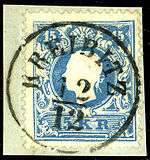
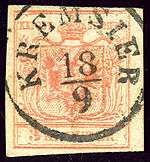
- Kremusch: Křemýž
- Krenau: Křelov
- Krenowitz: Krenovice M,33
- Krenschowitz (Krenschwitz): Chrancovice
- Kreppenschlag (hamlet near Wolletschlag): Křeplice
- Kresane: Kresanov
- Kreschtowitz: Crestovice B,61
- Kretin: see Krzetin
- Kreuz Kosteletz: Kostelec u Krížku
- Kreuzberg: Krucemburk (Kružberk / Kríšová) B,11
- Kreuzberg: Křížová hora
- Kriebaum: Vitěšovice
- Kriebaumkollern: Vitěšovičtí Uhlíři
- Kriegern: Kryry B,64
- Kriegsdorf (bei Römerstadt) (Kreis Bärn) (before 1886: Kriegsdorf bei Freudenthal): (Vojnovice) Valšov M,24
- Kriesdorf: Křižany B,20
- Krinsdorf: Křižanov / Křenov
- Krima: Křimov B,36
- Krimitz: Krimice B,60
- Krinetz: Krinec B,63
- Krippau: Skřipová
- Krips: Křivce
- Krisch: Kříše (earlier Svate Krize u Bras) B,73
- Krischwitz: Děčín XXXI - Krešice
- Krisenitz: Kříženec
- Krisowitz: Křížovice
- Kritschen: Podoli M,3
- Krivsoudov: Kriwsoudow B,45
- Krizanau (also: Krzizanau): Křizanov M,7
- Krizinkau: Krizinkov M,3
- Krnsko: to be identified B,28
- Krochwitz (1849 in Wilsdorf, 1923 part of Bodenbach): Děčín VII - Chrochvice
- Krocehlaw: Kročehlavy part of the city of Kladno B,33
- Krohberg (mountain): Kohout
- Kröna: Křenová
- Krönau (bei Mährisch Trübau): Křenov M,16
- Kromau: Moravský Krumlov
- Krombach über Zwickau: Krompach v Čechách
- Kronau bei Mährisch Trübau: Křenov
- Krondorf: Korunní / Kamenec
- Krondorf-Sauerbrunn: Korunní Kyselka
- Kronland: Lanškroun
- Kronsdorf (bei Jägerndorf): Krasov S,5
- Kronsdorf über Jägerndorf: Kronsdorf u Krnova S,5?
- Kronstadt (in Böhmen): Kunštát u Orlického Záhoří B,81
- Kropfetschlag: Klopanov
- Kropfschlag: Kropšlag, Mýtiny
- Kropitz: Krapice
- Kropsdorf, near Wieles, Bez. Kaplitz: Zábraní
- Krotiv: Krotějov
- Krottensee: Mokřina
- Krauna: Krouna? B,24
- Krugsreuth: Juchle
- Kruh: to be identified B,83
- Krumau, Böhmisch-Krumau, Krummau an der Moldau: (Krumlov) Český Krumlov B,41
- Krumpisch: to be identified M,25
- Krumpüch über Hohenstadt (March): Chromeč
- Kruschowitz: Krušovice (Rakovník District)
- Krzetin (Kretin): Křetín M,2
- Krzisch: Kříše
- Krzy: see Girsch
- Kschemusch: Křemýž
- Krzeschitz: Křešice
- Kschakau: to be identified
- Kscheutz: Kšice
- Kschiha: Číhaná
- Ktowa: Ktová
- Kubany-Urwald: Boubínský prales
- Kubitzen: Česká Kubice
- Kublow: Kublov B,69
- Kubohütten: Kubova Huť
- Kuchelna near Ratibor: Chuchelná
- Kühberg, near Ober Langendorf: Chřepice
- Künast: Sosnová (Česká Lípa District) earlier Sosnová u České Lípy
- Kührberg: Mezihorská
- Kugelwait: to be identified
- Kukan: (Kokonín) Kukonín B,21
- Kuklena: Kukleny B,37
- Kukus: Kuks B,38
- Kulm bei Karbitz: (earlier Chlumec u Chabařovic) Chlumec (Ústí nad Labem District) B,2
- Kulsam: Odrava / Obilná
- Kumerau: Komárov
- Kummer: to be identified
- Kummerpursch: Konobrže
- Kumpatitz: Humpolec
- Kumrowitz: Komárov na Morave Brno M,3
- Kundratiz: Kundratice
- Kunewald bei Zauchtl: to be identified M,19
- Kuniowitz: Kunějovice
- Kunkowitz: Kunkovice
- Kunnersdorf bei Zwickau: Kunratice u Cvikova B,20
- Kunnersdorf bei Friedland in B.: (Kundratice) Kunratice B,19
- Kunnersdorfer Feldhäuser: Kunratické Polní Domky
- Kunowitz: Konovice
- Kunowitz b.Hradisch: Kunovice (Uherské Hradiště District) M,30
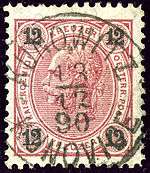
- Kunstadt: Kunštát na Moravě M,2
- Kuntzer: Dešeničký
- Kunwald in Böhmen: Kunvald B,81
- Kunwald: Kunín
- Kunzendorf bei Mährisch Trübau: Kunčina M,16
- Kunzendorf (near Moravský Beroun): Kunčice
- Kupferberg (in Böhmen): Měděnec B,29
- Kupferhübel (mountain): Mědník
- Kurschin: Kořen
- Kurzweil (Schloss): Kratochvíle (palace)
- Kuschwarda: Strážný (earlier Kunžvart) B,66
- Kutsch: Chudec
- Kutscherau: Kučerov M,33
- Kuttelberg: to be identified S,5
- Kuttenberg: Kutná Hora B,42
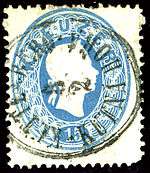
- Kuttendorf: Chotiněves
- Kuttenplan: Chodová Planá B,62
- Kuttenplaner Schmelzthal: Chodovská Huť
- Kuttenschloß: Trhanov
- Kuttenthal: Chotětov B,28
- Kutterschitz: Chudeřice
- Kuttnau: Chotěnov
- Kuttowanka: Chotovenka
- Kuttowitz: Kotovice
- Kwasney: Kvasiny B,71
- Kwassitz: Kvasice M,11
- Kwon: Chbany
- Kysibl: see Giesshübel
L
- Laab (river): Labe
- Laas: Láz (Příbram District)
- Labant: Labuť
- Labau: Horní Libina
- Labau (über Gablonz): Hutí B,21
- Labes: Lobzy
- Lachenwitz, part of Ruckendorf: Lachovice (to be confirmed)
- Lackasee (See): Jezero Laka
- Ladowitz: Ledvice B,16
- Ladung: Loucná / Lesná
- Lämberg: Lvovo (to be confirmed)
- Lagau: Slavkov part of Bohdalovice
- Lahowitz: Lahovice
- Lahrenbecher, part of Unterschlagl: Mlynec
- Laittau (Laitter): Rebrí
- Lammeldorf: Jehnědí
- Lampersdorf: Lampertice
- Lana in Böhmen (Lahna): Lány (Kladno District) (Lany v Cechach) B,76
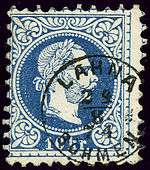
- Landek in Böhmen: Otrocín B,88
- Landschau über Frain: Lančov
- Landshut in Mähren (bei Lundenburg): Lanžhot M,6
- Landskron in Böhmen): Lanškroun B,43
- Landstrassen: Silnice
- Lang Lammitz: Dlouhá Lomnice
- Lang Lhota: Dlouhá Lhota
- Langstrobnitz: Dlouhá Stropnice part of Horní Stropnice B,30
- Lang Ugest: Jenišuv Újezd
- Langenau über Haida: Skalice u České Lípy
- Langenau: Dlouhý Luh B,7?
- Langenberg über Freudenthal: Dlouhá Stráň (partially flooded)
- Langenbruck (b. Franzensbad): Dlouhé Mosty
- Langenbruck, zu Honetschlag gehörend: Olšina
- Langenbruck (Kr. Reichenberg): Dlouhý Most B,72
- Langendörflas: Dlouhý Újezd
- Langendorf: Dlouhá Loučka
- Langendorf: Dlouhá Ves (Klatovy District) B,34
- Langenhauer Hegerhaus:
- Langenlutsch: Dlouhá Loucka
- Langentriebe: Dlouhá Třebová
- Langenwiesen: Dlouhá Louka
- Langgrün: Dlouhý Grün
- Langhaid: Dlohý Bor
- Lang-Pirnitz (Langpirnitz): to be identified M,10
- Lanz: Lomnice u Falknova nad Ohrí B,18
- Lapitzdorf: Lipoltov
- Larischau: Láryšov
- Laschan Desfours: Defurovy Lažany
- Laschanko: Lazanky M,27
- Laschkau: Laškov M,13
- Laschkles: Blažkov
- Laube: Děčín XIII - Loubí
- Laubendorf: Limberk
- Laucha: Louchov
- Laun: Louny B,44
- Launitz: Lounice
- Launowitz (Launiowitz): Louňovice B,3
- Lauterbach (Kaiserwald): Čistá u Rovné (zuvor: Město Litrbachy)
- Lauterbach bei Zwittau: Čistá u Litomyšle
- Lauterbach (bei Falkenau): Čistá u Svatavy B,18
- Lauterbach bei Graslitz: Čirá (earlier: Litrbachy)
- Lauterbach bei Wüstseibersdorf: Potůčník
- Lautersdorf: Čistěves
- Lauterseifen: Pustá Rudná
- Lauterwasser: Čistá v Krkonoších B,23
- Lautsch: Mladeč
- Lautsche: Loučná
- Lautschim: Loučim
- Lautschin: Loučen B,63
- Lautschnei: Loucná
- Lauzana: U Stojzů
- Lazan: Lažany
- Lazy in Schlesien: Lazy w Slazku S,2
- Lechwitz: Lechovice M,34
- Ledau (Leedau, Letau): Letov
- Ledenitz: Ledenice B,10
- Ledererberg (mountain): Stožeček
- Ledetsch (an der Sasau): Ledeč nad Sázavou B,45
- Lehen: Léno
- Leibitsch: Liboc (Prague 6)
- Leibnik: Lipník nad Bečvou
- Leierwinkel: Háje
- Leimgruben: Hlinky
- Leimsgrub: Hliništĕ
- Leipertitz: Litobratřice M,20
- Leipnik: Lipník nad Bečvou M,32
- Leiter: Rebrí
- Leitersdorf: Litultovice S,7
- Leitmeritz: Litoměřice B,46
- Leitomischl (Leuthomischl): Litomyšl B,47
- Lejckov: to be identified B,59
- Lellowa: Lelov to be identified
- Leneschitz: Lenešice B,44
- Leopoldsdorf: Leopoldov
- Leopoldshammer: Leopoldovy Hamry
- Lesche: Leština
- Leschowitz: Lechovice
- Leschtina: Lestina to be identified B,13
- Leskau bei Plan: Lestkov
- Leskau (in Böhmen): to be identified B,88
- Leskau in Mähren: Liskovec na Morave M,3
- Leskenthal: Vítkov
- Lesna: Lesná (district of Brno-City) M,3
- Lesnitz: Lesnice u Zábřeha
- Lessonitz: Lesonice M,14
- Lessau: Lesov
- Lettin: Letiny B,67
- Lettowitz: Letovice M,2
- Lewanitz: Levonice
- Lewin: Levín B,46
- Lhota (near Zdikau): Lhota (Masakova Lhota?)
- Lhota unter Liebtschan: Lhota pod Libčany
- Liban: Libáň B,26
- Libcan: Libcany B,37
- Libejitz: Libejice B,66
- Libeschitz: Libešice u Žatce
- Libeznitz: Libeznice B,32
- Libin: Libyne
- Libinsdorf: Karlov
- Libisch: Libiš / Libhošt
- Libitz an der Zidlina: Libice nad Cidlinou B,63
- Libitz bei Chotebor: Libice u Chtebore B,11
- Liblin: Liblin B,40
- Liboch: Liběchov B,14
- Libochowan: Libochovany
- Libochowitz: Libochovice B,70
- Liboritz: Libořice
- Liboschan: Libočany
- Libotin: Libotyně
- Libotz-Stern: Liboc-Hvezda B,82
- Libschitz: Dobricany / Libešice
- Libschitz an der Moldau: Libsice nad Vltavou B,82
- Libun: to be identified B,80
- Libuschin: Libušin B,76
- Lichten: Lichnov S,4
- Lichtenau (in Böhmen): Lichkov B,81
- Lichtenberg: Studanka
- Lichteneck: Ktiška (Malá Ktiš, Malá Vitiš)
- Lichtenstadt: Hroznětín B,31
- Lichtenstein (Lichtenstain): Moravský Krumlov (Zlín) / Líštany (Písek)
- Lichtenstein über Hannsdorf: Hroznětín
- Lichtewerden (before 1892: Lichtenwerden; also: Lichtward): Světlá S,4
- Lichtwasser (Bach): Světlá
- Liditz: Lidice
- Liditzau: Liticov
- Stadt Liebau: Město Libavá
- Liebauthal: Dolní Libava
- Lieben: Liben B,32
- Liebenau (in Böhmen): Hodkovice nad Mohelkou (Libnov) B,72
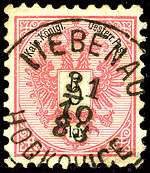
- Liebenstein: Libá (earlier: Libštejn) B,17
- Liebenthal (in Oesterr. Schlesien): Liptál ve Slezsku S,5
- Liebenthal in Böhmen (bei Landskron): Dobrouc Dolni B,43
- Liebenthal (Kreis Bärn): Luboměr
- Liebeschitz bei Auscha: Libešice u Úštěku
- Liebeschitz bei Saaz: Libšice u Žatce B,75
- Liebeschitz bei Leitmeritz: Libešice u Litomeric B,46?
- Liebeswar: Libosváry
- Lieblic: to be identified B,49
- Lieboritz: Libořice
- Liebotschan: Libocany B,75
- Liebshausen: Libčeves B,16
- Liebstadtl: Libstat B,80
- Liebwerda: to be identified B,19
- Liedlhöfen (Siedlhöfen), zu Rothsaifen: Lidlovy Dvory (Sidlovy Dvory)
- Liessnitz: Hradište
- Lieschwitz: Libešovice
- Lihn: Líne / Hlinné
- Liliendorf (bei Znaim): Lesná u Znojma M,34
- Lindau: Lipná / Lipetín
- Lindberg: Lipová
- Linde (Fluss): Lipa
- Linden: Lípa
- Linden (hamlet near Böhmisch Gillowitz): Linda, Machnatec
- Lindenau (in Böhmen) (Kreis Bärn): Lindava / Lipná B,7?
- Lindenhau: Lipová
- Lindewiese: Lipová-Lázně
- Lindig: Lípa
- Lindles: Mlynany
- Lindner Waldhäuser: Lindské Chalupy
- Linkau: Nynkov
- Linschen: Hlince
- Linsdorf: Těchonín
- Lintsch: Hlinec
- Linz: Mlýnec
- Lipen : Lipno nad Vltavou
- Lipkau: Libkov
- Lipkova Voda: to be identified B,59
- Lipnik bei Hrottowitz: Lipnik u Hrotovic M,12
- Lipnitz: Lipnice nad Sázavou B,15
- Lipolz: Lipolec M,4
- Lipowetz: Lipovec (Blansko District) M,2
- Lippelhof: Lipplův Dvůr
- Lippen: Lipno nad Vltavou
- Lipthal: Liptal M,31
- Liquitz: Libokovice v Krušných Horách
- Lischan bei Saaz: Lišany (Louny District) B,75
- Lischau (bei Budweis): Lišov B,10
- Lischin: Líšina
- Lischnei: Líšný
- Lischnitz: Lišnice
- Lischwitz: Libešovice
- Lisek: Lísek
- Liskowetz: Lískovec
- Lispitz: Blízkovice M,14
- Lissa an der Elbe: Lysá nad Labem B,28
- Lissitz: Lysice M,2
- Lissowa: Lisov
- Lititz: Litice nad Orlicí
- Litschau: Ličov, part of Benešov nad Černou
- Litschkau: Líckov
- Littau: Litovel M,13
- Litten: Liteň B,25
- Littentschitz (before 1896: Littenschitz): Litenčice M,11
- Littitz-Werk: to be identified B,60
- Littmitz: Litmice u Chodova
- Lobeditz: Zlovedice
- Lobendau (in Böhmen): Lobendava B,77
- Lobenstein: Úvalno S,5
- Lobes: Lobeč
- Lobeskirchen: Horní Cerekev
- Lobiesching, Gemeinde: Lověšice
- Lobieschinger Ruben, zu Lobiesching: Lovesicke Rovne
- Lobnig: Lomnice u Rýmarova M,24
- Lobnitz: to be identified S,1
- Lobositz: Lovosice B,46
- Lobs: Lobzy
- Loch: Dolina
- Lochowitz: Lochovice B,25
- Lochutzen: Lochousice
- Lodenitz bei Beraun: Lodenice B,25
- Lodenitz (bei Kromau): Loděnice (Brno) (Lodenice u Mor. Krumlova) M,12
- Lodenitz bei Pohrlitz: Loděnice u Pohorelic
- Lösch: Lisen M,3
- Löschna: Lešná M,31
- Lohhäuser: Slatina
- Lohm bei Weseritz: Lomy
- Lohm bei Mies: Lom u Stříbra part of Benešovice
- Lohm bei Tachau: Lom u Tachova
- Lohma: Horní Lomany
- Lometz: Lomec
- Lomisgdorf (über Hohenstadt): Dlouhomilov M,8
- Lomnitz an der Lainsitz: Lomnice nad Lužnicí
- Lomnitz an der Popelka (before 1896: bei Jicin): (Lomnice u Jicina) Lomnice nad Popelkou B,80

- Lomnitz bei Wittingau (Budweis Kreis): Lomnice u Trebone B,93
- Lomnitz in Mähren: Lomnice M,27
- Lonkau: to be identified S,2
- Loosch: Lahošt
- Loosdorf in Böhmen: to be identified B,90
- Lopatne, zu Wullachen: Lopatne
- Losau: Lažany
- Loschitz: Loštice M,8
- Losdorf: Ludvíkovice
- Losnitz: Lazec
- Lossin: Losiná
- Lotschenitz: Ločenice
- Lotschnau (Bömisch Lotschnau): Česká Lučina
- Lotschnau (Mährisch Lotschnau): Moravský Lacnov
- Loucky: Sekerkovy Loucky
- Louznitz: Loužnitz
- Lowtschitz, Lowčitz: Lovcice
- Lub: Luby
- Lubens (earlier: Lubenetz; also: Lubenz): Lubenec B,48
- Lubika: Hluboká nad Vltavou (to be confirmed)
- Luck (Luk): Luka u Verušicek B,48
- Ludgierzowitz (Ludgerstal in 1939-45): Ludgeřovice
- Ludikau: Ludíkov
- Luditz: Žlutice B,48
- Ludwigsberg: Ludvické Hory
- Ludwigsthal (über Würbenthal): Ludvíkov S,4
- Luggau: Lukov u Znojma
- Luhatschowitz: Luhačovice M,29
- Luka: to be identified M,13
- Lukawetz bei Müglitz (über Hohenstadt): Lukavec u Mohelnice M,8
- Lukawetz bei Patzau (before 1894: Lukawec): Lukavec u Pacova B,59
- Lukawitz: Lukavice
- Luken: Luka
- Lukowa: Lukova to be identified (not Albania)
- Lultsch: Lulč M,33
- Lundenburg: Břeclav (Breclava) M,6

- Luppetsching: Kramolín
- Lusading: Horní Kramolí
- Luschan: Lužany (Hradec Králové District)
- Luschan ((Luzan in Böhmen): Lužany (Plzeň-South District) (Luzany v Cechach) B,67
- Lusche:Luže (Chrudim District)
- Luschetz an der Moldau: Lužec nad Vltavou
- Luschitz: Lužice M,6
- Luschtienitz: Luštěnice B,28
- Luschne, near Hoschlowitz: Lužná
- Lusdorf: to be identified B,19
- Lusen (mountain): Lužná
- Lusenbach (Bach): Luzenský Potok
- Lusetin: Buc
- Lutschkahäuseln: Loučky
- Luxdorf: Lukášov
- Luzan in Böhmen: see Luschan B,67
- Luze: to be identified B,24
- Luzetz bei Jenschowitz (before 1890: Jenschowitz): Luzec u Jensovic B,49
M
- Machau: to be identified B,8
- Machendorf: Machnín B,72
- Machowitz: Machovice
- Mader: Modrava
- Maderbach (Bach): Modravsý Potok
- Maffersdorf: Vratislavice nad Nisou (Liberec XXX)
- Mähring: Újezd
- Mährisch Altstadt (before 1896: Altstadt in Mähren; earlier also: Altstadt, Goldeck): Staré Město (Šumperk District) (Staré Město pod Sněžníkem) M,25
- Mährisch Aussee (before 1897: Aussee in Mähren): Úsov M,8
- Mährisch Budwitz: Moravské Budějovice M,14
- Mährisch Chrostau: Moravská Chrastová
- Mährisch Karlsdorf: Moravské Karlov
- Mährisch Kotzendorf: Moravský Kocov
- Mährisch Kromau: Moravský Krumlov M,12
- Mährisch Lotschnau: Moravský Lacnov
- Mährisch Neudorf: Moravská Nová Ves
- Mährisch Neustadt: Uničov M,13
- Mährisch Ostrau: Moravská Ostrava (merged with Schlesisch Ostrau = Slezská Ostrava in 1945 to form Ostrava) M,15

- Mährisch Ostrau Bahnhof: Privoz (Mor. Ostr. Nadr.) M,15
- Mährisch Pisek: Moravský Písek
- Mährisch Pruss (between 1940-45: Mährisch Preußen): Moravské Prusy M,33
- Mährisch Rothmühl (before 1867: Rothmühl): Radiměř (Moravská Radiměř) M,16
- Mährisch Rothwasser (before 1867: Rothwasser): Červená Voda M,8
- Mährisch Schönberg: Šumperk M,25
- Mährisch Trübau: Moravská Třebová M,16
- Mährisch Weißkirchen (before 1867 also: Weiskirchen): Hranice (earlier also, in Latin: Alba Ecclesia) M,32
- Mährisch Weisswasser: Bílá Voda u Šilperka
- Mährisch Wiesen: Dlouhá Ves
- Mährisch Wolfsdorf: Moravské Vlkovice
- Mändrik: Mendryk
- Märzdorf bei Braunau in Böhmen: Martínkovice B,8
- Märzdorf-Nikles: Bohdíkov-Raškov M,25
- Maffersdorf: to be identified B,72
- Maidelberg: Dívčí Hrad S,5
- Maierhof, near Zweiendorf: Humenice
- Maierhof: Humenice part of Horní Stropnice B,30
- Maierhofen: Dvory u Karlových Varů
- Maiersgrün: Vysoká
- Maiwald (Kreis Bärn): Májůvka
- Malec: to be identified B,11
- Malenitz: Malenice B,84
- Malenowitz: Malenovice M,30
- Malesitz: Malesice
- Maleschau (also: Malleschau): Malešov B,42
- Malkau: Málkov (Chomutov District) (Málkov u Chomutova)
- Malhostitz: Malhostice
- Mallinetz: Malinec
- Mallowitz: Malovice (Bor)
- Malnitz ?: (Malenitz?)
- Malonitz: Malonice B,34
- Malotitz: Malotice B,35
- Maloweska: Malá Víska
- Malschen: Malešov
- Malsching: Malšín
- Malsching: Myšlany
- Malschitz: Malsice B,85
- Malspitz: to be identified M,1
- Maltheuern: Záluží v Rudohoří B,9
- Maltsch (Fluss): Malše
- Manetin: Manětín B,40
- Manisch: Manušice
- Mansdorf: Jedvaniny
- Mantau: Mantov
- Maria Kulm: Chlum Svaté Máří (earlier Chlum nad Ohři) B,18
- Maria Ratschitz: Mariánské Radčice B,16
- Maria Schnee beim heiligen Stein: Svatý Kámen nad Malší
- Maria Teinitz: Mariánský Týnec
- Mariafels: Slavice
- Mariahilf über Wostitz: Panny Marie Pomocné u Vlasatice
- Mariaschein: Bohosudov B,2
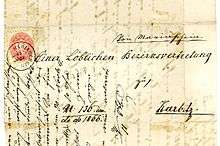
- Mariasorg: Mariánská
- Mariastock: Skoky
- March (Fluss)|March (Fluss): Morava
- Marienbad: Mariánské Lázně B,88
- Marienberg: Ostrava
- Marienthal (bei Olmütz) (Kreis Bärn): Mariánské Údolí M,21
- Markhausen: Pomezna
- Markausch: Markovšovice B,91
- Markersdorf (an der Böhm(isch) Nordbahn): Markvartice u České Kamenice B,90
- Markersdorf a.d. Mähr. Grenzbahn: Hradecná M,13
- Markersdorf am Jeschken: Markvartice pod Ještedem
- Markersdorf: Markvartovice
- Markscheid: Rozdelov
- Markt Bürglitz: Velký Vřešťov
- Markt Eisenstein: Železná Ruda
- Markt Frain: Vratenov
- Markt Janowitz: Vrchotovy Janovice
- Markt Joslowitz: Jaroslavice
- Markt Kamnitz: Trhová Kamenice
- Markt Raigern: to be identified M,1
- Markt Roßwald: Mestys Rudoltice (Slezské Rudoltice)
- Markt Schurz: Žireč Městys
- Markt Stankau: Staňkov I (earlier Městys Staňkov) part of Staňkov (Domažlice District) B,4
- Markt Stiepanau: Trhový Štěpánov
- Markt Türnau (an der Mähr. Westbahn) (before 1899: Türnau in Mähren): Trnávka na Mor. Záp. Dráze M,16
- Markus zu Krizowitz: Markov or Marky
- Markusgrün: Podlesí
- Markwarding: Markvarec
- Marletzgrün: Květnová
- Marletzgrün: Maroltov
- Maroditz: Martice
- Marschendorf: Maršíkov B,91?
- Marschendorf: Dolní Maršov / Maršov / Horní Maršov B,91
- Marschowitz: Maršovice B,3
- Martetschlag: Martínkov
- Martinau: Martinov
- Maschakotten: Maršovy Chody
- Maschau: Mašťov B,64
- Maschker Mühle: Maškův Mlýn
- Maßhaupt: Kročehlavy
- Mastig: Mostek nad Labem
- Mastirowitz: Mastírovice
- Mastung: Mostec
- Matschitz: Mačice
- Matschowitz: Mačovice
- Matzdorf bei Bielitz: to be identified S,1
- Mauth (also: Mauthstadt): Mýto B,73
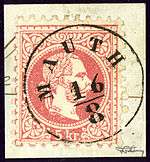
- Mauthaus: Mýtnice
- Mauthdorf: Mýto
- Maxdorf: Děčín XVIII - Maxicky
- Maxhof: Maxov
- Mayerbach: Dolní Borková
- Mayerhof: Horní Stropnice
- Mazocha: Macocha
- Medleschitz: Medlesice B,12
- Meeden: Medná
- Meedl: Medlov
- Meedl (bei Deutsch Liebau): Medla M,13
- Mehregarten: Mergart, Zahradky
- Meierhöfen: Dvory
- Meigelshof: Chodov
- Meinetschlag: Malonty B,30
- Meisetschlag: Míšnany
- Meistersdorf: Mistrovice B,90
- Melchiorshütte:
- Melhut: Chodská Lhota
- Melm: Jelm
- Melmitz: Melnice
- Melnik: Mělník B,49
- Meltsch (über Troppau): Melč S,7
- Menian: Menany
- Meretitz: Miretice
- Merkelsdorf: Merklovice B,8
- Merkelsgrün: Merklín B,27
- Merklin: Merklín u Preštic B,67
- Meronitz: Merunice
- Merowitz: Merovice M,22
- Merschlitz (also: Merzlitz): Mrzlice
- Merzdorf: Martinice B,83
- Mesimost: Mezimostí nad Nežárkou
- Mesletsch: Mezilečí
- Mesoles: Mezholezy u Kutné Hory
- Messendorf über Freudenthal:
- Meßhals: Mezholezy u Horšovského Týna
- Meßholz: Mezholezy u Černíkova
- Mestska Lhotka: Městská Lhotka
- Metilowitz: Metylovice M,17
- Metzling: Meclov
- Mezritz: Mezirici (before 1893: Meziric) B,57
- Michalkowitz: Michalkowice S,2
- Michelob (also: Miecholup): Měcholupy u Zatce B,75
- Michelsberg: Michalovy Hory B,62
- Michelsdorf: Veliká Ves
- Michelsdorf: Ostrov
- Michetschlag: Javoří
- Michle: to be identified B,39
- Miedschin: Mecin B,67
- Mies (in Böhmen): Stříbro B,50
- Miesau(Ebenau), zu Christianberg gehörend: Vyšný
- Miesau: Arnoštov
- Mieschitz: Mesice B,32
- Miezmanns: Micmanice
- Milau: Milov
- Milay: Mila
- Milbes (Kreis Bärn): Milovany
- Mildenau: Luh pod Smrkem (''earlier also:'' Mildenava)
- Mildeneichen: Lužec pod Smrkem
- Mileschau bei Seltschan: Milešov u Lovosic B,52
- Miletin (Milletin): Miletin B,37
- Miletitz: Miletice
- Milikau: Jezerce
- Milleschau (Mileschau): to be identified B,46
- Milikau: Milkov
- Milin (before 1867: Millin): Milín B,68
- Militschowes: Milicoves B,26
- Millek: Milence
- Milles: Mlýnec pod Přimdou (now Ortsteil von Přimda)
- Millestau: Milhostov
- Millik: Milence
- Millotitz (an der Betschwa): Milotice nad Bečvou M,5?
- Milonitz: Milonice M,33
- Milotitz: Milotice u Kyjova
- Millowitz über Eisgrub: Milovice nad Dyjí
- Milsau: Milžany
- Miltigau: Milíkov B,62
- Miltschin: Milcin B,85
- Miltschitz: Milčice
- Minion (Minien, Miniendorf): Měnany
- Minichschlag: Martínkov
- Minichschlag abandoned village in Kienberg bei Hohenfurth: Mnichovice part of Loučovice
- Minkwitz: Minkovice
- Mireschau: Mirošov
- Mirikau: Mírkov
- Mirischau (Miröschau): Mirošov
- Mirkowitz: Mirkovice
- Miröschau: Mirošov (Mirosovy) B,73
- Miroschowitz: Mirošovice
- Mirotitz: Mirotice B,61
- Mirowitz: Mirovice B,61
- Mirschikau: Mířkov
- Miskowitz: Myslkovice (Miskowice) B,85
- Misliboritz: Mysliborice M,12
- Misloschowitz: Mysločovice M,9
- Misslitz: Miroslav M,12
- Mistek: Místek M,17
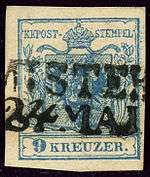
- Mistlholz, Mistelholz: Borová
- Mistlholzkollern (zu Mistlholz): Borovsti
- Mittagsberg (mountain): Poledník
- Mittel Körnsalz: Prostřední Krušec
- Mittel Langenau: Prosrední Lánov B,23
- Mittelgrund: Děčín XV - Prostrední Žleb (Prostřední Grunt)
- Mittelhof: Prostřední Dvůr
- Mittellangenau: Prostřední Lánov
- Mittelwald (Kreis Bärn): Středolesí
- Mittendorf (Mitterdorf): Miroslav
- Mitterberg: Račí
- Mladejov: to be identified B,26
- Mladetzko: Mladecko S,7
- Mladotitz: Mladotice
- Mlazow: Mlazovy
- Mlazowitz: Mlazovice B,37
- Mlikowitz: Mlékovice
- Mnich: to be identified B,59
- Mnichowitz (Mnichowic): Mnichovice B,94
- Mnienan: Měnany
- Mnischek: Mnisek B,82
- Mochau (Mochow): Mochov B,6
- Model (Fluss): Modla
- Modlan: Modlany
- Modlenitz, zu Rabitz: Modlenice
- Modschiedl: Mocidlec
- Mödlau über Pohrlitz: Medlov nad Jihlavkou
- Mödlitz (Kreis Bärn): Medice
- Modran: Modrany B,82
- Mödritz: Modrice M,3
- Mönitz: to be identified M,1
- Möritschau: Mořičov
- Mörowitz, zu Wadetschlag: Moravice
- Mösing: Mezi
- Mohelno: Mohelno M,28
- Mogolzen: Bukovec
- Mohr: ory
- Mokowitz: Hřivinov
- Mokrau: Mokrá
- Moldau (Fluss): Vltava
- Moldau (Ort): Moldava v Krušných horách B,89
- Moldauquelle: Pramen Vltavy
- Moldaustausee Lipen (See): Lipenská přehrada
- Moldaustausee Orlik (See) (Orlík-Talsperre): Orlická přehrada
- Moldautein (Moldauthein): Týn nad Vltavou B,51
- Moorkopf (mountain): Malá Mokrůvka
- Moraschitz: Morašice B,47
- Morawan: Moravany B,58
- Morawetsch bei Pilgram: Moraveč
- Morawetz: Moravec M,18
- Morawitschan (über Möglitz): Moravicany M,8
- Morchenstern (Morchelstern??): SmržovkaB,21
- Moritz an der Hanna: Morice na Hane M,22
- Morkowitz: Morkovice M,11
- Moschen (GBez. Bilin): Mošnov
- Mosetstift: Mackova Lhota (Muckova Lhota)
- Mosting: Mostice
- Mostkowitz bei Prossnitz: Mackovice M,23
- Mostau: to be identified B,17
- Mosty in den Beskiden: Mosty u Jablunkova
- Mottlhof: Mottlovské Dvory
- Mottowitz: Matejovice
- Motzdorf: Mackov
- Mscheno bei Melnik (before 1894: Mscheno): Mšené Lázne (Litomeřice) / Mšeno (Mělník) B,49
- Mschenolobes: Mšeno (Lobec)
- Mscheno bei Budin: Mšeno u Budyne B,70
- Mottowitz: Matejovice
- Mraditz: Mradice
- Mrakotin: to be identified M,4
- Muckenschlag: Muckenschlag (Mükenschlag)
- Müglitz: Mohelnice M,8
- Mühlbach: Pomezí nad Ohrí
- Mühlberg: Lesík
- Mühlberg: Mlynsky Vrch
- Mühldorf abandoned village in Kienberg bei Hohenfurth: Mlýnská part of Loučovice
- Mühlendorf: Okounov
- Mühlessen: Milhostov
- Mühlgrün: Mlýnek (to be confirmed)
- Mühlfraun: Milfron
- Mühlhäuseln: Mlýnské Domky
- Mühlhausen an der Moldau: Nelahozeves B,76
- Mühlhausen (bei Tabor): Milevsko B,52
- Mühlhöfen: Milevo
- Mühlloch: Mílov
- Mühlloh: Milov
- Mühlnöd, near Wadetschlag: Milná
- Mühlscheibe: Filipov
- Müllerschlag, also Mlinarowitz: Mlynářovice
- Müllersgrün: Milesov
- Mülln: Štedrá
- Mühlnöd: Milná
- Münchengrätz: Mnichovo Hradiště B,53
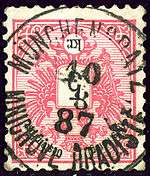
- Münchleins: Minisek
- Münchner Schlucken (cultural monument): Mnichovská průrva
- Münchsberg: Vojnův Mestec
- Münchsdorf: Hvoždany
- Münkendorf: Minkovice
- Münchsfeld: Mnichovství
- Mürau: Mírov M,8
- Mugrau: Mokrá
- Mukowa: Bukova ?
- Multerberg: Multerberg
- Multerberger Waldhäuser (part of Heuraffl): Chalupy Multerberske
- Muncifai: see Smecno
- Munker, Mukarov (?): Mukařov
- Munzifai: Smečno
- Murchova: Mrchojedy
- Muschau: Mušov nad Dyjí M,20
- Muschelberg: to be identified
- Muslau, Mußlau: Muzlov deconstructed location
- Mutenitz: Mutenice M,6
- Mutowitz (Mutiowitz): Mutějovice B,69
- Muttersdorf: Mutěnín
- Mutzgern, Mutzken: Muckov
N
- Nabsel: Bzí / Nabzí
- Nachles, zu Wadetschlag: Nahlov
- Nachod: Náchod B,54
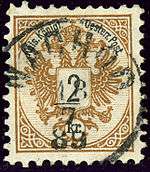
- Nadejkau: Nadejkov B,79
- Nadschow: Hnacov
- Nakl: Náklo M,13
- Nakri: to be identified B,10
- Namiescht in der Hanna (bei Ollmütz): Námešť na Hané (Namest u Olomouce) M,21
- Namiest an der Oslawa: Námešť nad Oslavou (Namest u Brna) M,28
- Napajedl (before 1867: Napagedl): Napajedla M,30
- Nassaberg: Nasavrky (Chrudim District) B,12
- Nassenbart: Mokrovousy
- Nassengrub: Mokřiny
- Natscheradetz: Nečeradec B,3
- Natschung: Načetín B,36
- Nausowa: Nouzov
- Nawsi: Návsí u Jablunkova S,6
- Nebahau: Nebahovy
- Nebillau: Nebílovy
- Nebotein: Hnevotin M,21
- Nebuzel: to be identified B,49
- Nechanitz: Nechanice B,37
- Nechwalitz: Nechvalice
- Nedakonitz: to be identified M,30
- Nedraschitz: Nedražice
- Nedwieditz: Nedvedice M,27
- Neiße (Fluss): Nysa
- Nekor: to be identified B,81
- Nemcitz bei Klattau: to be identified B,34
- Nemcitz bei Wolin (Niemschitz bei Wollin): Nemcice u Volina B,84
- Nemelkau: Nemilkov
- Nemetzky: Nemecke M,18
- Nemischl: Nemyšl
- Nemtschitz: Němčice, Horní Němčice
- Neosablitz: Nezabylice
- Neplachowitz: Neplachovice S,7
- Nepomischl: Nepomyšl
- Nepomuk: Capartice
- Nepomuk: Nepomuk (Nepomuky) B,67
- Neratowitz: Neratovice B,32
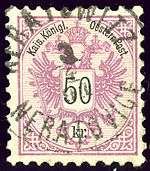
- Nesdaschau (Nesnaschau, Nsnaschow): Neznašov
- Nesdenitz: Nezdenice
- Nespitz, Bez. Strakonitz: Nespice
- Nespoding: Mezipotočí
- Nesselbach: Větřní
- Nesselsdorf: Kopřivnice M,19

- Nestersitz: to be identified B,2
- Nestomitz: Neštěmice
- Netolitz (before 1867: Nettoliz): Netolice B,66
- Netrobitz: Netřebice
- Netschetin: Nectiny
- Netschemitz: Nečemice
- Netschetin: Nectiny B,40
- Netschin: Necín
- Nettin: Netin M,7
- Networitz: Netvorice B,3
- Neu Benatek (Neubenatek): Nové Benátky B,28
- Neu Bistritz (before 1867: Neubistritz): Nová Bystřice B,56
- Neubrunn: Nová Studnice
- Neubusk: Nová Boubská
- Neu-Bydzow (before 1867: Neubidschow): Nový Bydžov B,55
- Neu Cerekwe, Neu Zerekwe: Nová Cerekev B,59
- Neudek (in Böhmen): Nejdek B,22
- Neudörfel, zu Andreasberg: Nová Víska ?
- Neudörfl (Kreis Bärn): Nová Véska Olomouc District? Battle of Domašov?
- Neudorf an der Popelka: Nová Ves nad Popelkou (Semily District B,80)
- Neudorf bei Bautsch (Kreis Bärn): Nova Oldrůvky (before 1924: Nová Ves) M,26
- Neudorf bei Gablonz: to be identified B,21
- Neudorf bei Lundenburg: Moravská Nová Ves (Nova Ves u Breclavy) M,6
- Neudorf bei Petschau: to be identified B,31
- Neudorf bei Ungarisch-Ostra: Ostrožská Nová Ves M,30
- Neudorf: Nová Ves (Chomutov, Rakovník, Skalná) ?
- Neueigen (Kreis Bärn): Nová Ves
- Neuenbrand: Nový Ždár
- Neuenburg an der Elbe (also: Nimburg): Nymburk
- Neu Erbersdorf: to be identified S,4
- Neuern: Nýrsko B,34
- Neufürstenhütte: Nová Knížecí Huť
- Neugarten: Zahrádky u České Lípy
- Neugasse bei Olmütz: Nova Ulice u Olomouce M,21
- Neugebäu: Nový Svět (Borová Lada)
- Neugedein: Kdyně (Nova Kdyn) B,87
- Neugeschrei: Nové Zvolání
- Neugramatin: Nový Kramolín
- Neu Haimhausen: Nový Haimhausen
- Neuhammer: Nové Hamry B,éé
- Neuhäusel, zu Schönfelden gehörend: Nové Domky
- Neuhäuser (b. Schatzlar): Nové Stavení, Nové Domky
- Neuhäuser: Nové Chalupy
- Neuhaus (in Böhmen): Jindřichův Hradec B,56
- Neuhof (bei Kuttenberg): Nový Dvur (Nove Dvory) B,42
- Neu Hradek (Neuhradek): Novy Hradek B,57
- Neu Hrosenkau (before 1884: Neu Hrosinkau): Novy Hrozenkov M,31
- Neuhüblern: Nová Houžna
- Neuhütten: Nové Hutě
- Neuhurkenthal: Nová Hůrka
- Neu Hwiezdlitz: Nove Hvezdlice M,33
- Neulangendorf: Nová Dlouhá Ves
- Neuofen: Nová Pec (z větší části)
- Neuofen-Habersdorf: Nová Pec-Ovesná
- Neukirchen (bei Eger): Nový Kostel B,17
- Neu Knin: Nový Knín B,68
- Neu Königgrätz: Novy Hradek Kralove B,37
- Neulosimthal: Jedlina
- Neumark (bei Taus): Všeruby u Kdyně B,87
- Neumarkt (bei Weseritz): Úterý B,88
- Neumettl (Neumittel): Neumětely
- Neu Mitrowitz: Nove Mitrovice B,60
- Neu Oderberg: Bohumín
- Neuötting: Nová Včelnice B,59
- Neuötting-Vtschelnitz: Nová Včelnice
- Neupaka: Nová Paka B,26
- Neu Paulsdorf: to be identified B,72
- Neu Possigkau: Díly
- Neu Prennet: Nový Spálenec
- Neuprerau: Nový Přerov
- Neu Raußnitz (before 1867: Neu-Rausnitz): Rousínov u Vyškova (Novy Rousinov) M,33
- Neu Reichenau: Nový Rychnov B,59
- Neureisch: Nová Říše M,4
- Neu Rettendorf: to be identified B,38
- Neurode : Nová Pláň
- Neu Rohlau: Nová Role
- Neusattl bei Elbogen: Nové Sedlo u Lokte B,18
- Neu-Sazawa: to be identified B,40
- Neuschloß bei Böhmisch Leipa: Nové Hrady B,7
- Neuschloss bei Hohenmauth: Nové Hrady u Vis. Myta B,24
- Neu Serowitz: Nové Syrovice M,14
- Neusiedl in Mähren: Novosedly M,20
- Neusorge: Starostín
- Neuspitzenberg: Nový Špičák
- Neustadl am Klinger: Stráž (to be confirmed)
- Neustadt an der Tafelfichte: Nové Mesto pod Smrkem (Liberec District) B,72?
- Neustadt an der Mettau: Nové Mesto nad Metují B,57
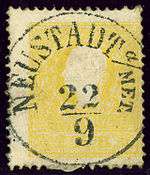
- Neustadtl: Nové Mestecko to be identified
- Neustadtl bei Arnau: to be identified B,23
- Neustadtl bei Friedland: to be identified B,19
- Neustadtl bei Haid: to be identified B,86
- Neustadtl bei Plass: see Böhmische Neustadtl bei Plass B,40
- Neustadtl in Mähren: Nové Mesto na Morave M,18
- Neustadtl (b. Böhmisch Leipa): Jezvé (part of Stružnice) B,7?
- Neustadtl (b. Chlumetz a.d. Zidlina): Nové Mesto B,55?
- Neustadtl (b. Pfraumberg): Stráž B,86?
- Neustift: Nové Sady Slovakia!
- Neustift: Lhota (Mladoně)
- Neustift (bei Irresdorf): Nová Lhota (Lštín) (to be confirmed)
- Neustift (bei Planles) (part of Irresdorf): Polecnice or Spolecnice
- Neustift bei Olmütz: to be identified M,21
- Neustraschitz: Nové Strašecí B,76
- Neustupow: Neustupov B,79
- Neuteich: Nový Rybník
- Neuthal: Nové Údolí
- Neutitschein (Neu Titschein): Nový Jičín M,19

- Neu Traubendorf: Nový Hrozenkov
- Neu Tschestin: Nový Cestín
- Neu Ullersdorf: Losina Nova M,25
- Neuwallisdorf: Nová Ves
- Neuwaltersdorf (Kreis Bärn): Nové Valteřice
- Neuwelt: to be identified B,83
- Neu Wessely: Nové Veseli M,18
- Neuwirthshaus: Nová Hospoda B,32
- Neu Zedlitsch: Nové Sedlište
- Neu Zerekwe: Nová Cerekev
- Neweklau: Neveklov B,3
- Nezamislitz: Nezamyslice M,22
- Nezdenitz: Nezdenice M,29
- Neswiestitz: Nesvestice B,60
- Neweklau: Neveklov B,3
- Nezamislitz: Nezamyslice M,22
- Nezdenitz: Nezdenice M,29
- Nezwiestitz: Nezvestice B,60
- Nidaus: Švermov-Hnidousy (1957 within Motitschin as Švermov)
- Nieder Altstadt (b. Trautenau): Dolní Staré Mesto
- Nieder Bausow: Dolní Bousov
- Niederbirkicht: Podbřezí
- Nieder Bludowitz : Dolní Bludovice (Bludovice in 1960) S,6
- Nieder-Einsiedl (Niedereinsiedel): Dolní Poustevna B,77
- Nieder Eisenberg (before 1897: Eisenberg an der March): Dolní Ruda M,25

- Nieder Falkenau: Dolní Falknov
- Nieder-Georgenthal (Niedergeorgenthal): Dolní Jiřetín B,9
- Nieder Grund (a.d. Böhm. Nordbahn) (before 1883: Niedergrund bei Warnsdorf): Dolní Podluží B,74
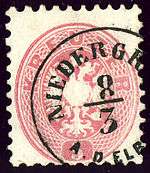
- Niedergrund an der Elbe: to be identified B,90
- Nieder-Hermersdorf bei Mähr. Schönberg: to be identified M,25
- Nieder Hillersdorf: Dolní Holcovice S,5
- Niederhof: Dolní Dvůr B,23
- Nieder Kolbitz: Chobolice
- Nieder Langenau: to be identified B,23
- Nieder Leuten: see Deutsch Leuten S,2
- Nieder-Leutensdorf: to be identified B,9
- Niederliebich: Dolní Libchava
- Nieder Lindenwiese: Lipové Lázně S,3
- Nieder Mohrau bei Römerstadt (Niedermohrau): Dolní Moravice M,24
- Nieder-Ohlisch: to be identified S,1
- Niederreuth: Dolní Paseky
- Nieder Rochlitz: Rokytnice nad Jizerou (Dolni Roketnice) B,83
- Nieder-Tierlitzko: to be identified S,6
- Niedertscherma: Dolní Čermná
- Niederullersdorf: Dolní Oldřiš B,81
- Niemes: Mimon B,7
- Niemtschitz b. Boskowitz (bei Nezamislitz, bei Kojetein)): Němčice (Němčice u Nezamyslice) M,22
- Nikl: Mikulec B,47
- Niklasberg: Mikulov v Krušných horách B,89
- Niklasdorf in Schlesien: Mikulovice u Jeseníku S,3
- Niklowitz: Mikulovice M,34
- Nikolsburg: Mikulov na Morave M,20
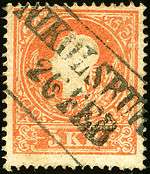
- Nimburg: Nymburk B,63
- Nimlau: to be identified M,21
- Nimvorgut: Nuzarov
- Ninowitz: Jinonice
- Nirschlern, zu Ziering, Bez. Kaplitz: Nirschlery, Koryta ?
- Nischburg: Nižbor B,69

- Nischkau: Nižkov B,15
- Nitzau: Nicov
- Niwnitz: Nivnice M,29
- Nixdorf: Mikulášovice B,77
- Nollendorf: Nakléřov
- Nothof: Nouzov
- Neustadtl: Dolní Bělá (Písek)
- Nowakowitz: Novakovice
- Nudelbaum: Modlibohov
- Nürnberg: Norberčany
- Nürschan (Nyrschan): Nýřany B,50
- Nuserau: Nuserov
- Nusle: to be identified B,39
- Nußlau: Nosislav
O
- Ober Altstadt (b. Trautenau): Horní Staré Mesto B,91
- Ober Baumgarten: to be identified B,56
- Ober Berschkowitz (Ober Berkowitz): Horní Berkovice B,70
- Ober-Betschwa: Horní Becva M,31
- Ober Birken: Horní Bríza
- Ober Bludowitz: Horní Bludovice S,2
- Ober-Borry: Horní Bory M,7
- Ober Bris: Horní Briza B,60
- Ober Cerekwe (before 1867: Ober Zerekwe; also: Oberzerekwitz): Horní Cerekev
- Ober Chodau: Horní Chodov
- Ober-Dannowitz: to be identified M,34
- Ober Domaslowitz: Horní Domaslovice S,6
- Oberdorf bei Komotau: to be identified B,36
- Ober Dubenky: Horní Dubenky M,4
- Ober Einsiedl: to be identified B,77
- Oberfröschau: Horní Breckov
- Obergallitsch: Horní Kalište
- Obergeorgenthal: Horní Jiretín (Jiretín Horejsi) B,9
- Ober-Gerpitz: to be identified M,3
- Oberhäuser (part of Johannesthal): Rohy
- Oberhaid: Horní Dvorište B,30
- Oberhaid: Zybytiny
- Ober Hammer: Horejsi Hamr B,80
- Ober Heinzendorf: Horní Hyncina
- Ober Hermsdorf in Schlesien: to be identified S,3
- Ober Hillersdorf: Horní Holcovice
- Ober Hohenelbe: Horejší Vrchlabí B,23
- Ober Hrachowitz: Dolní Hrachovice
- Ober-Jeleni: Horní Jeleni B,24
- Ober Koblitz: Chobolice
- Oberkörnsalz: Horejší Krušec
- Ober Kozolup: Horní Kozolupy
- Ober Kralowitz: Horní Kralovice
- Ober Kreibitz: Horní Chribská B,74
- Ober Kurzwald: to be identified S,1
- Ober Langenau: to be identified B,23
- Ober Langendorf: Horní Dlouhá
- Oberleutensdorf (before 1867: Oberleitensdorf): Litvínov B,9
- Ober Lhotta: Horni Lhota M,9
- Oberlichtbuchet: Horní Svetlé Hory (Horní Lichtbuchet)
- Oberlitsch: Horní Lidec (Horní Lic) M,29
- Ober Lohma: Horní Lomany
- Obermarkschlag: Horní Hranicná (Horní Markschlag, Horní Marktschlag)
- Obermoldau: Horní Vltavice, also: Horejší Vltavice B,66
- Ober Moschtienitz: Horni Mostenice M,22
- Oberndorf (b. Franzensbad): Horní Ves
- Ober Neuern: Horní Nýrsko
- Oberniemtsch: Horní Nemcí
- Obernitz: to be identified B,9
- Oberoggold: Horní Okolí
- Oberplan: Horní Planá B,41
- Ober Pocernic (Ober Potschernitz, Ober Pocernitz): Horní Pocernice B,32
- Ober-Politz: to be identified B,7
- Oner-Praussnitz (Ober-Prausnitz): to be identified B,23
- Ober Preschkau: to be identified B,90
- Oberreuth: Horní Paseky
- Oberringelberg: Horní Výšina
- Oberrosenthal: Horní Ružodol (Liberec VII)
- Ober Roschlitz (before 1867: Rochlitz): Rokytnice nad Jizerou
- Ober Rotschau (Ober Rotschow): Rocov (Horni Rocov) B,44
- Obersablat: Horní Záblatí
- Ober Sandau: Horní Žandov
- Obeschitz: Sobešice
- Oberschlag: Milešice
- Oberschlagl: Horní Drkolná, also: Horní Schlagl
- Oberschneedorf: Horní Snežná
- Oberschönhub: Horní Prísahov, also: Horní Schönhub
- Obersinetschlag: Horní Príbraní (Horní Sinetschlag)
- Oberstankau: Horní Stankov
- Ober-Stefanau (Ober Stephanau): Horní Stepanov M,16
- Obersteindörfl: Zbraslav (Horní Steindörfl)
- Ober Studenetz: Horní Studenec B,11
- Ober-Suchau (Obersuchau): Horní Suchá S,2
- Ober Tannwald: to be identified B,21
- Ober Thomasdorf (bei Freiwaldau): to be identified S,3
- Ober Toschonowitz: Horní Tošanovice (Polish name used in 1881:Toszonowice Gorne) S,6
- Ober Uresch: Horní Ureš (Horní Uráž)
- Obervollmau: Horní Folmava
- Ober-Wernersdorf (Wernersdorf bei Starkstadt 1891-1898): to be identified B,8
- Ober Wigstein: to be identified S,7
- Ober Wildgrub: to be identified S,4
- Ober Zahori: Horní Zahori B,61
- Oberzassau: Horní Cazov (Horní Zasov)
- Ober Zerekwe: see Ober Cerekwe
- Obetznitz: Obecnice B,68
- Oblas: to be identified M,34
- Obristvi: to be identified B,49
- Obrowitz: Zábrdovice
- Oder(Fluss): Odra
- Oderberg: Bohumín S,2
- Oderfurt: Přívoz
- Odersch: Oldřišov
- Odolenswasser: Odolena Voda
- Odrau: Odry S,7
- Oed: Poustka
- Ölberg: Olevetín
- Öls in Böhmen: to be identified (post-office closed in 1858)
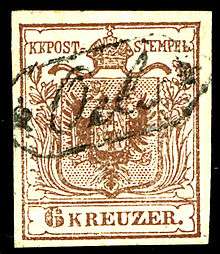
- Oels in Mähren: Olešnice M,2
- Ölstadtl (near Bärn): Olejovice (earlier: Olštatl)
- Oemau: Soběnov
- Ogrodzon: Ogrodzona S,6
- Ogfolderhaid (Ogfolder-Haid): Jablonec
- Oggold: Okolí
- Ogrodzon: Ogrodzona, Silesian Voivodeship S,6 (now in Poland)
- Ohren: Javory
- Ohrensdorf: Střítež nad Ludinou M,32
- Oiberg: Vltava
- Ojesdetz (Ojestetz, Ojestitz, Ojezd, Ojezdetz): Újezdec
- Okrischko (also: Okrizko): Okriško M,28
- Okrouhlík: Mělník
- Okrouhlitz: Okrouhlice B,15
- Olbersdorf in Mähren: Albrechtice u Lanškrouna
- Olbersdorf (in Schlesien): Město Albrechtice S,5
- Olbramowitz: Olbramovice u Votic
- Olchowitz: Oldřichovice
- Olhotta: Lhota
- Olmütz: Olomouc M,21
- Olschan: Olsany M,23
- Olschi: Olši M,27
- Ondrejow: Ondřejov ? B,6
- Opatowitz (earlier: Oppatowitz): Opatovice B,58
- Opolau: Úpohlavy
- Opotschna bei Laun (before 1895: Opotschna bei Saaz): Opočno B,75
- Opotschno: Opočno pod Orlickými horami B,57
- Oppatau: Opatov M,28 (to be confirmed)
- Oppau: Zábřeh
- Oppelitz, zu Duschowitz: Opolenec
- Oppolz: Tichá
- Orlau: Orlová S,2 (Polish: Orlowa)
- Orlowitz: Orlovice M,33
- Oschelin: Ošelín
- Oschitz: Osečná B,7
- Oskau: Oskava M,13
- Oslawan: Oslavany M,3
- Ossegg: Osek B,16
- Ossek bei Leipnik: to be identified M,32
- Osser (mountain): Jezerní Hora
- Oßnitz, Rotte, zu Obergallitsch: Osnice
- Ossowa Bittischka: Osová Bítýška M,7
- Oswietiman: Osvietimany M,5
- Otrokowitz: Otrokovice M,30
- Ottau (part of Lobiesching): Zátoň
- Ottendorf in Böhmen : Otovice u Broumova
- Ottendorf bei Troppau: Otice S,7
- Ottengrün: Otov
- Ottenschlag: Otov
- Ottenschlag: Otín
- Ottetstift: Otice
- Ottnitz: Otnice M,33
- Ottowitz: to be identified B,31
- Ouherce: Úherce
- Oujezdec: Újezdec
- Ouraz: Úraz
P
- Palitz: Palič
- Palkowitz: Palkovice M,17
- Pamferhütte: Pamferova Huť
- Panditz: Bantice
- Panzer (part of Eisenstein): Pancíř
- Panzer (mountain): Pancíř
- Pappelsdorf: Topolná
- Parchen-Schelten: to be identified B,90
- Pardorf: Bavory
- Pardubitz: Pardubice B,58

- Parfuss: to be identified M,3
- Parkfried: Bělá to be identified
- Parnik (Parnig): Parník B,43
- Parschnitz: Poříří u Trutnova B,91
- Parshowitz: Paršovice M,32
- Partschendorf: to be identified M,19
- Paschtik: Paštiky
- Paskau: Paskov M,17
- Paß: Horní Sedlo
- Passek: to be identified M,13
- Passeken, zu Neugebäu: Paseka
- Passern: Pasovary
- Paterhütte: Páteřlkova Huť
- Patokrey: Patokryje
- Patzau: Pacov B,59
- Paulina: Pavlína
- Paulowitz bei Olmütz: Pavlovičky (Pavlovice u Olomouce) M,21
- Paulusbrunn: to be identified B,86
- Pausram: Pouzdřany M,20
- Pauten: Poutnov
- Pawlikow: Pavlikov B,69
- Pawlowitz bei Nezamislitz (earlier: bei Leipnik): Pavlovice u Nezamyslic M,22
- Pcher: Pchery B,76
- Pecek (an der Staatsbahn): Pecky (Pecky na Statni Draze) B,63
- Petzka (in Böhmen): Pecka B,26
- Pelechen: Pelechy
- Pelleritz: Boleradice
- Penketitz, zu Hörwitzl: Beníkovice
- Perletschlag: Perlovice
- Perlsberg: Lazy
- Pernartitz (Pernatitz): Bernatice
- Pernstein: Pernštejn (Pernštýn)
- Perutz: Peruc B,44
- Perschetitz: Horní Brzotice (Německé Brzotice, Německá Brotice)
- Peterbach: Petrov
- Petersburg in Böhmen: Petrohrad B,64
- Peterschlag, zu Christelschlag: Petrovice
- Petersdorf bei Trautenau: Petrov nad Desnou B,91?
- Petersdorf bei Zöptau (bei Mähr. Schönberg, a/d Hohenstadt): to be identified M,25
- Petersdorf in Schlesien: to be identified S,5
- Petershofen: Petrkovice
- Petersin: Petříkov
- Peterswald: see Gross-Peterswald
- Peterswald in Böhmen: Petrovice u Chabařovic B,2
- Petlarn: Žebráky
- Petrowitz bei Freistadt (in Schlesien): Petrovice (earlier: Pietrowice S,2
- Petrowitz bei Rakonitz: Petrovice u Rakovníka B,69
- Petrowitz bei Schüttenhofen (before 1895: bei Hartmanitz): Petrovice B,78
- Petrowitz bei Selcan (bei Seltschan): Petrovice u Sedlcan B,79
- Petrowitz bei Wagstadt: Pustejov S,8
- Petrowitz: Petrovice u Blanska
- Petrowitz an der Angel: Petrovice nad Úhlavou
- Petschau: Bečov nad Teplou B,31
- Petschkau: Pecky (Petschek) B,35
- Petzer: to be identified B,91
- Petzka: Pecka
- Pfaffengrün: Popovice
- Pfaffenschlag: Bobovec
- Pfefferschlag: Libínské Sedlo
- Pflanzen: Blatná
- Pflanzendorf: Hřivcice
- Pfraumberg (Pfrauenberg): Přimda B,86
- Philippsberg: Filipova hora
- Philippshütte: Filipova Huť
- Philippsthal: Filipová
- Philippsthal: Filipovka
- Piberschlag: Pivonice
- Pibrans: Příbram
- Pichlern: Pihlov
- Piesling: Písecné M,14
- Pießnig: Písečná
- Pilgram (in Böhmen) (earlier also: Wolframszell): Pelhřimov B,59
- Pilkau: Bílka
- Pilletitz, zu Hörwitzl: Bílovice (Býlovice) ?
- Pilnikau: Pilníkov B,91
- Pilsen: Plzeň B,60
- Pilsenetz: Plzenec B,60
- Pilsenhof: Plzenec
- Pilsenschlag: Polzov
- Pinke (bei Mährisch Neustadt): Benkov (u Uničova)
- Pinketschlag, zu Mauthstadt: Skalne
- Pirkau: Březí
- Pirkenhammer: to be identified B,31
- Pirles: Brložec
- Pirnik (bei Mährisch Neustadt): Brníčko (u Uničova)
- Pirnitz: Brtnice M,10
- Pischel in Mähren: Pyšel
- Pischely in Böhmen (earlier: Pischelly): Pyšely B,39
- Pischtin: to be identified B,10
- Pisek: Písek B,61
- Pistau: Pístov
- Pitschkowitz: Býčkovice
- Pittarn: to be identified S,5
- Pittling: Pytlíkov
- Piwana: Pňovany
- Piwin: Pivin M,22
- Plaben: Plav
- Pladen: to be identified B,64
- Plahetschlag: Blažejovice
- Plan an der Lainsitz (before 1893: Plana bei Tabor; also: Plana an der Luschnitz): Planá nad Lužnicí B,85
- Plan (b. Budweis): Planá
- Plan (b. Marienbad): Planá B,62?
- Planan (before 1899: Planian): Plaňany B,35
- Planer Brand: Žďár
- Planerhof: Planerův Dvůr
- Planitz: Plánice B,34
- Plankus: Planska
- Planles: Plánička
- Planna: Planá
- Plansker Mühle: Planský Mlýn
- Plas (Platz): Stráž nad Nežárkou
- Plaschin: see Blaschim
- Plass (b. Kralowitz): Plasy B,40
- Plass (b. Jungsbunzlau): Plazy
- Plassendorf: Kubička
- Platsch: Plavec M,34
- Platten (Bergstadt Platten): Horní Blatná
- Platten (b. Görkau): Blatno u Chomutova
- Platten, zu Wadetschlag: Blatná
- Plattenberg: Blatenský vrch
- Plattetschlag: Mladoňov
- Plattner Kunstgraben: Blatenský příkop
- Plattorn: Platoř
- Platz: Místo B,56?
- Platz: Straz to be identified B,56 (Neuhaus District)
- Platz an der Naser: Stráž nad Nežárkou B,56?
- Plaw: Plavy B,80
- Pleil-Sorgenthal: to be identified B,29
- Plichtitz (part of Zavlekov): Plichtice
- Plöckenstein (mountain): Plechý
- Plöckensteinsee (See): Plešné jezero
- Plöss: Pláne
- Ploscha: Blažim (Louny District)
- Ploschkowitz: Ploskovice B,46
- Plotischt: Plotiste B,37
- Plowitz: Blovice
- Pluhow: Pluhův Ždár
- Plumenau: Plumlov M,23
- Pocatek (Potschatek): Pocatky B,59
- Podbaba: to be identified B,82
- Podebrad (before 1867: Podiebrad): Poděbrady B,63
- Podersam: Podbořany B,64
- Podesdorf: Bohdalowice
- Podhoran an der Moldau: to be identified B,76
- Podhoran bei Caslau: Podhorany u Caslavi B,31
- Podhrad: Hluboká nad Vltavou
- Podhursch: Podhůří
- Podol bei Prag: Podolí B,39
- Podol bei Weisswasser: Podol u Bele B,53
- Podol (Podoletz): Benátky nad Jizerou
- Podoli, zu Oseky geh.: Podolí
- Podrasnitz: Podražnice
- Podseditz: Podsedice
- Podwurst, zu Polletitz: Podvoří
- Pömerle: Povrly
- Pösigl: Bezděkov
- Pössigkau: Bezděkov u Třemešného
- Pograth: Podhrad
- Pohl: to be identified M,32
- Pohlen: Spolí
- Pohrlitz: Pohořelice nad Jihlavou M,1
- Pohorschan: Pohořany
- Pokratitz: Pokratice
- Polanka: to be identified S,8
- Polaun: Polubný
- Polehraditz: Boleradice (Poleradice) M,1
- Polep: to be identified B,46
- Polerad: Polerady
- Poleschowitz (Polleschowitz): Polesovice M,30
- Polin (earlier: Pollin): Poleň B,34
- Politschka: Polička B,65
- Politz an der Mettau (bei Nachod): Police nad Metují B,8
- Politz an der Elbe: Boletice nad Labem (Děčín XXXII)
- Pollerskirchen: Úsobí (Ousobi) B,15
- Polletitz (also: Poletitz, Bolletitz): Boletice
- Polna: Polná B,15
- Polnau : Polná
- Polnisch Ostrau (also: Schlesisch Ostrau): Slezká Ostrava (Polska Ostrava) S,2
- Pölter: see Bölten
- Polzen (Fluss): Ploučnice
- Pomeisl: Nepomyšl B,64
- Pomitsch: Podmyče
- Pomuk: Nepomuk
- Ponikla: to be identified B,83
- Popelin: to be identified M,4
- Popelka: Košíře
- Popowitz Rothenhan (Popowitz Rottenhan): Popovice
- Poppitz: to be identified M,1
- Poric an der Sazawa: Porici nad Sazavou B,3
- Poric bei Budweis: Porici u Budejovic B,10
- Porican (Poritschan): Poříčany B,6
- Poritschen (Poritschen/Desfours): Spálené Poříčí
- Porschitz an der Sasau: Poříčí nad Sázavou
- Poruba: to be identified S,8
- Poschetzau: Božičany
- Poschingerhof: Poschingrův Dvůr
- Poschkau (Kreis Bärn): Boskov
- Poschlag, zu Hohenfurt gehörend: Pošlák
- Posluchau (Kreis Bärn): Posluchov
- Posoritz: Posorice M,33
- Possigkau: Postřekov
- Possitz-Gr.Grillowitz: to be identified M,34
- Postberg (mountain): Stráž
- Postelberg: Postoloprty B,75
- Postupitz: Postupice B,3
- Potfohre (Potfuhre): Potvorov
- Potschapl a.d. Elbe: Počaply
- Potschatek: Počátky
- Potscherad: Podceradce B,75
- Pottenstein in Böhmen: Potštejn (Potstyn) B,71
- Potzen: Práčov
- Potzowitz: Pocinovice (u.H.T.)
- Pozdiechow: Pozdechov M,9
- Prachatitz: Prachatice B,66
- Prachnian: Práchnany
- Prag: Praha


- Prag-Teufelhitz: Praha-Dejvice
- Prag-Tiefenbach: Praha-Hloubětín
- Prag-Kohlfelde: Praha-Hlubočepy
- Prag-Kehlen: Praha-Chmelnice
- Prag-Körbern: Praha-Košíře
- Prag-Strahof: Praha-Strahov
- Prag-Veitsberg: Praha-Žižkov
- Pragerstift, zu Kriebaum gehörend: Pražačka (Prakéř)
- Prahlitz: Pravlov
- Pramles, Ort, zu Wieles, Bez. Kaplitz: Branna
- Prasch Aujest (Praschno Aujesd): Prašný Újezd
- Praskoles: Praskolesy
- Praskowitz: to be identified B,56
- Praslawitz: Praslavice M,21
- Pratzen (near Austerlitz): Prace
- Prawonin: Pravonin B,45
- Prazma: to be identified S,6
- Predmeritz (an der Elbe): Predměřice nad Labem B,37
- Predslaw: Předslav B,34
- Predwojowitz: Předvojovice
- Prelautsch: Prelouc B,58
- Premyslowitz: Premyslovice M,13
- Prerau: Přerov M,22
- Preschen:to be identified B,16
- Preßnitz (Pressnitz): Přísečnice B,29
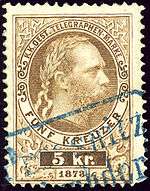
- Prestawlk: Prestavlky M,22
- Prestitz: Přeštice B,67
- Pribislau (Primislau ?): Přibyslav B,11
- Pribram (Pribrans): Příbram B,68
- Priedlanz: Předlánce
- Priesen: Březno u Chomutova B,36
- Priesern: Přízer
- Priethal: Přídolí
- Prikaz bei Olmütz: to be identified M,21
- Primiswald: Přemyslov
- Pritschen: Příčná
- Probolden (near Schwiebgrub): Provodice
- Proboscht: to be identified B,46
- Pröding: to be identified M,28
- Prödlitz: Brodek u Nezamyslic M,23
- Promenhof: Broumov
- Proschwitz: to be identified B,21
- Prosetsch (Prosec): Proseč u Skutče B,24
- Prossmeritz: Prosimeřice M,34
- Prossnitz: Prostějov (also Prostejovice) M,23

- Prossnitz (part of Kriebaum): Vražice (now the military training area Boletice)
- Protiwanow: Protivanov M,2
- Protiwin: Protivín B,61
- Prostibor: Prostiboř
- Pruchna: to be identified S,1
- Pruhonitz: Pruhonice B,6
- Prusinowitz bei Holleschau: to be identified M,9
- Prussinowitz (Kreis Bärn): Banšov
- Przibram: Příbram
- Pschan: Blšany u Loun
- Pschelautsch: Přelouč
- Pschestitz: Přeštice
- Pschislowitz: Březovice
- Pstruschi: Pstruží
- Ptin: Pteni M,23
- Pürglitz: Křivoklát B,69
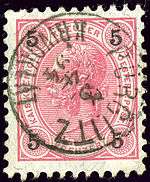
- Pürles: Brložec
- Pürstein: Perštejn B,29
- Pürstling: Březník
- Pürstling (mountain): Březník
- Pulgram in Mähren: to be identified M,20
- Pullitz: Police M,14
- Pumperle: Řasnice
- Pulpetzen: Pulpecen
- Punkendorf (Kreis Bärn): Bonkov
- Punzau: to be identified S,6
- Puritschen (hamlet near Zierling, in the Kaplitz district): Kvasov
- Purkratitz: Purkratice
- Purschau: Pořejov B,86
- Puschwitz: Buškovice B,64
- Pustlitz (Putzlitz): Puclice
- Pustomiersch: Pustomer M,33
- Putschen: Bučí
- Putzeried: Pocinovice B,87
Q
- Qualen: Chvalov
- Qualisch: Chvalec B,91
- Quetusch: Květuš
- Quinau: Blatno
- Quintenthal: Vizov
- Quitosching (Kwietoschin) (part of Irresdorf): Květušov (Dětošín, Dětušín)
- Quittein: Květín
- Quittendorf: Metylovice
- Quitkau: Kvítkov u České Lípy
R
- Raase: to be identified S,4
- Rabenhütte: Havranka
- Rabenstein in Böhmen: Rabštejn (Decín) B,40
- Rabenstein an der Schnella: Rabštejn nad Střelou
- Rabersdorf: Hrabišin M,25
- Rabitz: Hrabice
- Rabitzerhaid: Hrabická Lada
- Raby: Rabí B,84
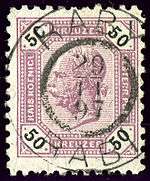
- Rachel (mountain): Roklan
- Rachelbach (Bach): Roklanský potok
- Radaun: Radon
- Radegast: Radhošť
- Radaun: Radoun
- Radim: to be identified B,26
- Radimowitz: Radimovice B,92
- Raditz (Radjitz) (Radic?): Radice B,79?
- Radl: Rádlo B,21
- Radnitz: Radnice u Rokycan B,73
- Radobil: Radobýl
- Radomischl (bei Strakonitz):Radomysl u Stratonic B,84
- Radonitz: Radonice u Kadaně B,29
- Radoschowitz: Radošovice
- Radostin: to be identified M,7
- Radostitz (bei Strakonitz): Radhostice
- Radotin: to be identified B,82
- Radschau: Račov, also Radešov
- Radschowitz: Hradcovice
- Radwanitz in Schlesien: Radvanice (part of Ostrava) S,2
- Ragersdorf: Malý Radkov
- Rahmbruckhäuser: Manč
- Raifmaß (part of Unterschalgl): Radvanov
- Raigern: Rajhrad M,1
- Rainochowitz: Rajnochovice M,9
- Raitz: Rajec M,2
- Raiza: Rájec
- Rakonitz: Rakovník B,69
- Rakschitz: Rakšice
- Ramsau: Ramzová
- Ranna: Ranna B,12
- Rapitz (before 1881: Butzkow): Rapice B,33
- Rapotitz: Rapotice M,28
- Rascha: Rašov
- Raspenau: Raspenava B,19
- Rasseln: Podskalí
- Ratai (Rataj, Rattai): Rataje (Tábor)
- Ratais an der Sasau (Rataj): Rataje nad Sázavou
- Rathgebern: Radkov
- Ratischkowitz: Ratíškovice M,6
- Ratsch: Hradiste
- Ratschendorf: to be identified B,72
- Ratschin (near Altspitzenberg): Radčín (Račín, Radšín, Radošín)
- Ratschitz: Račice-Pístovice M,33 (Vyškov District)
- Ratschinowes: Raciněves
- Rattaj in Mähren: to be identified M,11
- Rattay: Rataje B,42
- Rattimau: Ratimov S,6
- Ratzau bei Tachau: Racov
- Ratzau (Battelau): Racov (Batelov)
- Raubowitz: Roubovice B,12
- Raudnitz: Roudnice
- Raudnitz (an der Elbe): Roudnice nad Labem B,70
- Raudnitz in Riesengebirge: Roudnice v Krkonoších
- Rauschenbach: to be identified B,88
- Rausenbruck: Strachotice M,34
- Rausenstein (Böhmisch, Mährisch): Ostrý Kámen
- Rausin: Rousínov (Rakovník)
- Raussnitz: Rousínov (Vyškov)
- Rautenberg (Kreis Bärn): Roudno
- Razic: Razice B,61
- Reckerberg (part of Nitzau): Popelná
- Reckowitz: Reckovice M,3
- Redenitz: to be identified B,29
- Redhoscht: Redhošt B,70
- Regens: Rehorov M,10
- Rehberg: Srní B,78
- Reichen: Rychnov u Verneřic
- Reichenau an der Maltsch: to be identified B,30
- Reichenau bei Gablonz: Rychnov u Jablonce n.N B,21
- Reichenau an der Knezna: Rychnov nad Kněžnou B,71

- Reichenau in Mähren: Rychnov na Moravě M,16
- Reichenberg: Liberec B,72
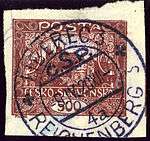
- Reichenburg: Rychmburk
- Reichetschlag, zu Schöbersdorf: Mýtina
- Reichenthal: Hraničky
- Reichstadt: Zákupy B,7
- Reichwaldau: Rychvald S,2
- Reigersdorf (Kreis Bärn): Rejchartice
- Reihwiesen: Rejvíz
- Reinowitz: Rýnovice B,21
- Reischdorf: to be identified B,29
- Reischlberg (mountain): Hraničník
- Reisendorf (Kreis Bärn): Trhavice
- Reissig: Klest
- Reitendorf: Rapotín
- Reiterschlag: Pasečná
- Reith: Svánkov/Švaňkov
- Reith: Loutka (Lutka)
- Reith: Louka
- Reith (near Wullachen): Klestin, Na Rejte?
- Remeschin: Řemešín
- Rentsch: Řevničov (Rencov) B,76
- Repan: Řepany
- Repeschin: Řepešín
- Repin: Repin B,49
- Repora: to be identified B,82
- Reschihlau (Rescholau): Hrešihlavy
- Reschowitz (Reschwitz): Radošov
- Reutenhau: Rejtovice
- Rewnitz: Revnice B,82
- Richenburg: Předhradí u Skutče (earlier Rychmburk) B,24
- Richterhäuser: Rychtářov
- Richterhof: Střemily
- Riegerschlag: to be identified B,56
- Riegersdorf: Modrec
- Riegersdorf Schlesien: Rudzice S,1
- Rikowitz: Rikovice M,22
- Rimau: Rimov B,30
- Rinaretz: Rynarec B,59
- Rindlau (near Duschowitz): Žlíbek
- Rindles: Žlábek
- Ringelberg: Horní Výšina
- Ringelshain: to be identified B,20
- Rischkau: Hříškov
- Ritschan (before 1867: Rzitschan, Rican): Říčany u Prahy B,94
- Ritschen: Rýdeč
- Riwtschitz: Hrivčice
- Rockendorf: Žitná
- Röchlitz (bei Reichenberg): Rokytnice nad Jizerou B,72
- Röderhof: Rodrovský Dvorec
- Rodisfort: Radošov
- Röhrenberg: Žlíbky
- Röhrenbergerhütte (also: Adlerhütte): Röhrenberska Huť
- Röhrsdorf bei Zwickau (bei Gabel in 1871): Svor B,20
- Röhrsdorf (bei Hainspach): Liščí B,77
- Römerstadt: Rýmařov M,24
- Rössin: Rešín
- Röwersdorf: Třemešná ve Slezsku S,5
- Rohatetz: Rohatec M,6
- Rohow: Rohov
- Rohle: to be identified M,8
- Rohn: Leptač
- Rohr: Nový Drahov
- Rohrbach bei Gross Seelowitz: Hrušovany (u Zidlochovic) M,1
- Roiden (near Haag): Rojov
- Roisching: Rojšín
- Rojau: to be identified B,88
- Rojsko, Roysky, zu Watetitz: Rajsko
- Roketnitz bei Prerau: Roketnice u Prerova M,22
- Rokitnitz (Adlergebirge): Rokytnice v Orlických horách B,81
- Rokycan (before 1899: Rokitzan): Rokycany B,73

- Rongstock: Roztoky
- Ronow an der Doubrawa: Ronov nad Doubravou
- Ronow (bei Caslau): Ronov u Caslavi B,13
- Ronow Woskorinek: Ronov Oskorinek B,63
- Ronsperg: Poběžovice B,4
- Roppitz: Ropica S,6
- Rosawitz: Rozbělesy
- Roschowitz: Radošovice
- Roschtin: to be identified M,11
- Rosenau: Rožnov pod Radhoštěm
- Rosenberg an der Moldau (in Böhmen): Rožmberk nad Vltavou B,30?
- Rosendorf: to be identified B,90
- Rosenhügel: Růžový Vrch
- Rosental: Rožmitál u Broumova
- Rosenthal (Böhmerwald): Rožmitál na Šumavě
- Rosenthal: Rožmitál pod Třemšínem
- Rosenthal bei Kaplitz: to be identified B,30
- Rosenthal II bei Reichenberg): Růžodol (Liberec XI) B,72
- Rosinkau: Nový Hrozenkov
- Rositz bei Pardubitz: Rosice u Pardubic B,58
- Rossbach in Böhmen (before 1867: Rossbach): Hranice u Aše B,1
- Rossenreuth: Mýtinka
- Rosshaupt: Rozvadov B,86
- Rossitz bei Brünn (before 1867: Rossitz): Rosice u Brna M,3
- Rossochatetz: Rozsochatec
- Rossrein: Rozhrani M,2
- Rosswald Markt: Slezské Rudoltice S,5
- Rostok bei Prag (before 1867: Rostock): Roztoky (u Prahy) B,82
- Rotenhof (also: Rothenhof) (near or part of Kalsching): Červený Dvůr
- Roter-Berg-Sattel: Červenehohorské sedlo
- Rothau: Rotava B,22
- Rothehöh: Červený Vršek
- Rothenbaum: Červené Dřevo (deconstructed, military border)
- Roth Hradek: Cerveny Hradek B,35
- Roth Janowitz (Rotjanowitz): Červené Janovice B,42
- Roth Kosteletz (before 1881: Kosteletz): Cervený Kostelec (Náchod District) B,54
- Roth Lhotta: Cervena Lhota M,28
- Rothmühl: Radiměr see Mährisch Rothmühl
- Rothrecitz (earlier Roth-Retschitz): Cervena Recice B,59
- Rothsaifen: Červená
- Rotkirchen: Líbeznice
- Rotschau: Ročov
- Roubovice: Hroubovice
- Rouchowan: Rouchovany M,12
- Rouschtka: Rouštka M,31

- Rovecin: to be identified M,2
- Röwersdorf: Třemešná
- Rowensko: Rovensko B,92
- Rownin: Rovniny
- Rozdalowitz: Rozdalovice B,26
- Rozmital: Rozmital B,5
- Roznau: Rožnov M,31
- Ruben: Kladenské Rovné
- Rubenz: Rovence
- Ruckendorf (partly deconstructed): Hrudkov
- Rudelsdorf bei Katharinaberg: Rudolice v Horách
- Rudelsdorf bei Landskron: Rudoltice
- Rudensdorf in Mähren: to be identified M,25
- Rudelzau (Kreis Bärn): Rudoltovice M,26
- Rudetschlag: Lipoltov
- Rudig: Vroutek B,64
- Rudikau: Rudikov M,7
- Rudolfstadt: Rudolfov B,10
- Rückersdorf: to be identified B,19
- Rumburg: Rumburk B,74
- Ruppersdorf bei Reichenberg: Ruprechtice B,72
- Ruprecht: Ruprechtov M,33
- Rust: Podbořanský Rohozec
- Rychtarov: to be identified M,33
- Rzimau (Rimau?): Římov B,30?
S
- Saap: Zápy
- Saar: Žďár nad Sázavou M,18
- Saar bei Duppau: Žďár
- Saar in Böhmen: to be identified B,29
- Saara: Žďár u Velkého Chvojna
- Saatz: Žatec
- Saaz: Žatec B,75
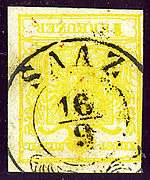
- Sablat: Záblatí u Prachatic
- Saborsch: Záboří
- Saborz: Záboří
- Sabratne (hamlet near Böhmisch Gillowitz): Zavratnej
- Sacherles: Kamenná (České Budějovice District)
- Sachradka: Zahrádky
- Sadowa: Sadová B,37 (Hradec Králové district)
- Sadska: Sadská B,63
- Sadusch: Mělník
- Säumerbrücke: Soumarský Most
- Saharob: Záhrobí
- Sahorsch: Záhoří
- Sahorschan: Záhořany
- Sahr: Ždár
- Sahrob (Sachrob): Záhrobí
- Saitz: to be identified M,1
- Sajestetz: Zájezdec
- Salcperk (Salzberg): Bílá Skála
- Salesel: to be identified B,2
- Salmthal: Pstruží B,27
- Salnau: Želnava B,41
- Saluschan: Zalužany
- Salzer-Mühle: Mlýn Řasnice
- Salzweg, bei Klösterle: Solná Lhota
- Samost: Zámostí
- Samrsk: Zámrsk
- Sanct Anna: Svatá Anna
- Sanct Benigna: Svatá Dobrotiva B,25
- Sanct Georgenthal: Jiřetín pod Jedlovou (Svatý Jiřetín) B,74
- Sanct Güntherfelsen: Březník
- Sanct Joachimsthal, Sankt Joachimstal (before 1898: Joachimsthal): Jáchymov B,27
- Sanct Johann: Svatý Jan
- Sanct Katharina: Svatá Kateřina
- Sanct Magdalena: Svatá Magdalena
- Sanct Margarethenbad: Lazné Svate Markety B,66
- Sanct Maurenzen: Svatý Mouřenec
- Sanct Niklas: Svatý Mikuláš
- Sanct Thomas: Svatý Thomaš
- Sanct Wenzel: Svatý Václav
- Sand Lhota: Písková Lhota
- Sandau: Pist
- Sandau bei Eger (b. Marienbad) (before 1867: Sandau): Dolní Žandov B,62
- Sandau (bei Böhmisch Leipa): Žandov u České Lípy B,7
- Sandhübel (bei Zuckmantel): Písečná S,3
- Sangerberg (before 1879: Gross-Sangenberg): Prameny B,88
- Sarau: Kyselov
- Sasau: Sázava
- Sasau (earlier Sazau): Sázava B,42
- Sasmuk: Zásmuky
- Sattel: to be identified B,57
- Sattelberg: Sedlo
- Sattelberg (mountain): Špičák u Krásného Lesa
- Saubernitz: Zubrnice B,2
- Saubsdorf: Supikovice S,3
- Sauersack: Rolava
- Sawerschitz: Zavržice
- Sazau: Sázava B,42
- Sbirow: Zbiroh
- Sborowitz: Zborovice
- Sbosch: Zboží (Havlíčkův Brod) / Malé Zboží (Nymburg)
- Sbraslawitz: Zbraslavice
- Schaar: Žďár
- Schaboglück: Žabokliky B,75
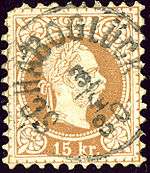
- Schachtelei: Povydří
- Schäferei: Ovčárna
- Schätzenreith: Rokyta/Schätzová Muť
- Schätzenwald: Schätzův Les
- Schafbühl: Na Ovčim vrchu
- Schaffa (Schafing): Šafov M,34
- Schak: Žáky
- Schallan: Žalany B,89
- Schamers: Címěr B,56
- Schanda: Žandov
- Schanz: Valy
- Schattau: Šatov M,34
- Schattawa: Zátoň
- Schatzlar: Žacléř B,91
- Schauflern: Šavléřov (Šafleřov)
- Schdiar b. Neuötting: Žďár
- Schdiar b. Protiwin: Žďár
- Schdiar b. Raitz-Jestrab: Žďár
- Schdiar b. Turnau: Žďár
- Schebetau: Šebetov M,2
- Schehuschitz: Žehušice
- Scheiben: Šejby
- Scheiben, bei Gansau: Vyšovatka
- Scheibenraditsch: Okrouhlé Hradiště
- Scheles: Žihle B,64
- Schelesen: Želízy
- Schelkowitz bei Bilin: Želkovice
- Schelletau: Želetava M,4
- Schelsnitz, also Schölsnitz: Přelštice
- Schemeslitz: Všemyslice
- Schenkenhahn: to be identified B,21
- Schepankowitz: Štepankovice
- Scheranowitz: Žeranovice
- Scherau: Všeruby
- Scherau (near Korkushütten): Šerava
- Scherawitz: Žeravice
- Scherub (Scheruw): Všeruby
- Schestar: Všestary
- Schestau, zu Zippendorf: Žestov
- Scheuereck: Stodůlky (Žďárek)
- Scheurecker Schwelle: Žďárské jezírko
- Schewetin: Sevrtin B,93
- Schichowitz: Žichovice B,78
- Schießnetitz: Žíznětice
- Schießnig: Žizníkov
- Schihobetz: Žihobce
- Schild, zu Kaltenbrunn gehörend: Bystrá
- Schillerberg: Radvanovice
- Schillerberg (mountain): Radvanovský vrch
- Schildberg: Štíty (earlier Šilperk) M,8
- Schillersdorf: Šiherovice
- Schiltern in Mähren: Štítary na Morave M,34
- Schimern: Všimary II
- Schimitz: Židenice M,3
- Schindlau, zu Neugebäu: Šindlov
- Schindlwald: Šindelová
- Schippen: Šípy
- Schirmdorf: Semanín
- Schlackenwerth (before 1867: Schlakenwerth): Ostrov nad Ohří B,31
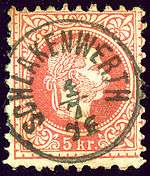
- Schlackern, zu Mugrau: Slavkovice
- Schlada (b. Franzensbad): Slatina
- Schlag am Rossberg (part of Kaltenbrunn): Čižkrajice pod Chobolkou B,21?
- Schlagl (zu Richterhof): Savlova Lhota
- Schlaggenwald: Horní Slavkov B,18
- Schlakau: Slavkov u Opavy S,7
- Schlan (earlier also: Salzberg): Slaný B,76
- Schlappanitz: Slapanice M,3
- Schlappenz: Šlapanov B,15
- Schleb: Žleby
- Schlesien: Slezsko (Moravské Slezsko)
- Schlesisch Ostrau: Slezská Ostrava (merged with Mährisch Ostrau = Moravská Ostrava in 1945 to form Ostrava)
- Schlock (Kreis Bärn): Slavkov
- Schlösschen: Zámeček
- Schlossbösig: Bezděz
- Schlösselbach: Kořenný
- Schlösselwald: Hrádky
- Schloss Rozinka: Zamecka Rozinka M,18
- Schluckenau (before 1867: Schlukenau): Šluknov B,77
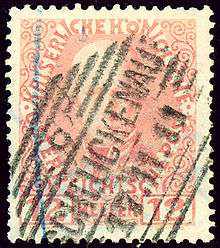
- Schlüsselburg: Lnáře B,5
- Schmeil (Kreis Bärn): Smilov
- Schmiedeberg: Kovářská B,29
- Schmiedhäuser: Kovářov
- Schmieding (near Schwiebgrub): Kovářovice
- Schmiedsau (Kreis Bärn): Kovářov
- Schmiedschlag (near Wadetstift): Kovarov
- Schmole-Zvole: to be identified M,8
- Schnecken: Šneky
- Schneekoppe: Sněžka; Śnieżka (polnish) B,91
- Schneiderhof: Mysliv
- Schneiderschlag (near Oberschlag): Krejčovice
- Schneidetschlag (part of Plattenschlag): Veselí
- Schnobolin: to be identified M,21
- Schöber (mountain): Stožec
- Schöbersattel (Paß): Stožecké sedlo, also Šébr
- Schoberstätten, zu Christianberg: Seníky
- Schöbersdorf: Šebanov
- Schöd (Schödl, Schödüber): Malá Šitbor
- Schödlhaus: Na Sedle
- Schöllschitz: Želešice M,3
- Schömern, bei Lobiesching: Všeměry
- Schönau: Pekná ?
- Schönau: Šenov (Jicín)
- Schönau (part of Kraslice): Snežná (Kraslice) (Okres Sokolov)
- Schönau bei Braunau in Böhmen: Šonov u Broumova B,8
- Schönau bei Mährisch Rothwasser: to be identified Stará Cervená Voda ? M,8
- Schönau bei Schluckenau (before 1867: Schönau): Šluknov B,77
- Schönbach (bei Deutsch Gabel): Zdislava (Liberec)
- Schönbach (bei Wildstein, Schönbacher Ländchen): Luby
- Schönbach im Erzgebirge: Meziborí Okres Most
- Schönbach in Böhmen (Schönbach bei Asch): Krásná B,17
- Schönberg (bei Selcan): Krásná Hora B,79 (Havlíčkův Brod District)
- Schönbrunn: Jedlová / Svinov (Ostrava) S,8
- Schönbrunn bei Tachau: Studánka
- Schönebene: Krásné planiní
- Schönfeld bei Petschau (before 1867: Schönfeld): to be identified B,18
- Schönfeld (Kaiserwald): Krásno nad Teplou
- Schönfeld abandoned village in Kienberg bei Hohenfurth: Krásná Pole
- Schönfelden: Osí
- Schönficht (Kaiserwald): Smrkovec u Březové B,62
- Schönhengst: Hřebec
- Schönhof Šenov S,6
- Schönhof (bei Podersam): Krásný Dvůr B,64
- Schönlind (bei Neudek): Krásná Lípa u Šindelové
- Schönlind bei Heinrichsgrün: to be identified B,22
- Schönlinde: Krásná Lípa B,74
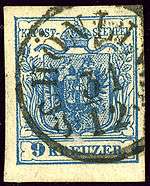
- Schöninger (mountain): Kleť
- Schönpriesen: Krásné Brezno B,2
- Schönstein in Schlesien: Zitovice u Opavy S,7
- Schönthal: Krásné Údolí
- Schönthal bei Petschau: to be identified B,31
- Schönwald bei Bärnwald: Podlesí v Orlických horách (part of Bartošovice v Orlických horách) S,5
- Schönwald bei Bautsch: Podlesí nad Odrou (part of Budišov nad Budišovkou) M,26
- Schönwald bei Frain: Šumná M,34
- Schönwald bei Friedland: perhaps Krásný Les u Frýdlantu B,72
- Schönwald bei Mährisch Neustadt: Šumvald (u Uncova) M,13
- Schönwald bei Marletzgrün: perhaps Krásný Les B,31
- Schönwald bei Peterswald: Krásný Les v Krušných horách
- Schönwald bei Schlackenwerth (earlier bei Joachimsthal): to be identified B,27
- Schönwald bei Tachau: Lesná u Tachova B,86
- Schönwald bei Tattenitz: Strážná
- Schönwald bei Tellnitz (before 1896 also: Schönwald bei Karbitz; sometimes also just: Schönwald): to be identified B,2
- Schönwehr: Krásný Jez
- Schonung: Obora u Loun
- Schoschuwka: Šošůvka
- Schossenreith: Částkov
- Schreckenstein: Střekov
- Schreibendorf in Mähren: Pisarov M,8
- Schreibersdorf: Hnevošice
- Schreinerberg (mountain): Bobík
- Schreinetschlag: Skříněřov
- Schritenz: Střítež
- Schröbersdorf, zu Duschowitz: Radešov
- Schüppen: Šípy
- Schürerhof: Schürerův Dvůr
- Schüttenhofen: Sušice B,78
- Schüttenitz: Žitenice B,46
- Schüttiber (Schüttüber): Malá Šitbor
- Schukatschen: Šukačka
- Schumberg: Žumberk
- Schumitz: Šumice M,29
- Schurz: to be identified B,38
- Schusitz: Žehušice
- Schwabenitz: Svabenice M,33
- Schwaderbach: Bublava B,22
- Schwadowitz, Klein-Schwadowitz: Malé Svatoňovice
- Schwarzbach (Bach): Černý Potok
- Schwarzberg (mountain): Černá Hora
- Schwarzbuda: Černé Budy
- Schwarzbach in Böhmen: Černá, Černá v Pošumaví B,41
- Schwarzberg (mountain): Černá hora
- Schwarze Leiten: Černá stráň
- Schwarzenberg: Černá Hora
- Schwarzenbergscher Schwemmkanal, Schwarzenbergkanal: Švarcenberský kanál
- Schwarzenthal (Riesengebirge): Černý Důl B,23?
- Schwarzer See (See): Černé jezero
- Schwarzes Kreuz: Černí Kříž
- Schwarzhaid (near Neugebäu): Černá Lada
- Schwarzkirchen: Ostrovačice M,3

- Schwarzkosteletz: Kostelec nad Černými Lesy (Cerny Kostelec) B,6
- Schwarzwasser (Bzk. Bielitz): Strumien S,1
- Schwarzwasser bei Freiwaldau: to be identified S,3
- Schwaz in Böhmen (Schwatz in Böhmen in 1872): to be identified B,16
- Schweigelhaid (near Neugebäu): Švajglova Lada
- Schweine: Svinov
- Schweinetschlag: Sviňovice
- Schweinitz in Böhmen (bei Budweis) (before 1886: Schweinitz): Trhové Sviny B,10
- Schweinitz (b. Wesseli): Sviny
- Schweinschädel: Svinišťany
- Schweissing: Svojšín B,50
- Schwemmkanal: Plavební kanál
- Schwiebgrub (Grub): Švíba
- Schwihau (bei Klattau): Švihov B,34
- Sdaslaw: Zdeslav
- Sdechowitz: Zdechovice
- Sdeslaw: Zdeslav
- Sdiar: Ždár
- Sdounek: Zdounky
- Sduchowitz: Zduchovice
- Sebastiansberg (Sebastianberg): Hora Svatého Šebestiána B,36
- Sebranitz: to be identified B,47
- Sebrowitz: Zabovresky M,3
- Seckerberg: Horky
- Sedletz a.d. Fr.Jos.Bhn. (before 1867: Sedletz): Sedlec na Draze Fr.Jos. B,79
- Sedletz bei Kuttenberg: Sedlec u Kutne Hory B,42
- Sedletz bei Libochowitz: Sedlec
- Sedletz: Sedlec u Votic
- Sedlitz (bei Blatna): Sedlice u Blatne B,5
- Sedlmin (bei Wolletschlag?): Sedlmín
- Sedlnitz bei Freiberg: to be identified M,19
- Seebach (Bach): Kvildský potok
- Seeberg: Ostroh
- Seefilz (Moor): Jezerní slať
- Seehaid (near Neugebäu): Svinná Lada
- Seelau: Želiv B,15
- Seelowitz (Gross-Seelowitz): Židlochovice M,1

- Seestadtl: Ervěnice B,36
- Seewiesen in Böhmen: Javorná na Šumavě (earlier Zejbiš) B,78
- Seewiesenhof: Zejbíšský Dvůr
- Segen Gottes (before 1880: Zastawka): Zastávka (Bozi Pozehnani) M,3
- Sehuschitz: Žehušice B,13
- Seibelsdorf: Žipotín
- Seibersdorf (Kreis Bärn) (earlier Nieder Seibersdorf): Bělá (Zebrzydowice) S,2
- Seichenreuth: Táborská
- Seidowitz: Zidovice B,9
- Seifen: Ryžovna
- Seifersdorf in Böhmen: to be identified B,20
- Seitendorf (bei Zauchtl): Horní Životice M,19
- Selc: Sedlec
- Selcan (earlier Seltschan): Sedlčany B,79
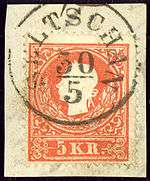
- Selletau: Želetava
- Selletitz: Želetice M,34
- Sellnitz: Želenice
- Selsen: Želivsko
- Seltsch: Želec
- Selz: Sedlec (Cheb)
- Semeschitz: Semošice
- Semil (also: Seemühl): Semily B,80
- Semitz: Semice
- Senftenberg (in Böhmen): Žamberk B,81
- Senomat: Senomaty B,69
- Senozat: Senozaty B,15
- Sensemitz (Sensenitz, Sensennitz, Sensomitz): Sezemice
- Serowitz: Žirovnice B,59
- Setsch: Seč B,12
- Setzdorf: Vápenná (earlier also Zighartice) S,3
- Sezemitz: Sezemice B,58
- Sichlau: Cihavlov
- Sichrow: Sychrov B,92
- Siebenhäuser: Sedm Chalup
- Siebenhäuser: Sedmidomí
- Siebenhöfen (Kreis Bärn): Sedmi Dvory
- Siebitz: Třebovice
- Siegertsau (Kreis Bärn): Zigartice
- Siegmund-Mühle: Zikmundův Mlýn
- Silberbach: Stříbrná B,22
- Silberberg: Nalžovké Hory
- Silberberg: Orlovice
- Silberberg: Stříbrné Hutě
- Silberberg: Stříbrné Hory B,34
- Silberskalitz: Stříbrná Skalice
- Siluwka: Siluvka M,3
- Simandlhof: Šimandlův Dvůr
- Simmensdorf: Šimanov
- Simmersdorf: Smrčná B,15
- Sirmitz: Zirovice
- Sittna: Sytno
- Skalitz-Goldenbrunn: Skalice-Zlata Studne M,2
- Skalken: Podbřeží
- Skalsko: to be identified B,53
- Skirschina: Skršín
- Skocitz: Skocice B,61
- Skotschau: Skoczow S,1
- Skripp (Skrzipp): to be identified S,8
- Skrochowitz: to be identified S,7
- Skuc (before 1867: Skutsch): Skuteč B,24
- Skuchrow an der Alba: Skuhrov nad Bělou
- Skups: Skupec
- Skworetz: Skvorec B,6
- Slabathen: Slavětín
- Slabetz: Slabce (Slabec) B,69
- Slapy: Slap B,82
- Slatinan bei Chrudim: Slatinany B,12
- Slawathen: Slavětín
- Slawietin in Böhmen: (earlier Slavetin v Cechach) Slavetín (Louny District) B,44
- Slawietin in Mähren: Slavětín (Olomouc District) M,13
- Slawitschin: Slavicin M,29
- Slawoschowitz: Slavošovice
- Slibowitz: Slibovice B,63
- Sliw: Zliv u Českých Budějovic
- Slonin: Zlonín
- Slonitz: Zlonice
- Sloup: to be identified M,2
- Sloupnitz: Sloupnice B,47
- Sluschowitz: Slusovice M,9
- Smecno (earlier Muncifai): to be identified B,76
- Smerdow: Sázavka
- Smichov: Smíchov (now part of Prag) B,82
- Smidar: Smidary B,55
- Smiler-Berg: Smilovy Hory
- Smilkau: Smilkov B,79
- Smilovy Hory: to be identified B,85
- Smiritz in Böhmen (before 1867: Smirzitz; also: Smirschitz): Smiřice B,38
- Smrdov: Sázavka
- Smrzitz in Mähren: Smrzice M,23
- Sobeslau (before 1867: Sobieslau): Soběslav B,85
- Sobetitz: Sobetice
- Sobiechleb (Sobochleben): Soběchleby M,32
- Sobiesak: to be identified B,75
- Soborten: Sobědruhy
- Sobotka: to be identified B,26
- Socherl: to be identified M,12
- Sörgsdorf: to be identified S,3
- Sofienthal bei Mathamohren: Černá Řeka B,8
- Sokolnitz: Sokolnice M,3
- Solan: Solany
- Soletin, also: Solletin, zu Repeschin: Saladin
- Solislau: Sulislav
- Sollan: Solany
- Sollmus: to be identified B,48
- Solnitz: Solnice B,71
- Sommerau, Ortsteil von Stachy/Stachau: Šebestov
- Sonnberg: Žumberk u Nových Hradů
- Sonnberg, Dorf (near Böhmisch Gillowitz): Slunečná (Žumberk)
- Sonnenberg (in Böhmen): Výsluní (earlier: Šuniperk) B,36
- Sorghof: Lučina
- Soutitz: Soutice B,3
- Spachendorf: to be identified S,4
- Spiegelhütten: Zrcadlova Hut'
- Spiels: Splž
- Spindlermühle (earlier Spindelmühle): Špindlerův Mlýn B,23
- Spirkenhäusel: U Špirků
- Spitinau: Spytinov M,30
- Spitzberg (mountain): Špíčák
- Spitzberg (Spitzenberg): Špičák B,78
- Spitzenberg: Hory
- Spomischl: Spomyšl
- Sponau: Spálov M,32
- Sporitz: Spořice
- Spornhau: Ostružná M,25
- Spy: to be identified B,57
- Srutsch an der Sasau: Zruč nad Sázavou
- St. ... : see Sanct ...
- Staab: Stod B,50
- Stablowitz: to be identified S,7
- Stachau: Stachy B,78
- Stachlowitz: Stachlovice
- Stadl (b. Franzensbad): Stodola
- Stadlern, zu Wolletschlag: Stadla
- Stadln: Stodůlky (Stadla)
- Stadt Königswart: Lázně Kynžvart
- Stadt Liebau: Město Libavá M,26
- Stahletz (Stachletz): Stádlec
- Stallek: Stálky
- Stangendorf: Vendolí
- Stankau (Stankau-Dorf, Stankau-Stadt): Staňkov (Domažlice District) B,4
- Stankowitz bei Triebsch: Staňkovice
- Stannern: to be identified M,10
- Staritsch: to be identified M,17
- Starkenbach: Jilemnice B,83
- Starkstadt: Stárkov B,8
- Starlitz: Starý Laz
- Startsch: Stařeč M,28
- Starosedl: Starosedly
- Staschow: Stašov
- Stauding: Studénka S,8
- Stechowitz: Stechovice B,82
- Stecken: Štoky B,15 (Havlíckuv Brod District)
- Stekna: Štěkeň B,84 (Strakonice District)
- Stedra: Stiedra B,48
- Stefanau: Štepanov
- Stein: Polná na Šumavě
- Stein (part of Kaltenbrunn): Kamenná ? idem Steine??
- Steinau: Stonawa S,2
- Steinbach: Kamenice
- Steinberg (mountain): Stánová hora
- Steindorf: see Steinsdorf
- Steine: Kamenná M,8
- Steingrub: Lomnička
- Steingrün: Výhledy
- Steinhof: to be identified B,18
- Steinige Höhe: Kamenáč
- Steinitz: Ždánice M,5
- Steinitz: Uherský Ostroh
- Steinkirchen: Kamenný Újezd B,10
- Steinköpfl: Kamenná hlava
- Stein Lhota: Kamenná Lhota (Havlíckuv Brod District)
- Steinriegel (mountain): Mechový
- Steinschönau (Stein Schönau): Kamenický Šenov B,90

- Steinsdorf (bei Habern): Kamen u Habru B,13
- Steinüberfuhr: Kamenný Přívoz
- Stekna (Stiekna): Steken B,84
- Stepanitz: Stěpanice
- Stepanowitz: Stěpánovice [10]
- Stern (part of Schönfelden), abandoned village in Kienberg bei Hohenfurth: Hvězda
- Sternberg: Český Šternberg (Benešov District)
- Sternberg (in Mähren): Šternberk (Olomouc District) M,26

- Sternhof: Hvězda (Šternov)
- Sternteich: Hvězda
- Stetkowitz: Stetkovice B,79
- Stettin (in Österr. Schlesien): Stetina v Rak. Slezska S,7
- Stezer: Stezery B,37
- Stiahlau: Stahlavy B,73
- Stiebenreith: Ctiboř u Tachova
- Stiebnig: to be identified S,8
- Stiebrowitz: to be identified S,7
- Stieglhof: Stíhlov
- Stienowitz: Štenovice
- Stiep: Stipa M,9
- Stiepanau bei Nedwieditz: Stepanov M,18
- Stiepanow bei Wlaschim: Stepanov u Vlasimi B,3
- Stift (part of Schönfelden): Lhota
- Stift Tepl: to be identified B,88
- Stillfried: Víska, part of Dětřichov (Svitavy District)
- Stillseifenbach: Hrádecký potok
- Stitna: Stitna M,29
- Stipoklas: Štipoklasy
- Stockau (b. Heiligenkreuz): Štokov
- Stockau (b. Ronsperg): Pivoň
- Stockern (near Luppetsching): Plíškov
- Stöcken: Štoky
- Stögenwald: Pestřice
- Stögerhütte: Štégrova Huť
- Stömnitz, Ort, zu Zierling, Bez. Kaplitz: Jistebnik
- Stojanowitz: Stojanovice
- Stodo: Stod
- Stolzenhain (also Stolzenhan): Háj u Loučné
- Stoschitz: Stožice
- Strahl Hoschtitz: Střelské Hoštice (Strelohostice) B,84
- Strahlenberg: Štramberk
- Strakonitz: Strakonice B,84
- Stramberg: Štramberk M,19
- Stramberg: Štramberg
- Strany (bei Ung. Brod): Strani M,29
- Straschitz (bei Maut): Strasice B,73
- Straschkau: Strašnice (Strazek) M,18
- Strassenau: Benešov u Broumova
- Strassnitz: Strážnice na Moravě M,6
- Straupitz: Stroupeč
- Strazowitz: Strazovice M,5
- Strebowitz: Třebovice ve Slezku
- Stredokluk: Stredokluky B,82
- Streitseifen: Podlesí
- Strelitz: to be identified M,3
- Stresmir: Strezimir B,79
- Strilek: Strilky M,11
- Stritez: Stritez M,31
- Stritschitz: Strycice B,10
- Strobnitz: Horní Stropnice or Dolní Stropnice[11] B,30
- Strokele: Strakov
- Strunkowitz an der Flanitz Strunkovice nad Blanicí B,61 (now Prachatice District)
- Strups: Srubec[12]
- Strutz: to be identified M,3
- Stubau, zu Pohlen: Dubová
- Stuben: Hůrka
- Stubenbach: Prášily (z větší části) B,78
- Stubenbacher See (See): Prášilské jezero
- Stubendorf: Studnice
- Studein: Studená M,4
- Studenetz bei Falgendorf: Studenec u Horek B,83
- Studnitz bei Wischau: Studnice (Vyškov District) M,33
- Studnitz in Böhmen: Studnice v Čechách B,57
- Stüblern (near Wadetstift): Posudov
- Stübling (village near Obergallitsch): Žibřidov
- Stürmer (mountain): Bouřňák
- Studene: Studené
- Subschitz: Zubčice
- Suchenthal: Suchdol nad Lužnicí B,83
- Sud Hlawno: Sudovo Hlavno
- Sudetenschlesien: Sudetské Slezsko
- Sudomeritz (Sudomieritz): Sudomerice B,85
- Sukdol: to be identified B,42
- Sukohrad: to be identified B,14
- Sulzber (mountain): to be identified
- Suttom: Sutom
- Svratka (before 1867: Swratka): Svratka B,12
- Swetla (earlier: Swietla ob der Sasau): Světlá nad Sázavou B,45
- Swijan-Podol (earlier: Svijan-Podol): Svijany-Podoli B,92
- Swikowetz: Zvíkovec
- Swinětitz: Svinětice [13]]
- Swinna: Svinna
- Swittawka: Svitavka M,2
- Swojanow: Svojanov B,65
- Swojschitz: Svojšice (Kolín District) B,35
- Swolenowes: Zvoleneves (Zvolenoves) B,76
- Swudschitz: Svučid
T
- Tabor: Tábor B,85
- Tacha: Tachov
- Tachau: Tachov B,86
- Tachauer Brand: Milíře
- Tachlowitz: Tachlovice B,33
- Tafelhof (near Korkushütte): Hutsky Dvur
- Tafelhütten (near Korkushütte): Huť pod Boubínem (Tabulové Hory)
- Taikowitz: Tavikovice M,12
- Tajanow: Tajanov
- Tannaberg: Svatá Anna (Tanaberk)
- Tannawa: Ždánov
- Tannaweg: Jedlová
- Tannenberg (mountain): Jedlová
- Tannwald-Schumburg (before 1867: Tannwald, between 1867 and 1895: Unter Tannwald): Tanvald B,21
- Tanzplan (mountain): Tanečnice
- Taschowitz: Tažovice
- Tassau: Tasov M,7
- Tasswitz: Tasovice
- Tattenitz: to be identified M,8
- Tattern (near Schöbersdorf): Tatry (Tatrov, Tetřiny)
- Taubrath: Doubrava
- Taus: Domažlice B,87

- Tauschen (Tauschim, Tauschin): Lázně Toušeň B,32
- Techebon: Treboun
- Techobuz: to be identified B,59
- Teichstatt (before 1893: Kreibitz-Neudörfel): Rybniště B,74
- Teinitz an der Sasau (an der Sazawa): Týnec nad Sázavou (Tejnice) B,3
- Teinitzl: Tynec B,34
- Tellnitz: Telnice B,2
- Telnitz: Telnice u Brna
- Teltsch: Telč (Jihlava District) M,4
- Teltsch: Telec (Karlovy Vary)
- Tepl: Teplá B,88
- Tepley: Teplá
- Teplitz-Schönau (before 1896: Teplitz): Teplice B,89
- Teplitz-Turn: Trnovany
- Tereschau: Terešov B,73
- Tetschen-Bodenbach: Děčín
- Teschen: Český Těšín S,6
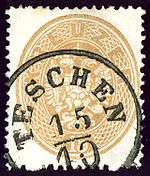
- Teschnitz (before 1885: Satkau): to be identified B,75
- Teschnitzl: Tesnice
- Teschwitz: Těšovice (Sokolov District) B,18?
- Teslaven: Zdeslav
- Tetschen an der Elbe: to be identified B,90
- Teufelsdorf: Zábřeh nad Odrou
- Teufelssee (lake): Čertovo jezero
- Teutschenrust: Podbořanský Rohozec
- Teutschmannsdorf: Skláře
- Teynka: Tejnka B,82
- Thaya (river): Dyje
- Thein: Týn nad Bečvou
- Theising: Toužim
- Themenau: Poštorná
- Theresiendorf: Terčí Ves, today Pohorská Ves B,30
- Theresienstadt: Terezín B,46
- Theusing: Toužim B,31
- Thierbach (river): Vydří potok
- Thiergarten bei Tachau: Obora u Tachova
- Thomasdorf: Domašov
- Thomigsdorf: Damníkov
- Thröm: Trebom
- Thurmplandles: Věžovatá Pláně
- Thurn: Tuřany
- Tichlowitz: to be identified B,90
- Tichtihof (Tichtihöfen) (part of Irresdorf): Dětochov (Fichtlhöfen)
- Tiefenbach-Dessendorf: to be identified B,21
- Tiefenfeld: Hluboká part of Kdyně
- Tiefengrund: to be identified S,7
- Tieschna bei Sokolnitz (Tieschan): Tesany u Sokolnice M,1
- Tieschetitz: Tesetice M,21
- Tieschowitz (Teschowitz): Těšovice (Prachatice District) B,66?
- Tinischt (an der Adler): Týniště nad Orlicí B,71
- Tirschnitz (now part of Eger): Tršnice
- Tisch: Ktiš
- Tischlern: Skubice
- Tischnowitz: Tišnov M,27
- Tischtin: Tištín (earlier Cíštín) M,22
- Tissa bei Tachau: Tisová
- Tissa bei Bodenbach: Tisá
- Tlumatschau: Tlumacov M,30
- Tmain: Tman
- Tobitschau: Tovacov M,22
- Tochowitz: Tochovice B,5
- Todnie:Todně[14]
- Tocnik: Tocnik
- Todlau: Datelov
- Töplei, also Töpley: Teplá
- Töpplitz: Teplice
- Tomitschan: Domašín
- Tonetschlag: Rohanov
- Topeletz: Topělec
- Topkowitz: to be identified B,90
- Totenkopf (mountain): Mrtvý vrch
- Tracht: Strachotín
- Trasenau: Draženov
- Trautenau: Trutnov B,91
- Traxelmoos: Slatiny
- Trebelowitz: to be identified M,14
- Trebendorf: Třebeň
- Trebitsch: Třebíč M,28

- Trebnitz (Böhm. Mittelgebirge): Třebenice B,46
- Trechow: Strechov nad Sázavou
- Tremles: Strmilov B,56
- Tremoschna: Třemošná B,60
- Treschkonitz: Třeskonice
- Treublitz: Troubelice M,13
- Trhonin (near Boubska): Trhonin
- Trhow-Kamenitz: Trhová Kamenice B,12
- Triblitz: Třebívlice B,46
- Triebendorf: Třebarov
- Triebitz (Trieblitz): Třebívlice B,43
- Triebsch: Třebušín B,46
- Triebschitz: Třebusice B,9
- Triesch: Třešť M,10
- Triesenhof: Střížov
- Trinka: Dřínek
- Trinksaifen: to be identified B,22
- Trnawka: Trnavka M,19
- Trippischen: Trpěšice
- Trnowan: Trnovany B,75
- Troja: to be identified B,32
- Troppau: Opava S,7

- Tropplowitz: Opavice
- Troubek (Traubek?): Troubky M,22
- Trpist: Trpísty
- Trshitz: Tršice M,32
- Trübenwasser: Kalná Voda B,91
- Trzeskonitz: Třeskonice
- Trzewnitz: Třebnice
- Trziblitz: Třebívlice
- Trzynietz: Třinec (Trzyniec) S,6
- Tschachrau, Čachrau: Čachrov
- Tschachwitz: to be identified B,29
- Tschaslau: Čáslav
- Tschaslawitz: Čáslavice
- Tschastolowitz: Častolovice
- Tschausch: Čous B,9
- Tschechisch Teschen: Český Těšín
- Tschechtitz: Čechtice
- Tscheitsch: Čejč M,6
- Tschejkowitz: Čejkovice
- Tschelakowitz: Čelákovice
- Tschelechowitz in der Hanna: Celechovice na Hané
- Tschelina: Celina
- Tschenkowitz: Čenkovice B,43
- Tscheraditz: Čeradice
- Tschernhausen: Černousy
- Tschernoschin (before 1867: Czernoschin): Černošín B,50
- Tschernoschitz: Černošice (Prague-West District)
- Tschernowitz (earlier: Czernowitz, Cernowitz in Böhmen): Černovice u Kunštátu Černovice (Blansko District) B,59
- Tschernowitz (bei Kamenitz an der Linde): Černovice u Tábora Černovice (Pelhřimov District)
- Tschernowitz (bei Komotau): Černovice u Chomutova Černovice (Chomutov District)
- Tschestitz: Čestice
- Tschichtitz: Cichtice
- Tschiest: Čistá u Horek
- Tschihana (before 1867: Cihana): to be identified B,50
- Tschim: Cím
- Tschimelitz: Cimelice
- Tschinowes: Ciněves
- Tschischkowitz: Čížkovice
- Tschitschow: Číčov
- Tschkin: Čkyne
- Tuchorschitz: Tuchorice
- Tucap in Böhmen: Tucapy v Cechach B,85
- Tuchorschitz: to be identified B,75
- Tüppelsgrün: Děpoltovice B,31
- Turas: Tuřany
- Türmaul: Drmaly
- Türmitz: Trmice B,2
- Türnau: Městecko Trnávka
- Tulleschitz: Tulesice M,12
- Tupadl: Tupadly B,14?
- Turas: Turany M,3
- Turkowitz: Dobrkovice
- Turn: Trnovany B,89
- Turnau (in Böhmen): Turnov B,92
- Turnitz: Tvrdonice M,6
- Tuschkau (ob der Mies): Město Touškov (Plzeň) / Touškov (Písek) B,50
- Tuschmitz: Tusimice B,29
- Tusset: Stožec B,41
- Tussetberg (mountain): Stožec
- Tussetschlag (part of Perschetitz): Brevniste
- Tutschap: Tučapy
- Tyrn: Děrné
- Tyssa: Tisá B,90
- Tyssaer Wände: Tiské Stěny
U
- Udritsch: Údrc
- Überdörfel: Opatovec
- Überschar (bei Bad Liebwerda): Přebytek
- Uhersko (in Böhmen): Uhersko v Cechach B,24
- Uhligstal: Uhlikov
- Uhritz (Uhrzitz): Uhřice M,5
- Uitwa (Uittwa): Útvina B,31
- Ujest: Újezd pod Přimdou (heute Ortsteil von Pfraumberg)
- Ulbersdorf: Albrechtice u Mostu
- Ullersdorf (bei Dux): Oldřichov (u Duchcova) B,89 (see also Groß Ullersdorf)
- Ullershof: Oldřichov
- Ullersloh: Oldřichov
- Ullitz: Úlice B,50
- Ullrichsthal: to be identified B,90
- Ulmbach: Jilmová
- Ungarisch Brod: Uherský Brod M,29
- Ungarisch Hradisch: Uherské Hradiště M,30

- Ungarisch Ostra: Uherský Ostroh M,30
- Ungarschitz: Uherčice (Znojmo District) M,14
- Unhoscht: Unhošt B,33
- Unola: Únehle
- Unter Adersbach: Dolní Adršpach
- Unter Aujezd: Dolní Ujezd B,47
- Unter-Bautzen: Dolní Bousov B,26
- Unterberg: Střelcův Dvůr
- Unterberkowitz: Dolní Beřkovice B,49
- Unter Biela: Dolní Bělá
- Unter Bojanowitz: Dolní Bojanovice M,6
- Unter Bory (Unter Borry): Dolní Bory
- Unter-Brezan: to be identified B,39
- Unter Bukowsko: Dolní Bukovsko B,93
- Unter Cerekwe: Dolní Cerekve B,59
- Unter Cetno: Doleni Cetno B,28
- Untergallitsch (near Obergallitsch): Dolní Kalistě
- Unterhaid: Dolní Dvoriště B,30
- Unterheid: Dolní Dvořiště
- Unter-Hbit: Dolní Hbyty B,68
- Unterheiming: Podolí (Podlí)
- Unterholz: Chrustenice
- Unterhöfen (Unter Höfen) (near Duschowitz): Dolní Dvorce (part of Kašperské Hory)
- Unter Hrachowitz: Dolní Hrachovice
- Unterjamling (Unter Jamny): Dolní Jamné
- Unter Körnsalz: Dolejší Krusec
- Unterlangendorf: Dolní Dlouhá Loucka
- Unterlichtbuchet: Dolní Světlé Hory (Dolní Lichtbuchet)
- Unter Kalna: Dolní Kalná Doleni Kalna B,26
- Unter Kralowitz: Dolní Kralovice B,45
- Unter Kraupen: Dolní Krupá u Havlíčkova Brodu B,15
- Unter-Langendorf: to be identified M,13
- Unter Lohma: Dolní Lohmany
- Unter Lukawitz: Dolní Lukavice
- Untermarkschlag: Dolní Hraničná (Dolní Markschlag, Dolní Marktschlag)
- Unter-Maxdorf (before 1900: Maxdorf): to be identified B,21
- Untermoldau, Unterwuldau : Dolní Vltavice
- Unter Neuern: Nýrsko
- Unterneugrün: Dolní Nivy
- Unter Oggold: Dolní Okolí
- Unter-Polaun: to be identified B,21
- Unter Potschernitz (Unter Pocernitz): Dolní Počernice B,32
- Unterreichenstein: Rejštejn B,78
- Unter Sandau: Dolní Žandov
- Unterschneedorf: Dolní Sněžná
- Unterschönhub (part of Ruckendorf): Dolní Prisahov (Dolní Schönhub)
- Untersekeran (before 1896: Obersekrzan, Ober-Sekeran): Dolní Sekyřany B,50
- Untersinetschlag: Dolní Příbraní (Dolní Sinetschlag)
- Unter Stefanau (before 1874: Stefanau): Dolní Stepanov M,26
- Untersteindlberg: Dolní Ždánidla (Dolní Steindlberg)
- Unterstögenwald: Pestřice (Dolní Stögenwald)
- Unter-Tannowitz: Dolní Dunajovice M,20
- Unterthemenau (Unter Themenau): Poštorná
- Untervollmau: Dolní Folmava
- Unterwielands (Gmünd III): České Velenice
- Unter-Wisternitz: Dolní Věstonice M,20
- Unter-Wuldau (also: Untermoldau): Dolní Vltavice B,41
- Unter Wurzelsdorf (before 1887: Wurzelsdorf): Korenov B,21
- Unterzassau: Dolní Cazov (Dolní Zasov)
- Unter Zetno: Dolní Cetno
- Untschin: Unčín
- Urbanau: Urbanov M,4
- Urinau: to be identified M,7
- Urtschitz (bei Prossnitz): Určice M,23
- Ustron: to be identified S,1 (Poland?)
- Utitz: see Wotitz
- Uttigsdorf: Útěchov (Svitavy District)
- Uttwa: see Uittwa
V
- Valdov: Lesná
- Venousy: Bděněves
- Verda: Ostrov
- Vierhäuseln: Čtyřdomi
- Vierhäuser: Čtyři Domy
- Vierzighuben: Lány (also: Čtyřicet Lánů)
- Vimberg: Vimperk
- Vinzenzsäge (also: Cenka-Mühle): Čeňkova Pila
- Vodolka: Odolena Voda
- Vogelberg (Berg): Ptáčnik
- Vogelsang: Lhotka
- Voigtskrosse: Velká Kraš S,3
- Voitersreuth: Vojtanov
- Voitsdorf: Bohatice u Zákup
- Vollmau: Folmava
- Vorder Heuraffl: Přední Výtoň or Hejrov
- Vorder Ptakowitz: Přední Ptákovice
- Vorderglöckelberg: Přední Zvonková (Přední Zvonkov, Přední Glöckelberg)
- Vorderhammer, zu Oberplan gehörend: Přední Hamry
- Vorderstift: Bližší Lhota (Přední Štifta)
- Vöttau: Bítov
- Vtelno: Mělnické Vtelno
- Vtschelnitz: Nová Včelnice
W
- Wachtern (hamlet near Böhmisch Gillowitz): Hlasna
- Wadetschlag: Svatonina Lhota
- Wällischbirken: Vlachovo Březí (Vlachobrezi) B,66
- Wadetstift: Hruštice
- Wagstadt: Bílovec S,8
- Waier: Rybník
- Wakowitz: Vadkovice
- Waldau (part of Kaltenbrunn): Valdov
- Waldeck (Alt, Neu): Valdek (Starý, Nový)
- Waldenburg: Bělá pod Pradědem
- Waldersgrün: Valtířov
- Waldheim: to be identified B,86
- Walditz: Valdice
- Walketschlag: Valkounov
- Wallachisch Bistritz: Valašská Bystřice
- Wallachisch Klobouk (before 1880: Klobauk): Valašské Klobouky Klobouky u Brna M,29
- Wallachisch Meseritsch: Valašské Meziříčí M,31
- Wallern: Volary
- Wallhof: Lesná
- Wallisdorf (Wallisgrün): Kuzová
- Wällisch Birken: Vlachové Březí
- Wallstein: Valštejn
- Waltersdorf bei Fulnek: Vrchy M,19
- Waltersgrün: Valtéřov
- Waltsch: Valeč v Čechách B,48
- Wamberg: Vamberk B,71
- Wangetschlag: Mýtina
- Wannowitz: Vanovice M,2
- Warme Moldau (Fluss): Teplá Vltava
- Warnsdorf: Varnsdorf B,74
- Warta: Stráž nad Ohří (earlier: Varta) B,29
- Wartenberg am Roll (before 1896: Wartenberg; also: Wartenberg bei Niemes): Stráž pod Ralskem B,7
- Warth: Stráž
- Warwaschau: Varvažov
- Wasserhäuseln: Vodná
- Wassersuppen: Nemanice B,87
- Wassertrompeten: Ostromeč
- Watetitz: Vatetice
- Watislaw: Vlastislav
- Webeschan (earlier: Weberschan): Bžany (Teplice District) (before 1921: Vebžany) B,75
- Weckelsdorf: Teplice nad Metují
- Weckersdorf: Křinice B,8
- Wegstädtl: Štětí B,14
- Weichsel: Wisla S,1 (now in Poland)
- Weichseln: Vyšný
- Weidenau: Vidnava S,3
- Weiger Filz (Moor): Stráženská slatina
- Weigsdorf: Višnová B,19
- Weiherwiesenhaus: Rybičná
- Weikersdorf (in Mähren): Vikýřovice M,25
- Weinbauer: U Weinbauerů
- Weinberge: Vinohrady
- Weipert: Vejprty
- Weipersdorf: Vyprachtice B,43
- Weipert: Vejprty B,29
- Weiss Tuschkau: Město Touškov
- Weisse Elster (Fluss): Bílý Halštrov (redirected to German name)
- Weissbach in Böhmen (Tafelfichte): Bílý Potok (Liberec District) B,19
- Weissensulz: Bělá nad Radbuzou B,4
- Weisskirchen bei Kratzau: Bílý Kostel nad Nisou B,72
- Weissöhlhütten: Bílá Lhota M,13
- Weiss Podol: Bílé Podolí B,13
- Weiss Politschan: Bílé Poličany B,37
- Weissthurm: Třebíz B,76
- Weiss Tremeschna: Bílá Třemešná B,38
- Weisswasser bei Jauernig: Bílá Voda u Javorníka S,3
- Weisswasser in Böhmen (Bösig): Bělá pod Bezdězem (Bela u Bezdeze) B,53
- Weiten Trebetisch (Weitentrebetisch): Široké Trebčice B,64
- Weitfäller Filz: Rokytcká Slať/Weitfellerský revír
- Wekelsdorf: to be identified B,8
- Welbine: Lbin
- Welboth: Velvety
- Welchau: Velichov B,31
- Welchow: Velichovky B,38
- Welehrad: Velehrad M,30
- Weleschin: Velešín
- Welhartitz: Velhartice B,78
- Welhenitz: Lhenice
- Wellen: Velim
- Welka: Velká nad Veličkou M,6
- Welkan: Lkáň
- Welkenreuth: Vlachovo Březí
- Wellemin: to be identified B,46
- Welmschloss: to be identified B,75
- Welperschitz: Erpužice
- Weltrus: Veltrusy B,76
- Welwarn: Velvary B,76
- Wemschen: Mšeno
- Wendrin: Vendryně (Polish: Wędrynia) S,6
- Wenussen: Bdeněves
- Wermeritz: Hřiměždice
- Wermieritz: Vermerice B,68
- Wernersreuth: Vernéřov
- Wernsdorf bei Kaaden: to be identified B,29
- Wernstadt: Verneřice B,90
- Werscheditz (Gross): Verušice
- Werscheditz (Klein): Verušicky
- Werth: Luh nad Svatavou
- Weselicko in Böhmen: Veselocko v Cechach B,52
- Weseritz: Bezdružice B,88
- Wesetin: Vsetín
- Weshor: Zhoř
- Wessele (near Gansau): Veselka or Neveselec
- Wesseli an der Lainsitz (earlier also: Wessely o.d. Luschnitz or Frohenbruck an der Lainsitz): Veselí nad Lužnicí B,93
- Wessely (an der March): Veselí nad Moravou M,30
- Wesselitz: Veselice
- Wetzmühl (near Boubska): Vícemily
- Wichstadtl: Mladkov B,81
- Widra (Fluss): Vydra
- Wieden: Chudejov
- Wieles: Belen
- Wiesch: Vež
- Wiesa (bei Oberleutensdorf): Louka u Litvínova
- Wiese: Ves (part of Černousy)
- Wiese bei Iglau: Luka u Jihlavy M,10
- Wiese (bei Jägerndorf): Loučky (Zátor) S,5
- Wiesen: Vižnov
- Wiesen (Böhmisch) (bei Zwittau): Česká Dlouhá
- Wiesen (Mährisch) (bei Zwittau): Dlouhá Ves
- Wiesenberg: Loučná nad Desnou (before 1948: Vízmberk) M,25
- Wiesengrund: Dobrany
- Wiesenthal an der Neisse (before 1883: bei Gablonz, between 1883 and 1892: bei Reichenberg): Lučany nad Nisou B,21
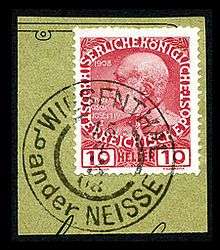
- Wigstadtl (Wigstadt): Vítkov S,7
- Wihorschau: Běhařov
- Wikan: Vykan
- Wiklitz: to be identified B,2
- Wildberg (also: Kamenik, Kamaik; near Wolletschlag): Kamýk (Volovice)
- Wildenschwert: Ústí nad Orlicí B,43
- Wildschütz in Böhmen: to be identified B,91
- Wildschütz (in Schlesien): to be identified S,3
- Wildstein: Skalná B,17 (until 1950: Vildštejn)
- Wilhelmschlag: Vilémovice
- Wilhorschen (also: Wilhořen, near Christelschlag): Hlásná Lhota
- Wilimow (earlier: Willimow): Vilimov B,13
- Willenz: Bílenec M,10 (Vilanec)
- Willimow: Vilémov
- Willimowitz: Vilémovice
- Willomitz (Wilomnitz): Vilémov (Chomutov District) (Vilémov u Kadaně) B,29
- Wilschtberg (Berg): Vlhošť
- Winar a.d. Böhm. Nord-Bahn: Vinor na Ces. Sev. Draze B,32
- Winau: Zbinohy (Unanov) M,34
- Windig Jenikau: Větrný Jeníkov B,15
- Windisch Kamnitz: Srbská Kamenice B,90
- Winitz: Vynezda, also: Vinice
- Winkelsdorf: Kouty nad Desnou
- Winney: Vinné
- Winterberg: Vimperk (Vimberk) B,66
- Wirbelstein (Berg): Meluzína
- Wirbka: Vrbka
- Wirschenitz, Wirenitz (also: Zwerenitz, Werenitz, near Repeschin): Zvěřenice
- Wischau: Vyškov M,33
- Wischenau: (Visnova) Višňové (Znojmo District) M,12
- Wiskitna: Vyskytná B,59
- Wisowitz: Vizovice M,9
- Wissek in Mähren: Vísky (Blansko District) M,2
- Wisterschan: Bystřany
- Witanua (Wittanau): Vítanov B,83
- Witkowitz bei Starkenbach: (earlier: Vitkovice u Jilemnice)) Vítkovice B,83
- Witkowitz in Mähren: Vítkovice M,15
- Witosess: Bitozeves
- Wittingau: Třeboň B,93
- Wittinghausen: Vítkùv kámen
- Wittingsreith: Vítkov
- Wlachowitz: Vlachovice M,29
- Wladislau: Vladislav (Třebíč District) page to be recreated M,28
- Wlaschim: Vlašim B,3
- Wlkosch-Kanowsko: Vlkoš u Přerova (in 1899: Vlkos Kanovsko) M,22
- Wockendorf: to be identified S,4
- Wodlochowitz: Odlochovice B,79
- Wodnan (before 1899: Wodnian): Vodňany B,61
- Wodolka: Odolena Voda (earlier: Vodolka) B,32
- Wöhr: Ostrov
- Wölfling: Vlčí
- Wölking: Dolní Bolíkov (earlier: Bolíkov) M,4
- Wölmsdorf: to be identified B,77
- Wörles: Ostrov
- Wohar: Ohaře
- Wohlau: Volyně
- Wohlehraditz: Boleradice
- Wohontsch (an der Biela): Ohníč (nad Bílinou)
- Wohrazenitz: Ohrazenice
- Woiden: Vojtin
- Woisetschlag (part of Kaltenbrunn): Borsikov
- Wojna Mestetz (Wojno Miestetz): Vojnův Městec B,11
- Wojslawitz (near Hostinec): Vojslavice (Hoštíc)
- Woken bei Hirschberg: Okna
- Wokrauhlík: Mělník
- Woldrichow: Oldřichov
- Wolenitz: Volenice
- Wolepschitz: Volevčice
- Woleschna: Olešná
- Wolfersdorf bei Plan: Olbramov
- Wolfersdorf (bei Böhmisch Leipa): Volfartice B,7
- Wolframitz: Olbramovice u Moravského Krumlova M,12
- Wolframitzkirchen: to be identified M,34
- Wolframs bei Iglau: to be identified M,10
- Wolfsau: Svinná
- Wolfschlag (near Schöbersdorf): Vojslavy
- Wolfsgrub: Vlčí Jámy
- Wolfsgrub (Wolfshäuser) (near Christianberg): Vlčí Jámy
- Wolfsthal: Vlčí Důl
- Wolin: Volyně B,84
- Wollein: Merin M,7
- Wollenitz: Volenice B,84
- Wolletschlag: Volovice
- Wolluben, Bez. Krumau: Boly
- Wolschan: Olšany B,84
- Wolschen: Olšina
- Wolta: Voletiny
- Wondrak´s Viertel: Vondáková Čtvrt Svobodníku
- Wondrichow: Oldřichov
- Wonschamühle: Vonsovský Mlyn
- Wonschow: Onšov
- Wonschowitz: Onšovice
- Woparan (earlier: Woporan, Woporschan): Opařany (earlier: Oporany) B,52
- Woraschne: Dvorečná
- Woratschen: Oráčov B,64
- Worlik: Orlík nad Vltavou B,61
- Worlitschka: to be identified B,43
- Worowitz: Borovice
- Wosek: Oseky
- Wossek bei Rokitzan: Osek (Rokycany District) B,73
- Wosseletz (Woseletz, Wosoletz or Wassenbach): Oselce (in old Czech: Oselec) B,84
- Wossow: Vosov B,25
- Wostitz: Vlasatice M,20
- Wostraschin (Wostratschin): Osvračín
- Wostromier (before 1894: Vostromer): Ostroměř B,37
- Wostrow: Ostrov
- Wotitz (before 1867: Wottitz): Votice B,79
- Wottawa: Otava (river)
- Wottin: Otín (Žďár nad Sázavou District)
- Wran an der Moldau: Vrané nad Vltavou B,82
- Wrana bei Perutz (before 1898: Wrana; also: Wranna): Vraný (earlier: Vrane v Cechach) B,76
- Wranowa: Vranov
- Wrasch: Vráž u Písku
- Wratzau (near Haag): Vracov (Zahradka)
- Wrbatek (Weidenbusch): Vrbatky M,23
- Wrbno (Weiden über Walde): Vrbno nad Lesy B,44
- Wrchhaben: Vrchovany
- Wrtschen: Vrčeň B,67
- Wrzessin: Vřesina
- Wschechowitz: Vsechovice M,9
- Wschechrom: Všechromy
- Wschejan: Všejany
- Wschelis: Velké Všelisy
- Wscherau: Všeruby u Plzně B,50
- Wschestar: Všestary (Hradec Králové District) B,37
- Wschetat: Všetaty
- Wschetul: Vsetuly M,9
- Wsetin: Vsetín M,31
- Wtelno: Mělnické Vtelno
- Würbenthal: Vrbno pod Pradědem S,4
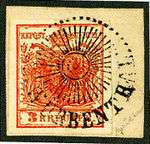
- Wühr: Vír
- Wüstpohlom: Pustá Polom S,8
- Wüst Seibersdorf (Wüstseibersdorf): Pusté Žibřidovice M,25
- Wullachen: Bolechy
- Wunderfichte: Rendezvous
- Wuretzhöfen: Březí
- Wurzelsdorf: Kořenov
- Wurzmes: to be identified B,36
- Wusleben: Bohuslav
- Wustung: Poustka
- Wutschko (near Haag): Bockov
- Wuttau: Butov
- Wyharzan: Beharov
- Wysoka: Vysoká (Mělník District) B,49
X
- Xaverhof: Xaverov
Z
- Zaap: Zápy
- Zabor: to be identified B,42
- Zabreh (bei Schönbrunn): Zabreh u Svinova M,15
- Zahlenitz: Zahlenice M,9
- Zahne: Saň
- Zahradka: Zahrádka (Plzeň-North District) B,45
- Zahrob: Záhrobí
- Zaisa: Čížov
- Zakolan: Zákolany B,82
- Zaluzan: Zaluzany B,61
- Zamlekau: Zamlekov B,34
- Zamrsk: to be identified B,24
- Zaroschitz (also: Scharoschitz): Žarošice M,5
- Zaschau: to be identified M,31
- Zasmuk: Zásmuky B,35
- Zauchtel (an der Oder): Suchdol nad Odrou M,19
- Zauchtenthal: Suchdol nad Odrou
- Zauditz: Sudice
- Zaunfeld: Plotiště nad Labem
- Zawada: Závada
- Zawobřesk: Žabovřesky[15]
- Zbeschau bei Segengottes: (Zbýšov u Oslavan) (Zbejsov u Boziho Pozehnani) Zbýšov M,3
- Zbirow: Zbiroh B,73
- Zborow, Sborau: Zborovy
- Zborowitz: Zborovice M,11
- Zbraslau (in Mähren): to be identified M,7
- Zbraslawitz: Zbraslavice B,42
- Zdaslav: Zdeslav
- Zdechowitz: Zdechovice (Pardubice District) B,58
- Zdenitz: Zdenice
- Zdiby: to be identified B,32
- Zdiaretz (Zdaretz): Žďárec M,27
- Zdiretz: Ždírec nad Doubravou B,11
- Zdislawitz (bei Wlaschim): to be identified B,3
- Zditz: Zdice B,25

- Zdounek: Zdounky M,11
- Zebau: Cebiv B,88
- Zebrak: to be identified B,25
- Zebus: Chcebuz
- Zehun: Žehuň B,63
- Zeidler: to be identified B,77
- Zeidlweid: Brtná
- Zeislitz (near Rabitz): Cejsice, also Cejslice
- Zellechowitz bei Zlin: Želechovice nad Dřevnicí (earlier: u Zlina) M,9
- Zelzerthal: Úhlavské Údolí
- Zernov: Žernov
- Zemschen: Třemešné
- Zerawitz: Žeravice M,5
- Zernowitz: Žernovice
- Zetoras: Cetoraz B,59
- Zettl: Sedlo
- Zettlitz: to be identified B,31
- Zettwing: Cetvíny
- Zhor: to be identified M,10
- Zichlern (near Schöbersdorf): Techlov
- Zichrass (Ziehras) (part of Gerbetschlag): Těchoraz
- Ziebetschlag (hamlet near Obergallitsch): Pribyslavov
- Zieditz: Citice B,18
- Ziegenbock (castle) (Waldschloss): Kozel (Zamek) (in Šťáhlavy)
- Ziegenruck: Cimruky, Kozi Hřbet
- Ziegenschacht: Stráň
- Zihobetz: Zihobec ? B,78
- Zinkau (earlier: Schinkau?): Žinkovy B,67
- Zinnwald: Cínovec (part of Dubí) B,89
- Zirnau: Dříteň B,10
- Zirnetschlag: Bělá
- Zistl (village near Hoschlowitz): Dobrné
- Zizelitz: Žiželice (Louny District) B,55
- Zizkov bei Prag: Žižkov (earlier: Zizkov u Prahy) B,94
- Zlabings: Slavonice M,4
- Zleb: Žleby B,13
- Zlin: Zlín (from 1949 to 1990 Gottwaldov) M,30
- Zliw (Sliw): Zliv B,10
- Zlonitz (Slonitz): Zlonice B,76
- Znaim: Znojmo M,34

- Znorow (Wnorau): Vnorovy (before 1924: Znorovy) M,30
- Zottig: Dívčí Hrad
- Zodl: Sádlno (Sádlná)
- Zöptau: Sobotín M,25
- Zossen (in Oe. Schlesien): Sosnová S,4
- Zosum (part of Bergreichenstein): Žďánov
- Zruc: to be identified B,45
- Zubri: to be identified M,31
- Zuckenstein: Cuknstejn
- Zuckerhandl: Suchohrdly
- Zuckmantel (earlier also: Edelstadt): Zlaté Hory v Jeseníkách (earlier: Cukmantl) / Žďárek S,3
- Zuckmantel bei Teplitz: to be identified B,89
- Zuderschlag: Cudrovice
- Zumberg: to be identified B,12
- Zürau: Siřem
- Zulb: Slup (earlier: Cule)
- Zwarmetschlag: Svatomírov
- Zweihäuser: Dvojdomi
- Zwerenitz: Zvěřenice
- Zwestow: Zvestov B,79
- Zwickau (in Böhmen): Cvikov B,20
- Zwickowitz (Zwikowetz, Swikowetz): Zvíkovec B,73
- Zwittau: Svitavy M,16
- Zwitte: Svitava
- Zwittebach (river): Svitávka
- Zwittermühl: Háje
- Zwittern (hamlet near Obergallitsch): Svitanov
- Zwoischen: Svojše
- Zwodau: Svatava
- Zwug: Zbůch
See also
| Wikimedia Commons has media related to Postmarks of the Czech Republic. |
References
- 1 2 3 Wilhelm Klein, Die postalischen Abstempelungen auf den österreichischen Postwertzeichen-Ausgaben 1867, 1883 und 1890, published in 1967 in Die politische Gliederung der österreichischen Reichshälfte
- ↑ Klein 1967, page 18
- ↑ Sprachenverordnungen - Erlass vom 2. April 1871 - Amtliche Einführung doppelsprachiger Stempel (Klein - Chronologisch übersicht )
- 1 2 See the Talk page for more explanations.
- ↑ Based on Freiwaldau only. To be further analyzed.
- ↑ Wilhelm Hoffmann, Encyklopädie der Erd-, Völker- und Staatenkunde (1866)
- ↑ See Mapy.Cz: http://www.mapy.cz/s/9KHM
- ↑ See Mapy.Cz: http://www.mapy.cz/#!x=14.346029&y=49.000991&z=13&l=5&t=s&d=ward_13236_1
- ↑ See Mapy.Cz: http://www.mapy.cz/#!x=14.333270&y=48.981739&z=12&l=5&t=s&d=muni_244_1
- ↑ See Mapy.Cz:http://www.mapy.cz/s/9KzO
- ↑ See Mapy.Cz: http://www.mapy.cz/#!x=14.507851&y=48.878398&z=13&l=5&d=ward_9635_1&t=s
- ↑ See Mapy.Cz: http://www.mapy.cz/s/9SZj
- ↑ See historical map at Mapy.Cz: http://www.mapy.cz/#!x=14.107473&y=49.144690&z=13&l=5&t=s&d=addr_9940619_1
- ↑ See Map.Cz: http://www.mapy.cz/#!x=14.574374&y=48.838300&z=13&l=5&d=ward_7163_1&t=s&q=%25C4%258D%25C3%25A1st%2520obce%2520Todn%25C4%259B%252C%2520Trhov%25C3%25A9%2520Sviny&qp=14.483906_48.836204_14.575673_48.878031_12
- ↑ See Mapy.Cz: http://www.mapy.cz/#!x=14.360538&y=49.003987&z=12&l=5&t=s&d=muni_635_1
External links of Interest
- Old Maps of the region with names
- GEOGRAPHISCHE NAMEN IN DEN BÖHMISCHEN LÄNDERN, ein Online-Wörterbuch von Walter Sperling
in Zusammenarbeit mit dem Collegium Carolinum (recommended)
- http://www.austriahungary.info/en/gazetteer1900/index.ne.html/ The early 1900s gazetteer of Austria-Hungary